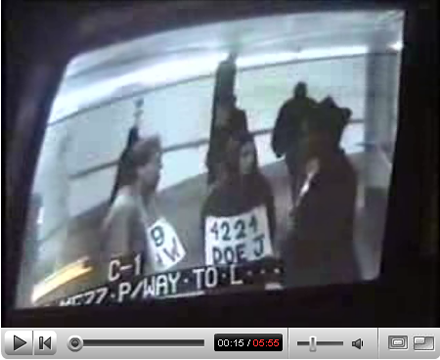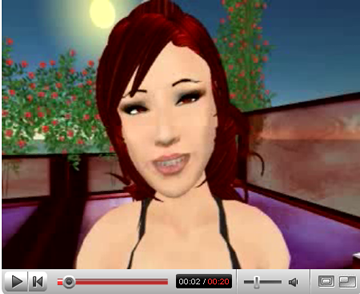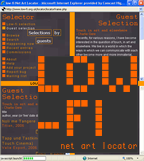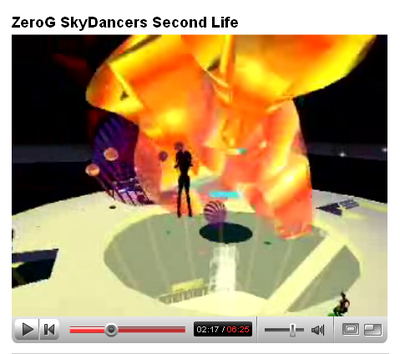« November 2006 | Main | January 2007 »
December 29, 2006
Digital Art Weeks Festival 2007
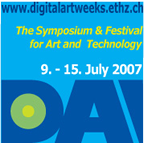
CALL FOR PARTICIPATION
Digital Art Weeks Festival 2007 (DAW07) :: CALL FOR PARTICIPATION :: July 9 - July 14, 2007 :: ETH Zurich, Zurich, Switzerland :: daw-info[at]inf.ethz.ch
The Digital Art Weeks is concerned with the application of digital technology in the arts. It consists of a symposium, workshops, and performances. The program offers insight into current research and innovations in art and technology. Artists and researchers will examine the use of electronic media in articulating the performer's presence through the possibilities of the multi-sensuality of electronic media. The possibility of blurring the divide between public and performer to bond them through the powers of dissemination and inclusion inherent within the technology used will also be considered. The organizers of the Digital Art Weeks at ETH Zurich seek papers, posters, and performances on themes specific to performance using electronic media. We seek proposals that explore a concept of the Performative Surround in terms of how computer-mediated communication and dialog takes place between performers and viewers and how it tends to aid in dissolving the divide between performer and viewer.
PERFORMANCES topics include:
* Media Enhanced Artwork in the areas of Performance, Dance and Sound-Art
* Mobile Art & Music that explore Performer Networking and Audience Participation
* Digital Puppetry including Enhanced, Waldo, Motion Capture, and Machinima
* Laptop Music including Live-Coding, Live-Cinema & Live-Re-Scoring
* Installations involving Net-poetry computer mediated communication
PAPERS, POSTERS and DEMONSTRATIONS topics include:
* Current Research and Innovations in Media Enhanced Artwork and Technology
* Issues Concerning the Live-Electronic Re-Embodiment of the Performance Artist
* Approaches to Performer Networking and Audience Participation using Technology
* Technology and Aesthetics of Digital Puppetry
* Approaches to Live-Coding, Live-Cinema & Live-Re-Scoring
* Novel Software Paradigms for Mixed-Media Processing and Authoring
PANEL topics include:
* Software Innovations in Mediated Communication and the Arts
* Live Cinema, Expanded Video, and Film Rescoring
* Immersive Audio and Video Space
* The Dissolve of the Performer-Audience Divide
* Networking the Private Space-Pubic Space Divide
* Digital Puppetry from Enhanced to Machinima
Submission guidelines.
Posted by jo at 03:06 PM | Comments (0)
Networked Proximity - Section 1
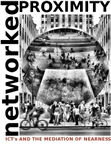
Networks as Metaphors and Models
"Networks have become a powerful metaphor for explaining the social realities of our times. A network, defined minimally, is a system of interconnected elements or nodes, where each node represents an intersection of flows within the network. Everywhere we look there are attempts to explain all kinds of social formations in terms of networks: citizen networks, corporate networks, gamer networks, terrorist networks, learning networks, networks of production, networks of distribution... and so on. The metaphor of the network can be superimposed over just about any form of multiplicity, including non-social ones (for instance, cells in the brain can be described in terms of a network). For the purposes of this study, however, every reference to networks, unless otherwise specified, is meant to allude to technosocial assemblages in which ICT’s facilitate social relations between humans unconstrained by the physical distance between them. If Cognitive Science attempted to explain individual consciousness by adopting the metaphor of the brain as a computer, with its inputs and outputs, Social Science is extending the metaphor a step further by attempting to explain the social in terms of networks—or, in this context, sets of interconnected computers/brains." Continue reading Networked Proximity - Section 1 by Ulises Ali Mejias. Also see Networked Proximity - Introduction.
Posted by jo at 11:49 AM | Comments (0)
back to the future

The Walter Ong Collection
John Walter, a graduate student at St. Louis University wrote to the TechRet list the other day to announce the launch of the Walter Ong Collection, a digital archive based at the SLU. I went to the site and downloaded a PDF of an early version of one of Ong's more famous essays, "The Writer's Audience Is Always a Fiction." In this particular essay, Ong who made his name analyzing the difference between oral and written communication, explores how this shift changed the role of the reader. Ong makes the case that the role of the reader is quite different than the role of the "listener" in oral communication.
"The orator has before him an audience which is a true audience, a collectivity. 'Audience" is a collective noun. There is no such collective noun for readers, nor so far as I am able to puzzle out, can there be. "Readers" is a plural. For readers do not form a collectivity acting here and now on one another, and on the one speaking to them, as members of an audience do."
What's so interesting here, is that it seems that the age of networked reading and writing promises to get us much closer to one of the crucial aspects of oral culture — the sense that the story teller/author and the audience/reader are joined together in a collective enterprise where the actions of each will have a direct and noticeable impact on the other. [posted by bob stein on Future of the Book]
Posted by jo at 11:34 AM | Comments (0)
ALL SIMS CONSIDERED
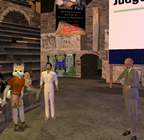
"Visiting the 'Second Life' World: Virtual Hype?"
I made a brief appearance on yesterday's "All Things Considered" from National Public Radio, in a story appropriately titled: "Visiting the 'Second Life' World: Virtual Hype?" (Yes, NPR has joined that particular debate, following Clay Shirky in casting deep skepticism on the "two million Residents" meme that the media is usually complicit in. But not this time.) Nicely reported by Laura Sydell, the segment actually devotes most of its coverage to Judge Posner's recent in-world appearance, and his Honor himself arrives to offer some trenchant thoughts on the importance of online worlds. Last year's NWN book club guest Thomas P.M. Barnett also shows up to praise the longtail power of his own appearance in-world. (Forseti Svarog of The Electric Sheep is on hand, too.) Taken together, it almost plays like an audio version of my GigaGamez essay on the hype and hope around Second Life.
Also, the raccoon. Fittingly, the raccoon lawyer shows up first. Listen to it all here. [blogged by W. James Au on New World Notes]
Posted by jo at 11:28 AM | Comments (0)
Surveillance Camera Players: 1984
"The Surveillance Camera Players are not watching you. They are watching the cameras, because we have forgotten to. The cameras can't understand what the SCP are doing, but we can. The cameras don't smile but you might." — Greil Marcus, author of "Lipstick Traces."
Posted by jo at 11:03 AM | Comments (0)
A frock with a mind of its own
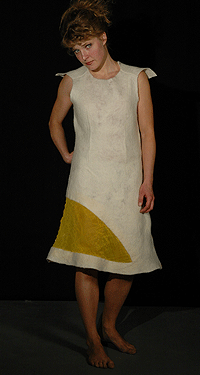
Surrendering Control
A dress with animated flowers on its neckline, shirt sleeves that make sounds in tune with your body language, and a hemline with a mind of its own have been developed by a Canadian researcher. Professor Joanna Berzowska and international colleagues will discuss these and other examples of ‘wearable technology’ at a workshop in Australia next year called reSkin.
Berzowska’s flowery dress, named Kukkia, has a neckline with felt and silk flowers that open and close according to a special electronics embedded in the dress. “I really wanted to make these dresses that have personalities, that move and behave almost like animals,” says Berzowska, who teaches computation art at Concordia University in Montreal.
The flower petals are made of silk and felt, and contain thin wires of Nitinol, an alloy of nickel and titanium. Nitinol is a ’shape memory alloy’, which can be programmed to have different shapes at different temperatures.
When the wire heats it shrinks and pulls the petals together, closing the flower. As it cools down, the wire relaxes and the petals open. A custom electronics board is connected by embroidered conductive thread to the flowers and makes each one open and close every 15 seconds. The system is run on rechargeable lithium polymer batteries, originally designed for use in model aeroplanes, which are embedded in pouches in the dress.
Another dress with a mind of its own is Vilkas, which has a hemline that goes up and down on its own. We tend to think of consumer electronics as something we can control. But Berzowska says once you turn on the microcontroller in these dresses, you have to surrender control.
“I like how perverse it is to have a piece of wearable electronics that you can’t control,” she says.
“Perhaps they don’t do what you want them to do and they behave in unexpected ways on your body. Maybe they move at inappropriate times.”
Musical pants and sound sleeves
Berzowska also has musical clothes including musical pants that make a sound every time you take a step. “As you’re walking through public space you can leave a whole trail of sounds behind you based on how you’re walking,” she says. She also has ’sound sleeves’ that produce different sounds to reflect the wearer’s body language.
The sleeves produce a higher frequency sound the harder you squeeze your arms together. If someone is feeling angry or threatened they cross their arms causing the sleeves to generated an almost painfully high pitch. “But when you relax your arms the pitch goes down,” says Berzowska. “It almost sounds like a cat purring.”
Intimate memories
Berzowska has another outfit called Intimate Memory that record acts of physical intimacy using a microphone and a series of light-emitting diodes (LEDs) stitched in a curved line across the front.
The LEDs light up when someone touches the skirt, whispers something in the ear of the wearer, or blows on their neck. “The number of lights represents the intensity of the intimacy event similar to the volume indicator on a stereo,” says Berzowska. “Over time, the lights turn off, one by one, to show time elapsed since the event took place.” [posted by regine on twenty1f]
Posted by jo at 10:52 AM | Comments (0)
LAb[au]
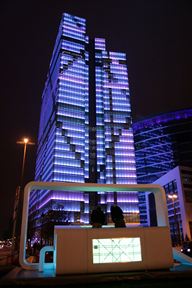
Touching the Dexia Tower
LAb[au] is happy to announce you its new urban interactive installation Touch on the Dexia Tower and Place Rogier in Brussels, Belgium. The project takes as a starting point Brussels 145 m high Dexia Tower, from which 4200 windows can be individually colour-enlightened by RGB-led bars, turning the faade into an immense display.
Instead of considering this infrastructure as a flat screen (surface) displaying pre-rendered video loops, the project is working on the architectural characteristics of the tower and its urban context. The characteristics of the building; orientation, volume, scale... are used as parameters to set up a spatial, temporal and luminous concept, which moreover allows people to directly interact with the tower.
On Place Rogier, at the bottom of the tower, a station is mounted where people can interact either individually or collectively with the tower through a multi touch screen. Both static (touch) as dynamic input (gesture) is recognized to generate an elementary graphical language of points, lines and surfaces combined with physical behaviours (growth, weight, ...) taking a monochromatic colour palette (background) combined with black and white (graphical elements).
Once a composition is created, it can be sent as an electronic postcard with a snapshot from the tower, taken from a distant location. It is also uploaded on the specific project website ( www.dexia-tower.com ) where people can retrieve their postcard, as electronic and printable format, with Christmas and New Years wishes from Brussels.
The design of the interactive station, as the project in general, is based on the idea of folding and unfolding space. This process allows the spatial design to be combined with time-based parameters, inherent to the dynamic and sequential concept of the interactive enlightening of the tower itself.
Embodied by three parts, the station is placed on Brussels North-South axis in front of the Dexia Tower. The first fold allows people to interact on a multi-touch-screen, the second fold directly displays the user interaction - finger drawing - on a projection screen. In this manner the station not only establishes a direct relation to the visual and luminous display of the tower but also shows the passers by the ongoing process of user interaction.
The interaction is constituted by both static and dynamic input, taking in account certain parameters such as width ( finger, hand, arm, .. ) , direction ( horizontal, vertical, diagonal ), duration ( introducing growth ), speed ( introducing velocity and weight ), to establish a dynamic, abstract play of graphical elements deduced from the architecture. Each of the inputs defines the colour of the background the architecture will change towards ( coordinate to colour map ), while its direction ( positive or negative ) defines the colour of the graphical element evoked ( white or black ).
The touch screen allows multiple inputs and thus allows on the one hand, people to interact with more than 1 finger, and on the other hand, to interact together, extending individual interaction to a collective experience. This real-time and collective interaction on an urban scale, transforms the Dexia Tower into a new Brussels landmark which presents art to the city.
Posted by jo at 10:28 AM | Comments (0)
December 28, 2006
Rapt in a fine Web of interactive art
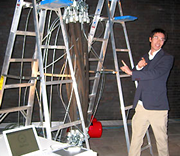
Internet-based exhibition is a virtual stunner
"Looking at art on the Internet can't compare to seeing it in person, but what if the art is Internet-based? The Boston group Turbulence has been promoting Internet art for a decade; it sponsors New England Initiative, a competition that awards a commission and an exhibition in real space, as well as on the Web.
"New England Initiative II" can be seen live at Art Interactive, and that's still the best way to view it. You can also check it out virtually at turbulence.org/ne2/awards.html.
The three works are bigger and more engrossing in the gallery than they are on a personal computer. This is particularly true of John Snavely's "WhoWhatWhenAir," a giant tangle of pneumatic valves that looks like a squid with 16 left feet; it can't move without tripping over itself. Each of those long, black tubular valves, ordinarily used in industrial settings, can pull up to a ton. The viewer -- either in the gallery or remotely from home -- can control the way in which the valves expand and contract, and choreograph the sculpture's movements..." Continue reading Rapt in a fine Web of interactive art: Internet-based exhibition is a virtual stunner by Cate McQuaid, Globe Correspondent, December 28, 2006.
Posted by jo at 01:50 PM | Comments (0)
Little Feet Bureau LLC
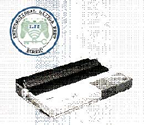
Paranoid dot-matrix printers
Little Feet Bureau LLC is a Kafkaesque corporation named after Mao-Zedong's army of gossipy old ladies recruited to eavesdrop and rat on potential enemies of the state.
From the press release: Four paranoid dot-matrix printers output endless text on paper. The system combs internet traffic looking for people linked to "dangerous information". Every time a machine finds keywords that seem to threaten the stability of a client government, it crafts an individualized letter addressed to the offender. Sometimes, the letter accuses and threatens legal action. At other times, it summons the offender "in for questioning." All letters warn of the legal consequences of telling anyone the letter they are reading exists at all.
Each printer focuses on its own area of surveillance. By studying a given machine, a pattern emerges-- a pattern of paranoia. In its obsession to uncover hidden meaning, it will, invariably, confirm its own fears.
The piece attempts to situate itself at both extremes of the privacy/surveillance debate. One little foot is firmly planted in the hysteria of paranoia and conspiracy theory while the other is just as firmly rooted in the land of denial where benevolent governments "try the best they can"-- with only the public good and safety in mind. Where the thought, "it can't happen to me" still flows without repudiation.
"Three printers are connected to a data-surveillance system," told me Mushon Zer Aviv, one of the developers of the project. "Each printer is assigned to a different government and combs the same data-set in search for suspicious keywords, and so the Chinese printer searches for keywords like: falun gong falun dafa tibet tienamen square massacre freedom of speech human rights news western spy 007 free playboy ...
The American printer searches for keywords such as: terrorism terror suicide saddam chemical biological anti-american mexican illegal immigrationdodging Tax intelligent life-form ufo e.t. space visitor french...
Our 3rd printer is assigned to the WTO, a super power in it's own right: mayday socialist fair trade creative commons anarchist peer to peer hacker activist pollution anti-capitalism anti-global indimedia green no sweat free chavez squat...
We are hoping to include a 4th printer the next time we install little feet, this time for an ultra-liberal government not many people have heard of (since it's fictional), we will serve it it's own fears and paranoias... More. [blogged by Regine on we-make-money-not-art]
Posted by jo at 10:35 AM | Comments (0)
Mary Mattingly
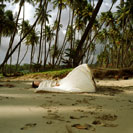
disturbing beauty
... ok, the threat by mobile phones (to which she refers) just recently has been dismissed as no longer relevant, but nevertheless there are interesting relations and a fantastic worldview to be discovered at Mary Mattingly’s project website. [link to Mary Mattingly: Second Nature – a text on M. Mattingly’s photography.]
She developes a scenario which emerges around a ‘disastrous beauty’ according to an imagination where our actual and eventual technological developments are brought together with to-come-ecological changes. It all together impresses through the beautiful set-up and the quite carefully lay-out of a world to be – combined with changes already happening… Some of her most impressing images relate to the imagination of ‘wearable homes’. In her writings she describes quite clearly the process of thought and procedure of her project development:
In the design of the Wearable Home, I examine the cohesive threads of cultures’ and groups’ clothing throughout the world; from Inuit cultures to saris in India, Muslim, Hindu, Zen Buddhist garments, American Gap, Banana Republic, the Khaki Overcoat, muslin design prototypes, construction uniforms, kimonos, Dockers, safari camouflage, military uniforms, the blandification and brandification of garments spanning cultures worldwide to make one, general look de-emphasizing self and re-emphasizing everything else (collaboration, ideas, survival, modularity, etc.). I think this, over time, is a creative way to think about the outcome of mega-mergers and the illusion of choice, technology and the idea of utopia, as well as wiki-run systems. The result, then, may be that one wearer would be indistinguishable from the other, thus greatly alleviating the threat of the end of privacy. Our distinguishing features would be greatly masked in this context to the naked eye, however the pervasiveness and scrutiny of high-powered networks would still catalog our movements and whereabouts. (link) [blogged by mo on mind the _GAP*?)
Posted by jo at 08:21 AM | Comments (0)
December 27, 2006
future of the filter
![]()
The "Corporatization" of User-Generated Content
An article by Jon Pareles in the Times (December 10th, 2006) brings to mind some points that have been risen here throughout the year. One, is the "corporatization" of user-generated content, the other is what to do with all the material resulting from the constant production/dialogue that is taking place on the Internet.
Pareles summarizes the acquisition of MySpace by Rupert's Murdoch's News Corporation and YouTube by Google with remarkable clarity:
What these two highly strategic companies spent more than $2 billion on is a couple of empty vessels: brand-named, centralized repositories for whatever their members decide to contribute.
As he puts it, this year will be remembered as the year in which old-line media, online media and millions of individual web users agreed. I wouldn't use the term "agreed," but they definitely came together as the media giants saw the financial possibilities of individual self-expression generated in the Web. As it usually happens with independent creative products, large amounts of the art originated in websites such as MySpace and YouTube, borrow freely and get distributed and promoted outside of the traditional for-profit mechanisms.
As Pareles says, "it's word of mouth that can reach the entire world." Nonetheless, the new acquisitions will bring a profit for some while the rest will supply material for free. But, problems arise when part of that production uses copyrighted material. While we have artists fighting immorally to extend copyright laws, we have Google paying copyright holders for material used in YouTube, but also fighting them.
The Internet has allowed for the democratization of creation and distribution, it has made the anonymous public while providing virtual meeting places for all groups of people. The flattening of the wax cylinder into a portable, engraved surface that produced sound when played with a needle, brought the music hall, the clubs and cabarets into the home, but it also gave rise to the entertainment business. Now the CD burner, the MP3, and online tools have brought the recording studio into the home. Interestingly enough, far from promoting isolation, the Internet has generated dialogue. YouTube is not a place for merely watching dubious videos; it is also a repository of individual reactions. Something similar is happening with film, photography and books. But, what to do with all that? Pareles sees the proliferation of blogs and the user-generated play lists as a sort of filter from which the media moguls are profiting: "Selection, a time-consuming job, has been outsourced. What's growing is the plentitude not just of user-generated content, but also of user-filtered content." But he adds, "Mouse-clicking individuals can be as tasteless, in the aggregate, as entertainment professionals." What is going to happen as private companies become the holders of those filters? [posted by sol gaitan on Future of the Book]
Posted by jo at 08:20 PM | Comments (0)
"Big games" and environmental space
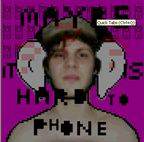
The Porous Border Between the Real and the Mediated
Parsing tons of papers, articles, documents and pdf that I accumulated in the last few months, I ran across this article in Vodafone’s Receiver: Big Games and the porous border between the real and the mediated by Frank Lantz.
In this short piece, the author describes what he means by “big games”, i.e. “Big Games are human-powered software for cities, life-size collaborative hallucinations, and serious fun“. Some excerpts I find pertinent regarding my research:
Imaginary places, constructed from code, are now being represented not just as pixel grid windows into synthetic 3D environments, but mapped onto the actual 3D environments in which we live. Called “Big Games”, these large-scale, real-world games occupy urban streets and other public spaces and combine the richness, complexity, and procedural depth of digital media with physical activity and face-to-face social interaction.
He then describes games such as ConqWest, Mogi Mogi, PacManhattan, Superstar, Can You See Me Now, Uncle Roy, Botfighters… And describes how the urge to use spatial environment as a playful space did not come out from the blue: children’s neighborhood games (like Red Rover, hide and go seek, and kickball or Capture the Flag), Assassin/Killer game, skateboarding and Parkour, location-based art activities of the late 20th century, Live action role-playing. And those activities share some common purposes:
a desire to push game experiences beyond traditional boundaries of time and space. But there is another, complementary desire within conventional computer and videogames themselves. Over the last 10 or 15 years, these games have developed a profound obsession with play dynamics of 3D spaces, architecture, and environments. (…) In some ways, Big Games are a natural extension of this obsession with environmental exploration and social dynamics as gameplay subjects.
The author hence describes how mobile and ubiquitous computing technologies are a catalyst for big games creation. And finally, his thought about spatial practices are very interesting:
There is no longer a clear, well-defined boundary between the virtual spaces and interactive systems of our digital experience and the concrete, tangible aspects of our physical experience. Even as high-resolution computer graphics make the simulated worlds inside our computers more realistic, the actual world outside our computers is behaving more and more like data.
(…)
Regardless of the technology with which they are implemented, Big Games reflect a change in perspective brought about by mobile, pervasive, and ubiquitous technologies. Even Big Games that use chalk on sidewalks to make a citywide puzzle, or appropriate the archaic technology of payphones to make a game of urban tactics, are made possible by a shift in how we perceive our environment brought about by the new relationship between space and computing. (…) Whatever else they are, these games are primarily about connecting people – a way to reclaim public space as a site for a new kind of shared experience.
Why do blog this? because it gives a very good summary of “big games”, which I am partly interested in my research (I use big games to study how people collaborate and use location-awareness features). On a different note, it seems that in the location-based/geowankin scene, the term “big” now receives more and more interest. See the “big here challenge” or how Fabien describes it (or even Matt Jone’s video!).
Finally, what the author stress in his conclusion (big games to reclaim public space), is exactly something Mauro and I wrote about three years ago in the following paper: To Live or To Master the city: the citizen dilemma or in this short pdf report I dropped on the web: Augmenting Guy Debord’s Dérive: Sustaining the Urban Change with Information Technology. The report only focuses on the use of LBS to foster new public space practices. [blogged by Nicolas on Pasta and Vinegar]
Posted by jo at 07:27 PM | Comments (0)
December 26, 2006
Thanks Regine Debatty
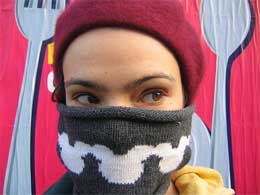
Support new media art
Call it new media art, interactive art, call it any way you like, just go, spend money and support the art we like. Here's my mini-list:
Turbulence because they've been consistently commissioning net.art for ten consecutive years and because they have a great blog called networked_performance that documents better (much better) than me the calls, essays and events that interest the whole new media art community. Net artists, activists and digital artists have been contributing books, DVDs, CDs, archival prints, T-Shirts and the kind of fancy little mask i'm proudly donning on the left of this post (because that's what matters to me today, really. Not net.art but something to cover up the spot on the chin i woke up with.) More >> [blogged by Regine on we-make-money-not-art] THANKS EVERYONE FOR GIVING US ANOTHER YEAR OF TURBULENCE!
Posted by jo at 07:45 PM | Comments (0)
LivesConnected
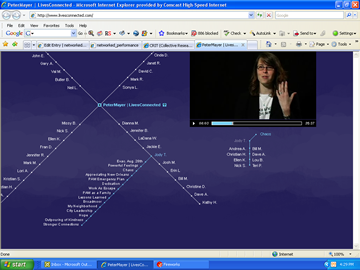
Hurricane Katrina and its Aftermath
LivesConnected, an interactive data visualization by Peter Mayer, was recently launched to coincide with the end of hurricane season (Nov. 30). It is an oral history repository documenting the experiences of Hurricane Katrina and its aftermath. The interface allows access to video narratives of 44 different people, and connects them by thematic associations.
Posted by jo at 04:35 PM | Comments (0)
Where Real Money Meets Virtual Reality

The Jury Is Still Out
[Image: Veronica Brown is able to make a living selling her digital fashions in the online world Second Life. Photo Credit: Linden Lab] Where Real Money Meets Virtual Reality, The Jury Is Still Out :: By Alan Sipress, Washington Post Staff Writer, Tuesday, December 26, 2006; A01.
Veronica Brown is a hot fashion designer, making a living off the virtual lingerie and formalwear she sells inside the online fantasy world Second Life. She expects to have earned about $60,000 this year from people who buy her digital garments to outfit their animated self-images in this fast-growing virtual community.
But Brown got an unnerving reminder last month of how tenuous her livelihood is when a rogue software program that copies animated objects appeared in Second Life. Scared that their handiwork could be cloned and sold by others, Brown and her fellow shopkeepers launched a general strike and briefly closed the electronic storefronts where they peddle digital furniture, automobiles, hairdos and other virtual wares.
"It was fear, fear of your effort being stolen,'' said Brown, 44, whose online alter ego, Simone Stern, trades under the name Simone! Design.
Brown has reopened her boutique but remains uncomfortably aware that the issue of whether she owns what she makes -- a fundamental right underpinning nearly all businesses -- is unresolved.
As virtual worlds proliferate across the Web, software designers and lawyers are straining to define property rights in this emerging digital realm. The debate over these rights extends far beyond the early computer games that pioneered virtual reality into the new frontiers of commerce.
"Courts are trying to figure out how to apply laws from real life, which we've grown accustomed to, to the new world," said Greg Lastowka, a professor at Rutgers School of Law at Camden in New Jersey. "The law is struggling to keep up."
U.S. courts have heard several cases involving virtual-world property rights but have yet to set a clear precedent clarifying whether people own the electronic goods they make, buy or accumulate in Second Life and other online landscapes. Also unclear is whether people have any claim when their real-life property is depicted online, for instance in Microsoft's new three-dimensional renderings of actual real estate.
The debate is assuming greater urgency as commerce gains pace in virtual reality. In Second Life, where nearly 2 million people have signed up to create their own characters and socialize with other digital beings, the virtual economy is booming, with total transactions in November reaching the equivalent of $20 million. Second Life's creator, Linden Lab, allows members to exchange the electronic currency they accumulate online with real U.S. dollars. Last month, people converted about $3 million at the Lindex currency market.
Second Life's economy has been surging since Linden Lab made the unusual decision three years ago to grant users intellectual property rights for what they create with the Web site's free software tools. Thousands of people have created homes and businesses on virtual land leased from the site and are peddling virtual items as varied as yachts and ice cream.
Congress has taken note and is completing a study of whether income in the virtual economy, such as from the sale of gowns that Brown makes, should be taxed by the Internal Revenue Service. The Joint Economic Committee of Congress is expected to issue its findings early next year.
"There seems to be a lack of ground rules in an area that would have explosive growth in the next decade or two," said Christopher Frenze, the committee's executive director.
Though she grew up watching her mother at the sewing machine, learning the craft with each loving stitch of the family's clothes, Brown never considered making it a career until two years ago, when she entered Second Life. Within days, she studied up on the basic software skills and began designing virtual women's apparel from her home in Indiana. "When I design," she said, "I think about how the cloth falls and the sheen silk has compared to satin." She said she now spends 70 hours a week on her trade. Starting with four original outfits, she now offers 1,200 designs and has also moved into men's fashion.
But the rogue program, called a copybot, that appeared last month in Second Life underscored the need to clarify her property rights. After the attack, Linden Lab announced efforts to ban the program and encouraged users to report abuses. Some users argued that even stronger property protections were needed.
"I'm feeling uncomfortable," Brown admitted. "I'm safe for now, but it's very tentative."
Linden Lab made cyber-history when it gave Second Life users the intellectual property rights to their creations -- similar to the copyright real-world authors have to their writings. By contrast, most Web sites offering virtual experiences have not accorded users any property rights, requiring them to accept a license agreement stating that all content belongs solely to the Web site owner.
Four years ago, several online gaming veterans tried to get around this agreement and make real money by selling game items from Dark Age of Camelot on eBay and at specialty online auctions. The items, which included weapons, armor and specialized characters, in some cases went for more than $300 each. The developers of the Camelot game blocked them. When the gaming veterans sued, claiming that they had rights to the items they acquired in the game, a federal court in California ruled against them on the grounds that the license agreement took precedence. Other recent U.S. court rulings in virtual disputes have come to similar conclusions.
But judges elsewhere have taken a different view. A Chinese player in the Korean-made online game Mir 3 claimed that his personal rights had been violated when the game's local Chinese operators deleted the magic sword he used to battle virtual villains. The operators claimed it had been illegally duplicated from an original. The player filed suit, contending that he had bought the magic sword in good faith and that it was worth about $120. A Chinese court in Xuhui district ruled against the game's operators, essentially finding that the player's property rights were paramount.
In Second Life, Linden Lab executives wanted to avoid this confusion, believing that users needed clear ownership for economic activity to thrive, recounted Cory Ondrejka, chief technical officer. Otherwise, users would have little incentive to invest.
But he stressed that this ownership did not extend to full property rights -- creators have intellectual property rights to the software patterns used in making virtual objects but no rights to the objects themselves. Under this formulation, Brown owns her designs but not the individual dresses and pieces of underwear. Nor do her customers "own" the apparel they purchase and hang in their virtual closets.
"Everything in the virtual world is intellectual property, as much as it looks like property or as much as property is a useful metaphor,'' Ondrejka said. "Copying it is not theft. It's infringement, but it's not theft.''
But Joshua Fairfield, a professor at Indiana University School of Law, said there's more to online rights than just intellectual property. He said there are legal reasons to believe that property rights to objects can exist in a virtual realm, but no U.S. court has affirmed the concept.
Earlier this month, U.S. Circuit Judge Richard A. Posner visited Second Life, appearing as a balding, bespectacled cartoon rendering of himself, and addressed a crowd of other animated characters on a range of legal issues, including property rights in virtual reality. Posner stressed that it was in Linden Lab's interest to ensure due process and other rights.
"They want people to invest in Second Life, and we know people won't invest if their rights are not reasonably secure," he told the audience, which included a giant chipmunk and several supermodels. He went on to predict the eventual emergence of an "international law of virtual worlds" similar to international maritime law.
Meanwhile, as mapping technologies rapidly improve, companies are increasingly able to transfer the real world to the online world. But are property rights any clearer in such a "real" virtual world?
Microsoft, for instance, launched an online service last month called Virtual Earth that features highly detailed three-dimensional photographic maps of American cities. Microsoft plans to make money by selling advertising billboards in this virtual depiction of urban America.
But the company's lawyers and advertising executives are still grappling with the question of whether those who own the property depicted in Microsoft's 3-D images have any control over how their depicted property is used online. For instance, does Federal Express have the right to object if an ad for its competitor DHL is posted in the parking lot at virtual FedEx Field?
"We haven't fully delineated all the guidelines for do's and don'ts,'' said Bobby Figueroa, a director of product management at Microsoft.
Posted by jo at 04:20 PM | Comments (0)
netPong
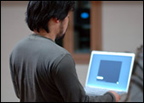
Playing Pong walking with a laptop
"The tilting sensor embedded in some of the latest Apple laptops has induced many projects focused on experimenting new interaction methods. netPong by Oriol Ferrer Mesià, is a software that allows to play Pong physically tilting the computer to control the paddle. Playing alone is the basic possibility, but it's decidedly funnier to play with another likewise equipped opponent in a local network, moving around the room with the laptop firm in the hands. The laptop itsellf is then transformed in a control device. But there's no external visible sign of that: its whole hardware seem the same but acts differently, and its complexity and multi-purposing are re-shaped on-the-fly by the software. A 21st century laptop is then used as a minimal analogue paddle from the late seventies and its 'mobility' attitude is not anymore related to the place of working but it is then emodied by the machine, exploited to play. The (universal) pong paradigm, as already investigated in the Pong Mythos exhibition, is based on essential rules being also able to instinctively activate our ancestral playing instincts. And a laptop game that have to be played walking here and there is something precious for our physical and mental health." Neural.
Posted by jo at 10:45 AM | Comments (0)
Ballonnenveld
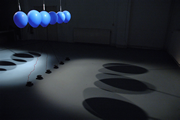
Sounding Balloons
Ballonnenveld, an installation by Martijn Tellinga, displays a sounding and vibrating body of helium-filled balloons. The balloons function as resonance-chambers for a trimmed spectrum of sine-waves that are fed through strings, connecting the balloons with double-coned carspeaker-elements. Each balloon holds its own resonance-frequency that changes over time as a result of varying temperature in the space, amount of helium in the balloon (decreasing over time) and length of the string. Hitting the resonance-frequency the balloons start to get bumpy, as well as the connecting strings, clearly showing the waveshape of the soundsignal going through. This of course causes an acoustical process, perceiveable in the space. Carefully balancing the level between direct sound from the carspeaker-elements and the acoustical-qualities produced by the balloons, creates a musical mechanism that bridges between instrumental and electronic sonoroties and, gently directing the balloons, between acousmatic music and instrumental playing.
The balloons are also a switch in a feedback-loop and, because of their movement, affect the amount of pick-up from the microphones placed above. Each feedback-circle knows a number of breakouts to balloons solely functioning as resonance-chambers. Through pitchshifting, these balloons show slightly different colouring in sound and add to a slowly shifting and modulating body of tones and subtle timbral distortions that arise from the field of balloons. Ballonnenveld explores and visualizes the physicality of electronic sound, though succeeds very well to hold on to its magic and serenity through the particular acoustical behaviour of the installation, hopefully capturing the poetry of the physical process that is behind.
Ballonnenveld was developed in collaboration with Radboud Mens and Danny de Graan and with the support of STEIM and FAPK. [via]
Posted by jo at 10:34 AM | Comments (0)
John Cage Special - part ONE
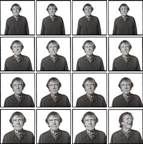
Continuous Stream of S O U N D for John Cage
John Cage Special - part ONE :: Continuous Stream of S O U N D for John Cage - non structure voyage acoustique avec armes et bagages (with bag and baggage) ... Duration 38'39
"I am trying to be unfamiliar with what I'm doing." - John Cage
voices : John Cage, Marshall McLuhan, George Koehler, Saba Tewelde (singer), Todd Weinstein, birds, cats, tv-voices, radio-voices, laughing, children voices, the composer
instruments: piano, prepared piano, percussion, cymbals, gurgle shells, timpani, trumpet, glockenspiel, bells, radio, tape collage fragments, triangle, turntable sounds (record scratch and crack), whistle, horns, toy robots, eggshells, gong, bowed gong, strings, soda bottles, double bass, bowed e-bass, dishes, church bells, acoustic feedback, subway sounds (new york city), tools, paper, machine sounds, audio tape transport sounds, electronics, cardboard tubes, software instruments (spongefork), xylophone, bowed umbrella, composer eating, composer walking, fingers, clapping, computer mouse, video cut up machine sounds, computer keyboard, trucks, cars, rain, edding writing sounds, applause, siren, ambient recordings (Frankfurt, New York, Zurich, Berlin), wind, water, echinocactus grusonii (Golden Barrel)
Poduced by musique trouve - frankfurt ... Recorded: March, April, September and November 2006 ... Copyright 2006 by Ralph Lichtensteiger [blogged on espace sonorite] [via]
Posted by jo at 10:02 AM | Comments (0)
CTRL-C

Copy-paste (net.)art
Last May, i blogged about Plagiarismo, an exhibition that tried to demonstrate that the appropriation and re-formulation of other artists' ideas is an essential component of culture.
Vuk Cosic - who's having a solo exhibition at the Škuc Gallery in Ljubljana- wrote me then that he was putting together a show called CTRL-C on a similar subject. The show has just opened at the galerija Simulaker in Slovenia. Here's the gist:
From Duchamp and Benjamin to Beuys the art of the previous century has asked the question of copying and multiplying as a legitimate artistic practice. The advent of the internet has dramatically placed the digital original and digital copy in the very center of artistic but also economic frictions.
Mere simplicity of making copies is socially not perceived as a liberating tool for artistic creation but is turning out to be the main point of conflict between economic interests and those of societies at large. Traditionalists fighting for Intellectual Property are trying to pull the giants from under our feet.
The CTRL-C show is presenting projects exclusively focused on the artistic relevance of the digital copy. Exhibited works are using the language of the non-original to express a very concrete critique of the circumstances in the world of art and in the society. All works in the show have provided their authors with a measure of scandal and a bigger measure of fame: More >> [blogged by Regine on we-make-money-not-art]
Posted by jo at 09:39 AM | Comments (0)
December 22, 2006
Rock Stars (And Proteins, Too)
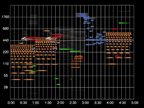
How two groups of scientists coax music from nature
"From Led Zeppelin to Wolf Parade, rock music owes a debt to science—and to the scientists whose fascination with sound art spurred them to create new noises. A Russian physicist named Leon Theremin developed the world's first electronic musical instrument: a box with antennae (appropriately called a "theremin") that used electric circuits to create a range of otherworldly sounds. Four decades later, in 1964, an engineering physics Ph.D. named Robert Moog invented the synthesizer that bears his name. Now, a new generation of scientists and musicians continue to push the frontiers of musical possibility.
Since 2003, Hungarian astrophysicist Zoltán Kolláth and composer Jenő Keuler have been working on what they call the "Stellar Music Project," using pulse patterns generated by stars to compose musical pieces..." Continue reading Rock Stars (And Proteins, Too) by Lydia Fong, Seed.
Posted by jo at 07:07 PM | Comments (0)
When Is a Smile Not a Smile?
Which Uncanny Valley Expo finalist captures the most human-like expression in an avatar? [via]
Posted by jo at 06:55 PM | Comments (0)
New World Notes

Gwyneth Llewelyn and the Kuurian Expedition
"...The analogy of “TV vs. theater” was thrown in for discussion— WoW and Everquest are more like TV, where the content is fed to the consumers. Second Life is more like a theatre, especially the ones presenting “interactive performances” where actors meet the public and there is a thin line separating both. Poinky comments: “It's a lot easier to watch TV thanto go a theatre.” This would explain the incredible commercial successes of WoW or EQ.
Interestingly enough, they tend to agree that you need some creativity to be able to enjoy SL.
Grace: “If you are not open to thinking creatively, SL might not be for you.” Frank and Poinky: “What I believe [is]we should define what is creative and what is naive creativity... Here everyone makes different fashions or architectures, by just right-clicking on the target, [hitting] a few buttons, and then move on, but it does not mean they are all interesting because they are original.” ..." From Gwyneth Llewelyn and the Kuurian Expedition by W. James Au.
Posted by jo at 06:45 PM | Comments (0)
Upgrade! Boston

Makes Upgrade! History
Thanks to John (Craig) Freeman and Eric Gordon, the Thursday, December 14, 2006 gathering of Upgrade! Boston was broadcast live to Second Life. This marks the first broadcast of an Upgrade! event in Second Life. More images can be found here.
Audience members in both spaces conversed with Brooke A. Knight, Mobius Artists Group (Larry Johnson, David Miller, Margaret Bellafiora, Tom Plsek and Lewis Gesner), and John Snavely about each of their works currently being presented by Turbulence.org at Art Interactive. Their respective projects, Cell Tagging, Variations VII: FirshNet and WhoWhatWhenAir were commissioned as the result of Turbulence's New England Inititiave II.
Posted by jo at 08:57 AM | Comments (0)
netcase #1
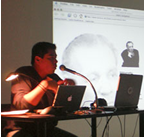
Eduardo Navas: Net(work) Art
netcase #1: Eduardo Navas: Net(work) Art: Criticizing, producing and curating
Eduardo Navas is a critical theorist and artist born in Salvador, living and working between San Diego and Los Angeles. During his lecture at MLAC Navas will present some of his art, theory and criticism focused on culture and media at large. The lecture will also focus on Navas's recent research on Remix as a cultural activity affecting curatorial practice; he will present examples of New Media projects that challenge the way curators approach contemporary art.
Eduardo Navas is an artist, historian and critic specializing in new media; his work and theories have been presented in various places throughout the United States, Latin America and Europe. He has been a juror for " Turbulence.org" in 2004 and for "Rhizome.org" in 2006-07, New York. Navas is founder and was contributing editor of "Net Art Review" (2003-05), is co-founder of "newmediaFIX" (2005 to present) and is co-founding member of "acute.cc", an international group of artists and academics who organize event and publications periodically. Currently, Navas is adjunct professor in Theory and Practice at Otis College of Art and Design in Los Angeles, and adjunct faculty of multimedia practice at San Diego State University. Navas is a Ph.D. Candidate in the Department of Art and Media History, theory and Criticism at the University of California in San Diego.
netcase is not just a space for exposition, not just a space for networking as artefact, but also a space for questioning and discussing networking as critical practice: networks as spaces of production. netcase proposes curating as a practice invested in understanding new media and methods of production. netcase is a project by MLAC – Museo Laboratorio di Arte Contemporanea of "La Sapienza" University of Rome, a museum and laboratory exploring new forms of cotemporary art practice. netcase at the MLAC is an editorial and multimedia curatorial project that embraces and oversees new technologies as its focus. netcase is curated by lucrezia cippitelli and domenico scudero.
Posted by jo at 08:45 AM | Comments (0)
December 21, 2006
Arty games with an agenda

Spring-Alpha + The People Speak +
[Also see Political/activist/radical, The war on terror, and Serious Games.]
Simon Yuill’s Spring-Alpha project (which actually consists of several games) is a simulation game (like the Sims). What is particular to the game is that it is ‘open source’ and the player is allowed to modify the code of the game. Hence, the game is double-sided. On the one hand side it is about playing a simulation-game but on the other hand side, it is also about creating a simulation-game – it is a ‘design game’ where the players / the programmers, through the inscription of rules for behaviour, negotiates the perspective of the game. The object of the game is not only to provide an entertaining game simulation but also to make the player contemplate the simulation, its perspectives, possibilities, and its limitations. In addition, the game is inspired by the works of artist Chad McCail, and it is nice to see that computer games actually are capable of having a graphical expression which strives for something else than simply imitating the real world.
The exploration of the possibility of using games to stage hidden structures and hidden social relations can also be used outside the world of the monitor. The People Speak is a group of artists who in one of their projects used the quiz show as a set-up in a design process of a mural in a social housing area in a East London. The quiz show enabled them to involve a group of people living in the area that are usually very difficult to contact under normal circumstances.
Runme.org is a database for software art curated by Olga Gurionova og Alexei Shulgin. If you are interested in games that experiment with the game world as a distinct artistic expression, this is the place to look. Featured articles follow several of the software art works in the database and they generally serve as very good introductions. Especially the game Sowjet-Unterzoegersdorf/the adventure-game, by the Austrian artist group Monochrom, is rather amusing. In the game, it turns out that the last Soviet republic is actually a village in Austria. It is definitely always worth visiting Monochrom’s website when surfing on the internet. [blogged by Christian Ulrik Andersen on Digital Experience]
Posted by jo at 07:19 PM | Comments (0)
rhizomes.13 fall 2006

Special Issue: Drifts
"[1] Confronted with spaces more than ever gridded and pre-arranged, mapped from the google universes to the nano-th degree, and already (over) saturated with the intentions of others, the contributors in this issue take up the general theme of drifts and drifting. The responses to our initial call range widely across genres (scholarly essays, fiction, nonfiction, film, accounts of performances), terrains (urban, rural, psychological, virtual), structures of feeling, and modes of locomotion from the pedestrian to the spectacular (a semi-truck). Several essays deliberately follow in the steps of the Situationist psychogeographers, such as Phil Smith and Clive Austin’s playful dérive around Exeter, England, or Jim Miller’s more sober-minded drift in downtown San Diego. Others chart a different trajectory as in Dianne Chisholm’s account of Ellen Meloy’s nomad raids on the nuclear-wasted desert or Casey Clabough's elegiac retracing of the Warrior’s Path." From Introductory Drift by Ellen E. Berry and Craig Saper, rhizomes.13 fall 2006
In this issue: Place and the Electrate Situation by William Tilson and John Craig Freeman :: Transfers: Portrait of a City by Matt Roberts and Kristin Powers :: A Case for Boston as a Liquid not a Solid by Catherine D’Ignazio.
Posted by jo at 06:42 PM | Comments (0)
transmediale.07: unfinish!
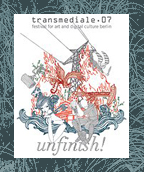
Conference
transmediale.07: unfinish! conference :: January 31 - February 4, 2007 :: Akademie der Kuenste, Berlin, Hanseatenweg 10.
The transmediale.07 conference, 'unfinish!', deals with the phenomenon of finiteness in art, science, architecture, computer science and politics. The digital culture of the present seems to be neither willing nor able to accept final determination and the closure of processes. Instead processuality and continuous and consecutive updates and versions are the credo of current cultural practices. The conference of the transmediale.07 enters into the discrepancy between the desire to open up solidified structures and situations, and the curse of digital work that doesn’t come to conclusions,but only to an iteration of preliminary versions. In this discussion terms such as ‘opening’, ‘closure’, and ‘restart’, figure as central aspects. In seven panel discussions and in three keynote speeches, they will be analysed and applied to artistic and socio-political questions.
The conference of transmediale.07 in organised in cooperation with the Federal Agency for Civic Education.
2. Keynotes: Stelarc, Kroker, Kittler
Keynote Stelarc (au)
Thursday, 1.2. 2007, 20.00 hrs, Akademie Hanseatenweg, Studio 1
In his lecture, the Australian artist Stelarc deals with the potential of improving the human body and with the consequences this has for the perception of subjectivity. Stelarc's work explores and extends the concept of the body and its relationship with technology through human-machine interfaces. His projects are attempts at testing the scientific 'state of the art' on the human body. In his lecture-performance Stelarc describes how he compensates the imperfection of his own body and equips it with technology:in the context of the project '1/4 Scale Ear', the artist recently attached a third ear to his forearm. The soft prosthesis was grown from human tissue. Stelarc considers the ear prosthesis not as a sign for a physical malfunction, but rather as a symbol for an additional feature. Thus he tries to amplify the forms and functions of the human body and produces a human-machine-hybrid which questions the notion of the wholeness of the body.
Moderator: Florian Roetzer (de)
Keynote Arthur Kroker (ca)
Friday, 2.2. 2007, 18.00 hrs, Akademie Hanseatenweg, Studio 1
In the 1990s Arthur Kroker was one of the most important theorists of the emerging cyber-culture. Today he is an alert critic of global digital culture which has moved on from the utopias of the waning 20th century. His lecture 'Changing the New World Order' analyses the resumption of seemingly closed but unfinished stories in a society altered by global technical changes. Kroker understands the development of technology as a global culture that also involves political, cultural and social areas.
Moderator: Florian Roetzer (de)
Keynote Friedrich Kittler (de)
Saturday, 3.2. 2007, 18.00 hrs, Akademie Hanseatenweg, Studio 1
Kittler holds the chair for aesthetics and history of media at the Humboldt University Berlin. In his lecture, he presents his current research concerning theories of machine, media and music and asks for the meaning of reversibility and infinite loop-d-loop which is being re-processed, after its execution as long as this is not prevented by external influences. What power lies in the knowledge that is hidden in computers and their algorithms?
Moderator: Wolfgang Coy (de)
In cooperation with the Federal Agency for Civic Education
3. Panel: Unfinishing Creation
Thursday, 1.2. 2007, 15.00 hrs, Akademie Hanseatenweg, Studio 1
The Panel 'Unfinishing Creation' deals with the relationship between humans, science, and the future. On the basis of artistic practices, and in conjunction with current scientific topics, especially from the life-sciences, the panel raises questions of openness, of continuous transformation and constant change in present-day society. Do concepts like reversibility, time, mistakes, and progress connect or divide artists and scientists? And do the natural sciences offer new tools to artists and other scientists to expand their own disciplines and to re-examine our society? Does the notion of an 'open system of life' form a new paradigm? And which effects do the changing media and technologies have on our cognitive structures and on the evolution of new artistic practices?
Moderator: Stefan Iglhaut (de)
Participants: Ingeborg Reichle (de), Warren Neidich (us/de)
In cooperation with the Federal Agency for Civic Education
4. Panel: Unfinished Cities
Friday, 2.2. 2007, 15.00 hrs, Akademie Hanseatenweg, Studio 1
The phenomena of the multi-layered urban development and urbanisation are among the main topics of the current global cultural context. While the countries of the ‘traditional’ industrialisation are dealing with ‘shrinking cities’, the increasing megalopolises, particularly those in Latin America, Asia and Africa, are in a process of immense and uncontrolled growth. The panel 'Unfinished Cities' presents positions which consider the exuberant growth and the insecurity which go along with it not as a form of dysfunction, but as a potential. The image of the permanently unfinished, insecure and complex city creates novel spatial constellations that accelerate the urban practice of appropriation and the creation of new forms of public spheres, thus preventing any state of closure.
Moderator: Regina Bittner (de)
Participants: AbdouMaliq Simone (za/uk), Orhan Esen (tr)
In cooperation with the Federal Agency for Civic Education
5. Panel: Opening and Closing, Beginning and Ending
Sunday, 4.2. 2007, 14.00 hrs, Akademie Hanseatenweg, Studio 1
The panel with Byung-Chul Han and Thomas Macho deals with notions of closing and opening from a philosophical point of view. By means of a comparison between occidental inwardness and far eastern openness, the speakers will trace different traditions of eastern and western thought.
Participants: Byung-Chul Han (kr/ch), Thomas Macho (de)
In cooperation with the Federal Agency for Civic Education
6. Panel: The Media Landscape of Iraq
Friday, 2.2. 2007, 12.00 hrs, Akademie Hanseatenweg, Studio 1
The future developments in Iraq will depend crucially on whether the question whether a process of negotiation can be initiated between the conflicting groups, or whether separation and isolation will continue. The function of the media in this process is not to be underestimated. The media communicate, comment and reflect; they form opinions and mobilise atmospheres of consent or dissent. Since the collapse of the regime, the media landscape in Iraq has been growing and sprawling uncontrollably in all directions, and the coverage of the socio-political situation is as multi-layered and complex as the situation itself. The discussion with Iraqi journalists and artists explores the role that the media play in the development of conflicts and the tight-rope walk between the freedom of speech and the will to survive. MICT (Media in Cooperation & Transition) introduce the topic with a report illustrated by video and audio material from their archives.
Moderators: Anja Wollenberger & Klaas Glenewinkel (de)
Participants: Ali Badr (iq), Ismail Zayer (iq)
In cooperation with the Friedrich-Ebert-Foundation
7. Whatever happened to Tactical Media?
Thursday, 1.2. 2007, 16.00 hrs, Akademie Hanseatenweg, Salon
Creating a collaborative culture has been the main goal of video activism, independent practices that are based upon cooperation and networking. Can online tools and services such as YouTube or Flickr provide new cultural identities and open up new areas of dialogue and critique? What political role does the Net play today as a tool for collaborative production? Is self-sufficiency and the DIY ethos still important in the age of Web 2.0? And what is the actual relevance of tactical media today? Introduction and Moderation: Joanne Richardson (ro)
Participants Part 1: Baerbel Schoenafinger (de/at), Katsiaryna Herasenkava & Pauluk Kanavalchyk (by), Anastasia Nekozakova (ru)
Participants Part 2: Petko Dourmana (bg), Fran Ilich (mx), Micz Flor (de)
In cooperation with the Federal Agency for Civic Education
8. Panel: Many Years of Video Art - Historical Views on Art and Media Wednesday, 31.1. 2007, 15.00 hrs, Akademie Hanseatenweg, Studio 1
In spring 2006, five German museums presented the project '40 Jahre Videokunst in Deutschland' (40 years of video art in Germany). A substantial DVD edition of more than 50 individual works in combination with a catalogue (Hatje Cantz Verlag) tries to describe the field of video art in Germany since the mid 1960s. In the context of its anniversary programme, transmediale.07 presents this DVD edition and attempts its evaluation in a broader and international context. Therefore similar projects from other countries have also been invited to the transmediale. The panel discussion between the producers of '40 Jahre Videokunst' and international colleagues offers a critical debate about such projects of documentation and overview.
Participants: Chris Hill (us), Barbara Borcic (si), Wulf Herzogenrath (de), a.o.
In cooperation with the Goethe-Institute
9. Panel: Media Art Undone
Saturday, 3.2. 2007, 15.00 hrs, Akademie Hanseatenweg, Studio 1
The participants of this panel discuss questions concerning the field and the term 'Media Art'. Is it time to let go of the label 'media art' altogether, and to strive for a re-inscription of media-based art practices into broader art discourses? Are the definitions of media art and media cultural practices still valid that used to justify their - positive and negative - discrimination?
Moderator: Miguel Leal (pt)
Participants: Diedrich Diederichsen (de), Inke Arns (de), Olia Lialina (ru/de), Timothy Druckrey (us)
Posted by jo at 10:59 AM | Comments (0)
Turbulence Commission:
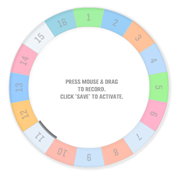
WhoWhatWhenAir
Turbulence Commission: WhoWhatWhenAir by John Snavely :: WhoWhatWhenAir is an interactive, pneumatic sculpture that users can communicate with via a web-based interface. Each user makes a series of choices to determine the order in which the 16 hoses inflate and to what degree. Once the sequence is saved, the hoses or "muscles" perform it. Clicking on the "play" button brings the sculpture to life. It exhales deeply before moving on to the next sequence in the queue. Coordinated efforts between online users can produce unexpected choreographies. In physical space, interaction is proximate, learned, and social. On exhibit at Art Interactive, Cambridge, Massachusetts, until January 14, 2007; open weekends from 12-6 pm.
"WhoWhatWhenAir" is a 2006 commission of New Radio and Performing Arts, Inc., (aka Ether-Ore) for its Turbulence web site. It was made possible with funding from the LEF Foundation.
BIOGRAPHY: John Snavely is a Masters of Architecture Candidate in the Department of Architecture at MIT. He holds dual degrees in Computer Science and Sculpture from Dartmouth College.
Posted by jo at 09:19 AM | Comments (0)
susana_mendes_silva
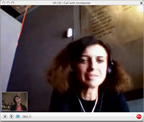
art_room
art_room#3: Don't be afraid to ask everything you always wanted to know about contemporary art.
My Skype name is susana_mendes_silva, call me.
art_room (#3) :: FRIDAY, DECEMBER 21, 0:00am - 1:00am (GMT) :: Untitled [ArtSpace] Upgrade! International: DIY, Oklahoma City.
susana mendes silva :: arslonga[at]netcabo.pt
Posted by jo at 09:06 AM | Comments (0)
December 20, 2006
Broken City
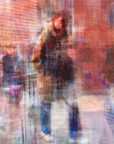
Transcoding
Broken City by James Alliban: This piece lies somewhere between generative art, software art, interactive fiction and photomontage. Interacting with it allows the user to paint different combinations of the various elements of a city and its inhabitants, and compose a random soundscape. Mini-narratives are generated from these ever-evolving juxtapositions.
The fragmented aesthetic employed within this hypermediated environment echoes our increasing ability to multi-task due to the computerisation of western society. It is an examination of this quasi-evolutionary development of human culture which Lev Manovich calls transcoding. [via Rhizome]
Posted by jo at 06:27 PM | Comments (0)
Transit
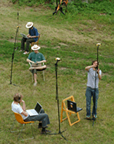
Mental Maps and the Networked Urban Space
Transit by KLAUS FILIP & NICOLAJ KIRISITS :: There is no doubt that within a few years urban space will be fiilled up with invisible data. Digital Communities will be located in real space. The internet will be extended by a geospatial network. All you'll need is a mobile interface (cellphones) to get involved with the communities / information / networks at certain places within the city. But what does that mean for the face of the city?What kind of mental map will we have from the geospatial networked based urban space?
As Kevin Lynch (1960, the image of the city) researches the legibility of urban space, Transit tries to find out the legibility of digital communities in urban spaces. For that proposition we built up an example of this digital urban space on a free field at the Kleyehof (Burgenland) with 25 invited Media artists. The Elements of that digital sculpture were text, video, sound and digital code, spatial located by using gps tools. The grid elements could be connected, to set up different networks.
The Objects are based on a spatial Masterplan, situated in a 3D grid of 1 to 1 to 1 meter; 20 meters long, 20 meters wide and 3 meters high), which defines private area (everyone can see-hear what you do but only you can change it), public (everyone can schange the data), and free spaces.
Transit was part of the podspot project at the University of applied arts vienna / department of digital art. [via Rhizome]
Posted by jo at 04:34 PM | Comments (0)
December 19, 2006
Receiver #17
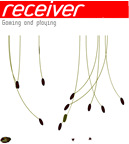
What is play and what's in a game?
Receiver #17 is a truly playful issue. While the urge to play is a human universal, gaming cultures differ widely across different societies – that goes for the games people enjoy as well as how they enjoy them. You can play with interactive media alone or to socialise, to compete or to relax, at home or in the street. What is play and what's in a game? Here are nine answers.
Matt Jones: The space to play :: Play – that is nothing less than how and why we learn, explore, interact with each other, understand each other and develop together. This is what Matt Jones thinks, who authors this receiver's opener. The designer was creative director for the award-winning BBC News Online and, after some time as a consultant at Sapient and KPMG, returned to the BBC to design BBCi's web search and an ambitious social software service. For the past three years he has been at Nokia, firstly in design research and now as Director of User-Experience Design for Nokia Design Multimedia. In "The space to play" he explores themes from his research into the universal human urge to play – and how it relates to the way we design our technology, our environments and our future.
D.B. Weiss: Lucky Wander Boy – the microsurgeon winner :: Los Angeles based D.B. Weiss is currently in the headlines for working on the script for a movie adaption of the "Halo" video game series that is scheduled for release in 2008. But that's not why we asked him to join receiver's gaming and playing issue. He indulged his playing passion already in his smart debut novel Lucky Wander Boy, a story about a man who finds a purpose through and is ruined by his obsession with video games. Of which we want to reprint an excerpt here. Read it – or listen to the podcast.
Jim Rossignol: Gaming international :: Jim Rossignol is a British technology author specialising in video games. His work appears in Wired, PC Gamer UK and the web development portal Gamasutra.com. His essay on Korean gaming culture was recently republished as part of the DigitalCultureBooks anthology The Best of Technology Writing 2006. Rossignol is currently researching a book on gaming culture and keeps a research blog at www.big-robot.com. In "Gaming international", he tells us about the experiences he gained during a visit to Seoul and compares European and Asian approaches to gaming.
Stuart Dredge: Mobile gaming – the troubled teenage years :: Stuart Dredge is a technology writer whose key areas of knowledge are mobile entertainment and consumer technology – fields in which he has also worked as an analyst. He covers mobile gaming as a freelance writer for several industry publications, edits the mobile games section of consumer website Pocket Gamer and covers consumer technology for Tech Digest. In his receiver contribution, Dredge takes a look at the future of mobile gaming, focusing on how mobile games could move beyond the familiar hits like Tetris and Pac-Man to new concepts blending innovation and connectivity.
Auriea Harvey and Michaël Samyn: Games in spite of themselves :: Tale of Tales is a Belgian design studio founded by Auriea Harvey and Michaël Samyn. Samyn started creating digital art and web design under the name of Zuper! in the mid-90s, and New York-based Auriea Harvey, prior to moving to Belgium, was known as Entropy8. They worked together as Entropy8zuper! and now join forces to create emotionally rich interactive entertainment – for example "The Endless Forest", a multiplayer game in which everybody plays a deer. There are no rules in this forest, and playing in it doesn't require much of your time. Come and meet the other deer and take in the scenery!
David J Edery: Playing by creating :: David Edery recently became the Worldwide Games Portfolio Planner for Xbox Live Arcade, and is a research affiliate of the MIT Comparative Media Studies Program (CMS). Prior to joining Microsoft, David was the CMS Program's Associate Director for Special Projects, during which time he co-founded the Convergence Culture Consortium and managed an exertainment project called Cyclescore. Edery also pens Game Tycoon, a business-centric video game industry blog. In "Playing by creating", he tells us why we should be excited about user-generated content.
Gonzalo Frasca: This just in. Playing the news :: Gonzalo Frasca is a video game theorist and developer, currently researching serious gaming at IT University of Copenhagen. He publishes the game research site Ludology.org and is editor at Game Studies. He is also a former head of video game development at Cartoon Network LA and webmaster/journalist at CNN International. Frasca co-founded Powerful Robot Games, a studio known for its work on election video games as well as its newsgaming.com project – an area Frasca will introduce us to in receiver. Let him convince you that games are the new news.
Noah Wardrip-Fruin: Three play effects – Eliza, Tale-Spin, and SimCity :: Noah Wardrip-Fruin is a digital media creator and scholar whose current work focuses on digital fiction and play, fields he explores as an Assistant Professor of Communication at the University of California, San Diego, as well as in his posts at the group blog Grand Text Auto. He edits and writes books on digital media, games, and storytelling – his newest just published by MIT Press (Second Person: Role-Playing and Story in Games and Playable Media). In his receiver contribution Wardrip-Fruin looks at three different models of what we experience through play.
Lev Manovich: Interaction as an aesthetic event :: Media theorist Lev Manovich is a Professor of Visual Arts at UCSD and a Director of The Lab for Cultural Analysis at the California Institute for Telecommunications and Information Technology. He's author of Soft Cinema: Navigating the Database (MIT Press 2005), and The Language of New Media (MIT Press 2001) which was hailed as "the most suggestive and broad-ranging media history since McLuhan". Currently he is completing his new book Info-aesthetics. In receiver, Manovich takes a look at the playful user interaction in recent cell phone models and other personal information technology.
Posted by jo at 05:39 PM | Comments (0)
Republic.com
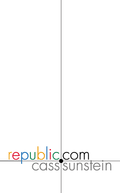
Is the Daily Me Good for Democracy?
Republic.com by Cass Sunstein :: See only what you want to see, hear only what you want to hear, read only what you want to read. In cyberspace, we already have the ability to filter out everything but what we wish to see, hear, and read. Tomorrow, our power to filter promises to increase exponentially. With the advent of the Daily Me, you see only the sports highlights that concern your teams, read about only the issues that interest you, encounter in the op-ed pages only the opinions with which you agree. In all of the applause for this remarkable ascendance of personalized information, Cass Sunstein asks the questions, Is it good for democracy? Is it healthy for the republic? What does this mean for freedom of speech?
Republic.com exposes the drawbacks of egocentric Internet use, while showing us how to approach the Internet as responsible citizens, not just concerned consumers. Democracy, Sunstein maintains, depends on shared experiences and requires citizens to be exposed to topics and ideas that they would not have chosen in advance. Newspapers and broadcasters helped create a shared culture, but as their role diminishes and the customization of our communications universe increases, society is in danger of fragmenting, shared communities in danger of dissolving. In their place will arise only louder and ever more extreme echoes of our own voices, our own opinions.
In evaluating the consequences of new communications technologies for democracy and free speech, Sunstein argues the question is not whether to regulate the Net (it's already regulated), but how; proves that freedom of speech is not an absolute; and underscores the enormous potential of the Internet to promote freedom as well as its potential to promote "cybercascades" of like-minded opinions that foster and enflame hate groups. The book ends by suggesting a range of potential reforms to correct current misconceptions and to improve deliberative democracy and the health of the American republic.
Posted by jo at 05:00 PM | Comments (0)
Low-fi Guest Selections
Charlie Gere + Cory Arcangel
Touch in art and elsewhere by Charlie Gere :: Recently, for various reasons, I have become interested in the question of touch, in art and elsewhere. We live in a world in which the ways in which we can communicate with each other become more and more immaterial, incorporeal and virtual, particularly through the increased use and greater ubiquity of digital technologies. In this context touch is often occluded and, at the same time, overly fetishised. In the last half century or so, there has been an increasing interest in touch in art, especially in relation to performance and telematic works, that may be a response to the increasing virtualisation of culture, though the question of touch can be traced in far older works, particularly some of those dealing with the life of Christ, which is, whether we are religious or otherwise, the founding myth of Western culture, and which has determined much of our understanding of questions of presence and absence, corporeality and spirituality, and our relation to the senses and thus to touch.
Cory Arcangel's Offline Art Show: Hello, for this project I have been asked to curate a small "online" artshow by low-fi.org.uk. Therefore, for a reason I am unable to explain myself, I have decided to put together this show "offline" aka - with no internet connection. So, since I have no Internet, I can't check my bookmarks to see what I've been interested in lately, and I can't search though my email to help me remember cool stuff I've seen lately, so basically I just have to remember the stuff off the top of my head. More >>
Posted by jo at 04:26 PM | Comments (0)
Touching the Invisible
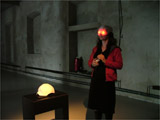
Working with the Invisible Flow of Information
Touching the Invisible characterizes the work performed at the Smart Studio and reflects how we work with the invisible flow of information. As it is channelled and directed into specific lines of investigation, the bits and waves transform through an eclectic mix of ideas into compound forms that become both visible and tangible. Our aim is always to bring the invisible out into the real space we inhabit, to invite the visitor for interaction, and overturn the outcome. The exhibition is built around six individual pieces representing different aspects and interpretations of the theme, that in different ways challenge our preconceived notions on flux and immobility, on thought and matter, on time and space.
The generative processes that lead to the final work can often start from discussions in the group, where we try to find associative paths between individual definitions, for example by delimiting an area of interest with keywords or images that may provoke a multitude of interpretations. The shifts of meaning that occur in the process are used as an asset that can add an unexpected twist to the issues and their realisations.
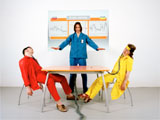
Brainball is a game, an art object and Smart studio's first completely hybrid research project. The players move a ball on a table by the sole use of their brainwaves. Encouraging competition through relaxation, the game objective is to score a goal on the opponent's side with the least possible action. Brainball is an exciting and social game but also an interesting tool for learning how to control your mental states. It has been exhibited in as widely different contexts as art and design exhibitions and medical fairs, and is seen as one of the studio's most successful hybrid objects.
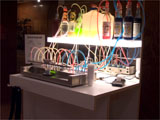
Brainbar is a mechanical bar that mixes drinks according to the visitor's brainwaves. The bar reads the brain frequencies (EEG or electroencephalogram) in the alpha and beta wavelength. These wavelengths are generally considered to be synonymous with the states of relaxation and activity in the mind. Thus the BrainBar serves the drink most suited for you, at the moment of measurement. BrainBar can be seen as a mediator or manipulator designed to give a party its perfect state of enhanced socialising, carefully adjusting the drinks served so that every guest stays within acceptable parameters for a “good” behaviour or, if the settings allow, a “bad” behaviour. By the use of alcohol and medical herb essences, the bar can emotionally equalize or polarize the group of guests. This can be seen as a sociological experiment exploring how much a person is prepared to submit to external forces and how far the person can allow a machine to intrude on the body.
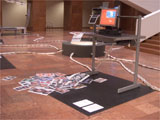
A paranoid web spider searching for the Devil on the net. By detecting inverted pentagrams in images stored on the Internet, the program determines if the image has evil content and alerts the siteowner. HellHunt is an application based upon the use of so-called vision algorithms, a way of enabling computers to detect and distinguish geometrical configurations inside pictures. The active algorithm in this piece traces down the diabolic symbol of the reversed pentagram on images stored on the Internet. When the program hits an image that corresponds with the algorithm, it draws the lines of the hidden pentagram on it. Furthermore, it saves the address of the page and sends an e-mail to it, kindly demanding the removal of the harmful image.
Posted by jo at 04:09 PM | Comments (0)
ebayaday

NEW AMERICAN DICTIONARY
L@@K!! Terms For Sale on EBAY for the NEW AMERICAN DICTIONARY!!! Browse through eBay between Friday, December 1st and 31st, 2006 and you may stumble upon one of twenty-five artists' auctions. All exist under the umbrella of ebayaday, a serial exhibition (one auction debuts each day) of artworks in the form of auctions. Each listing was created for the online marketplace and uses the entire listing -- item for sale, online identities, desriptive text and imagery, as well as the nomenclature of eBay's categories -- as elements in the work.
The New American Dictionary (Security/Fear Edition): The right to define words is power. You can buy power :: For ebayaday, the Institute for Infinitely Small Things is publishing THE NEW AMERICAN DICTIONARY, a compilation of new terms by and for Americans in the new millenium. This dictionary is uniquely democratic: YOU get to define the most important new words in it by purchasing them on eBay!
EXCLUSIVE until Dec 24th! Bid Now for as low as $0.95!! [view all on eBay]
ALERT
AXIS OF EVIL
COALITION OF THE WILLING
EMBEDDED JOURNALIST
EXIT STRATEGY
FRIENDLY FIRE
PREEMPTIVE WAR
TERROR
TORTURE
UNMARKED PACKAGE
Ebayaday artists: Conrad Bakker, Matthew Bryant, Carl Diehl, Karen Eliot, Charles Fairbanks, Marc Ganzglass, Josh Greene, Abhishek Hazra, Ellen Harvey, Christine Hill / Volksboutique, Nancy Hwang, Institute for Infinitely Small Things, Robin Kahn, Osman Khan, Sheryl Oring, William Pope L., Dan Price, REBAR, John Roos, Davy Rothbart, Yashas Shetty, Slop Mountain College faculty, Adriane Herman & Brian Reeves, Nick Tobier, Annie Varnot.
Posted by jo at 03:32 PM | Comments (0)
Dance and Process
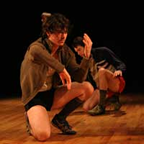
New Work
Dance and Process: Daniel Linehan, Melanie Maar, and Jillian Peña :: The Kitchen :: Wednesday, December 20, 8pm; Thursday, December 21, 8pm :: Tickets $10 :: Curated by Miguel Gutierrez ::
The culmination of a seven-week group process of sharing work and receiving structured feedback, this evening features new work by choreographers Daniel Linehan, Melanie Maar, and Jillian Peña. In Human Content Pile, Daniel Linehan probes his own choreographic process from an objective and amoral perspective in order to create a structure based on the incessant daily accumulation of material. Linehan collaborates with dancers Anna Carapetyan, Natalie Green, Michael Helland, and Miriam Wolf, along with Minneapolis-based writer/composer Erik Belgum, who provides a text-based score. Choreographed by Melanie Maar, DOPA - Duo in Process translates the symptoms of a body with neurological dysfunction into the arena of choreography and performance. Two women relate in an environment where the interplay of conscious and subconscious triggers stimulate their bodies to move. The performers are Mariangela Lopez and Maar, and a sound collaboration with Dylan Stanfield. In search of transcendence, Jillian Peña invites the audience to The Promised Land--an imaginary landscape of dreams and opportunities. The Promised Land is an interactive video experience.
Box Office: 212-255-5793 ext. 11. Box Office Hours: Tue-Sat, 2-6pm
The Kitchen is located at 512 West 19th Street between 10th and 11th Avenues.
Subway: A, C, E to 14th Street; 1 to 18th Street; L to 8th Avenue.
Posted by jo at 08:41 AM | Comments (0)
December 18, 2006
On Rhizome

D.I.Y. or DIE
In celebration of their respective ten-year anniversaries, Turbulence and Rhizome collaborated with Upgrade! New York to present an exhibition of works that they commissioned or presented over the course of their histories. The term D.I.Y. (or do-it-yourself) expresses an independent ethos, one that encourages cultural producers to create and distribute work outside mainstream or commercial systems and often in direct confrontation with them. In this case, D.I.Y refers not only to works in the show, many of which create alternate models for collaborative artmaking, community building, and media distribution, but to the organizations themselves whose missions--to commission and present digital art work--had no tradition or cultural niche to call upon. Historically, net artists have included audiences in their work; many created calls to action that compel their audiences to intervene and contribute their own ideas, stories and histories. From re-purposed commercial software to homegrown digital knitting applications and works that offer alternative constructions of identity and nationality, D.I.Y. or DIE presents a cross-section of Internet-based art that, much like punk and grassroots activism has the urgency and invention required to change existing standards of art practice.
D.I.Y. or DIE is currently installed at Individual Artists of Oklahoma (IAO), a not-for-profit arts organization presenting work by Oklahoma artists, including visual art, poetry, theater, and film and video.
Organized by Upgrade! New York, Turbulence and Rhizome.
Posted by jo at 07:02 PM | Comments (0)
Interactive Telecommunications Program
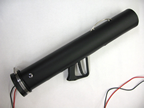
Winter Show @ NYU
As promised, I went to the ITP Winter Show opening today @ NYU; had a couple of thoughts about the show. Spoke with Benedetta Piantella Simeonidis and Lesley Flanigan who created the Sonic art weapon: Ravezooka which I mentioned yesterday.
.
Benedetta also has a personal blog hosted at NYU. The Sonic art weapon is programmed in MAXMSP and it seemed to me that this is a good program to learn since it's so visual. LemurPlex, located in Brooklyn, NY, not far from my Studio, appears to be the best place to learn MAXMSP around here, in NYC, - and you can see all the courses you can take at the LemurPlex -
I've passed by LemurPlex several times but never spoken to anyone - and several of the projects in the ITP show had connections with LemurPlex.com. I think I'll look them up and take an intro course to MAX -as I think I can learn from them how to execute some of my ideas for modern art, ideas I don't think I can execute in traditional paint media - these ideas need electronic media.
By the way, the Sonic Art Weapon cost less than 100 dollars to manufacture and has applications in science (Mars Robotic Probes would benefit from the technology used here, for example).
Other exhibits in the ITP show that I liked - LocationAura which similar to We Feel Fine, a subject I have already written about in Webmetricsguru.com; Catherine Colman and Nanna Halinen were not aware of the program (I think they should have been - as LocationAura tries to do, more or less, exactly what We Feel Fine does, much better) - but for a graduate project, LocationAura was pretty good - with a focus on mobile phones that We Feel Fine does not have (but does not need, either).
The Interactive Pond by Diane Chen, Peng Zhao and Hye Ki Min where you can play with a fantastic virtual reality pond and get your hands wet was pretty neat. Whales in the Sewer was pretty funny but I'd feel sorry for any whales that actually got caught in a city sewer. Orb was pretty amazing - I wanted to touch it - but I was told it would hack my hands off if I did; you can see a good picture of the Orb in action here. Future TV is an interesting project - getting information on anything on TV by clicking on that part of the image though it's more of a concept as everything had to be hand programmed - but the idea is great, especially if bots can go out on the web and pull the data in.
And while there is a strong element of telecommunications at the ITN show, there are several students who did not go in that direction; I don't know why they're in the program in the first place.
I think it's important for the ITP program not to lose it's focus - all the projects in this show, in my opinion, should have been about using technology to interact and create communication - but not all were.
Links: ITP Winter Program [blogged by by Marshall Sponder on Smart Mobs]
Posted by jo at 06:52 PM | Comments (0)
danah boyd
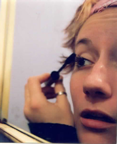
on being virtual
Lately, i've become very irritated by the immersive virtual questions i've been getting. In particular, "will Web3.0 be all about immersive virtual worlds?" Clay's post on Second Life reminded me of how irritated i am by this. I have to admit that i get really annoyed when techno-futurists fetishize Stephenson-esque visions of virtuality. Why is it that every 5 years or so we re-instate this fantasy as the utopian end-all be-all of technology? (Remember VRML? That was fun.)
Maybe i'm wrong, maybe i'll look back twenty years ago and be embarrassed by my lack of foresight. But honestly, i don't think we're going virtual.
There is no doubt that immersive games are on the rise and i don't think that trend is going to stop. I think that WoW is a strong indicator of one kind of play that will become part of the cultural landscape. But there's a huge difference between enjoying WoW and wanting to live virtually. There ARE people who want to go virtual and i wouldn't be surprised if there are many opportunities for sustainable virtual environments. People who feel socially ostracized in meatspace are good candidates for wanting to go virtual. But again, that's not everyone.
If you look at the rise of social tech amongst young people, it's not about divorcing the physical to live digitally. MySpace has more to do with offline structures of sociality than it has to do with virtuality. People are modeling their offline social network; the digital is complementing (and complicating) the physical. In an environment where anyone _could_ socialize with anyone, they don't. They socialize with the people who validate them in meatspace. The mobile is another example of this. People don't call up anyone in the world (like is fantasized by some wrt Skype); they call up the people that they are closest with. The mobile supports pre-existing social networks, not purely virtual ones.
That's the big joke about the social media explosion. 1980s and 1990s researchers argued that the Internet would make race, class, gender, etc. extinct. There was a huge assumption that geography and language would no longer matter, that social organization would be based on some higher function. Guess what? When the masses adopted social media, they replicated the same social structures present in the offline world. Hell, take a look at how people from India are organizing themselves by caste on Orkut. Nothing gets erased because it's all connected to the offline bodies that are heavily regulated on a daily basis.
While social network sites and mobile phones are technology to adults, they are just part of the social infrastructure for teens. Remember what Alan Kay said? "Technology is anything that wasn't around when you were born." These technologies haven't been adopted as an alternative to meatspace; they've been adopted to complement it.
Virtual systems will be part of our lives, but i don't think immersion is where it's at. Most people are deeply invested in the physicality of life; this is not going away. [blogged by zephoria on apophenia]
Posted by jo at 05:50 PM | Comments (0)
Two ITP Projects
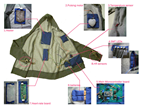
Worth a Look
Two interesting projects from the ITP (thanks regine!):
On one hand, MoPres: Sense and contribute to the ghosty presences around you by Jane Oh, Alex Bisceglie (see also their website):
MoPres brings out the residual presence of the people who occupied your current location. It is a geotagging project with the humanized ‘context’ of the locations. The raw data is from bio-metric sensers rather than the conscious, forceful, and mostly inaccurate logging which will provide a more creative and sophisticated flexibility of interpretation on the experiences of people
User Scenario: People wear the vest with embedded sensor package [heart rate and body temperature sensors], and the data is logged through the cell phone with geo tagging [gps and/or cell-tower id]. Once the mobile application reads the pattern of the data in relation to locations, it triggers the output devices embedded in the vest [heater and the pulse motor] with relevant residual patterns so that people can experience others’ past experiences at the given spot.
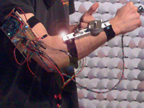
On the other hand: the personal range finder: A device used to navigate physical space without the aid of your eyes by Justin Downs:
The personal range finder is an assistive device that translates physical space into a tactile input on your arm. The goal of this project was to make an affordable mobile machine that is rugged, runs off a common power supply (9 volt battery) and easy to use. The range finder utilizes sonar to create a map of the surrounding physical space. This map is then translated to a scaled pressure gradient which is applied to your forearm. In this way you are able to “see” the surrounding 8 feet of space allowing for informed movement without the use of your eyes.
Why do I blog this? the first project is very interesting in the sense that it follows the trend “making explicit invisible/implicit phenomenon” in a nice way. Plus, I also like the lowtech look of the hooded The second one is different for another reason: the translation from physical space to a tactile input is a pertinent way to create a sort of intangible interaction through gestures: seeing by gesturing. [blogged by Nicolas on Pasta and Vinegar]
Posted by jo at 05:43 PM | Comments (0)
MYSPACE TOP 8 GALLERY
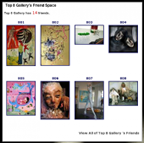
Art in the Age of Virtual Reproduction
Forget the institutions of yesterday, the Guggenheims and Tates, the Kunsthalle and Venice Biennale. In the internet age, with the creative expressive technologies of Web 2.0, and the naming of lonelygirl15 as Time’s Person of the Year, surely we have arrived at Joseph Beuys’ future fantasy when he prophesied that ‘everyone is an artist’.
In a new spirit of ‘Everyone is an Artist’, we are pleased to announce the launch of TOP 8 GALLERY – the art gallery for a new mixed reality world. MySpace is currently the most populous online community in the world. Originally associated with Music, MySpace has recently expanded its media ecology to include Film, Videos, and Comedy. Yet there is still no category for ‘Artist’. In MySpace, ‘artist’ only refers to a music artist. Top 8 Gallery seeks to redress this radical omission.
In acknowledgment of the millions of individuals making art (and here we are very expansive in our conception of art) here in MySpace, Top 8 Gallery has arisen to bring to the MySpace Public a new breed of artist and art. Our Gallery endorses ‘Art in the Age of Virtual Reproduction’.
Top 8 Gallery only features artists with a MySpace presence. Artists are chosen on the basis of their work represented in MySpace. Top 8 Gallery is a new media curatorial experiment. Members of the MySpace Public are chosen to curate Top 8 Gallery Exhibitions. Each exhibition features 8 artists via 8 separate MySpace Accounts that are displayed in the master Top 8 Gallery Profile. Exhibitions change on a monthly basis. MySpacers are invited to propose curated exhibitions entirely based on your favorite Top 8 MySpace artists.
We hope you enjoy the inaugural selection of artists carefully selected for the launch of Top 8 Gallery.
Posted by jo at 04:45 PM | Comments (0)
Vagueterrain.net

Issue 05
Vagueterrain.net the Toronto-based digital arts quarterly, has just launched its fifth issue: vague terrain 05: minimalism. This issue is dedicated to an exploration of minimalism and technology through various texts and multimedia projects which document and explore reductionism.
This diverse body of work contains contributions spanning multiple mediums from: aidan baker, bleupulp, clinker, granny'ark, greg j. smith, gregory shakar, i8u, jan jelinek (interview by greg j. smith), martin john callanan, michaela schwentner, monolake (interview by corina macdonald), patrick lichty, steven read and tobias c. van veen.
Posted by jo at 04:33 PM | Comments (0)
Anger

a multimedia immersion performance
Anger - a multimedia immersion performance by Randy Gibson and Ana Baer-Carrillo :: performance, reception, and silent auction :: presented by Avant Media Performance :: Thursday January 25, 2007 - 8PM ::20 Greene, SoHo, NYC (between Canal and Grand) :: tickets $15-$50.
Featuring :: Randy Gibson (piano, crotales), Mike Rugnetta (guitar, banjo), Laine Rettmer (voice), Ana Baer-Carrillo (video), Alicia Wargo (costumes, sculpture), and Oscar Henriquez (design).
"Anger" is an evening-length multidisciplinary work that deals with issues of major ordeal in the contemporary setting. Originally sprung from an intense feeling of pain and anger, "Anger" has developed into an idiosyncratic expression of the human condition. From birth, the human experience is multifaceted and contradictory, delightfully painful; at its most, this experience is bursting with excitement and passion, sorrow and anger.
"Anger" is a collaborative effort to depict the contradictory human condition through music, video and dance. The music runs a fine line between control and chaos. It is performed live on piano, guitar, and voice as a long form hyper-structured improvisation that moves through tonal areas that get to the heart of these feelings running the gamut from simple open chords to extremely dense sonic environments, and everything in between. The performers are forced to confront some of their worst fears, as the music is restructured live by a computer that samples the sounds they create and feeds them back to them in new combinations, all with complete randomness on multiple speakers. The musicians must be extremely aware of their performance, since they never know if what they just played will be played back to them five minutes later, or in little snippets 100 times over, or only once, or not at all. For this reason the performers are extremely skilled and able to adapt to any situation.
Accompanying this soundscape is a visual landscape of film and filmed dance. The visual elements are extensions of the ideas presented in the music. The chaos and randomness are depicted in the film through various experimental editing techniques. The majority of surfaces in the space are covered in large form video lending a surreal saturated environment to the performance installation.
"Anger" is uniquely suited to performance in a gallery environment. There is no best angle for hearing and viewing the work. The piece is unique from every position as certain elements change volume and importance. The video, four unique but similar channels of ever-changing combinations of loops, does not repeat the same combination of images until it has run for two and a half years. With a central core of speakers surrounding the performers, and additional speakers surrounding the audience, a true immersion in the music is achieved, live sound mixes perfectly with looped sound, and all sense of time and direction is lost as the audience member becomes entranced by the music and esoteric images.
"Anger" will premiere January 25, 2007 at 20 Greene in New York. Get your tickets here.
listen to sound excerpt | quicktime required
view video excerpt | quicktime required
Posted by jo at 10:32 AM | Comments (0)
Stuart (Student Art)
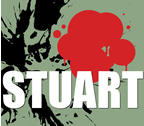
Peers connect in art showplace
A site that offers a free webpage to student artists is getting 3+ million hits a day. Called Stuart (stands for Student Art) the new sort of artist exchange is described in a New York Times story here. There are two parts to the story:
1. A strong response to the chance to display art work: The brainchild of the London-based advertising magnate and collector Charles Saatchi, this social networking outlet — a kind of MySpace knockoff for artists — is causing something of a sensation, boosting traffic at the gallery’s Web site overall to more than three million hits a day.
In May Mr. Saatchi, famed for spotting young unknowns and turning them into art-world superstars, created a section on his Web site for artists of all ages to post their work at no charge. It is called Your Gallery, and now boasts contributions by about 20,700 artists, including 2,000 pieces of video art. . . .
2. The smart mob effect among the student artists: But for students visiting Stuart, the main attraction for now is linking up with their peers.
In addition to lists of her favorite artists, books, films and television shows, Ms. Travis has posted the name of a new friend on her page at Stuart: Erhan Ozturk, a photography student at T. C. Maltepe University in Istanbul whose work she viewed at the site.
“I don’t know him,” Ms. Travis said, although they have conversed electronically. And while she doesn’t love his art, she said, “I think it’s pretty interesting.” (New friends tend to reciprocate: Mr. Ozturk lists Ms. Travis on his Web page, and with a simple click, visitors viewing his work can connect to hers.) [blogged by Judy Breck on Smart Mobs]
Posted by jo at 09:25 AM | Comments (0)
San Jose Airport
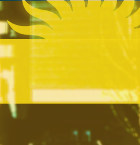
Request for Proposals
San Jose Airport Request for Proposals :: US residents only. Design / Fabrication / Installation of a Suspended Artwork (Open Call) :: We are seeking to commission an artist to design, fabricate, and install a suspended artwork for the San Jose Airport's North Concourse. The opportunity offers a wide range of possibilities, including, but not limited to: visually large scale, modular, dynamic, interactive, kinetic, involving data mining and visualization, and/or web-based interaction. The commission is $375,000.
The San José Art Public Art Program continues to be a model for other programs due to its extensive community outreach and participation. Each new project begins with communities defining broad goals to be considered in the development of the artwork. Artists are subsequently selected by community-based panels from the Artist Pool. Selected artists typically meet between two and four times with community members before and during the design process, in order to gain understanding of community goals, and to get feedback on designs.
Mary A. Rubin, Senior Project Manager
San Jose Public Art Program
365 S. Market Street
San Jose, CA 95113
(P) 408 277-5144 x 16 (f) 408 277-3160
San Jose Public Art
Posted by jo at 08:41 AM | Comments (0)
New Reviews/Interviews at Furtherfield.org

The December 2006
New Reviews/Interviews at Furtherfield.org Dec 2006
Ele Carpenter: Interviewed by Jess Laccetti :: Open Source Embroidery: Jess Laccetti Inquires about Ele Carpenter’s Latest Work: “‘The Open Source Embroidery’ project brings together programming for embroidery and computing. It's based on the common characteristics of needlework crafts and open source computer programming: gendered obsessive attention to detail; shared social process of development; and a transparency of process and product.” Ele Carpenter is undertaking post doctoral research with CRUMB (Curatorial Resource for Upstart Media Bliss) at the University of Sunderland. Her curatorial practice-based research is focused on socially and politically engaged art activism with and without new technologies. Research outcomes include: the RISK project, 2005; the Open Source Embroidery Project, 2006; and thesis due
to be completed in January 2007.
The Amazon Noir Team: Interviewed by Franz Thalmair :: THE BIG BOOK (C)RIME: About one year after the release of Google Will Eat Itself the artists Paolo Cirio, Alessandro Ludovico, Hans Bernhard and Lizvlx (both ubermorgen.com ) out foxed Amazon.com, the second global Internet player. The results of the Media Art-event, Amazon Noir - The Big Book Crime, were presented to the public on the 15th of November 2006. In this interview the Amazon Noir Crew talks about the framework of the project, its coding and art historical background, the official feedback and copyright issues.
Bio Mapping by Christian Nold: Review by Cinzia Cremona: If you go to http://www.biomapping.net, the first (moving) image you see looks like an aerial view of a spiky fence enclosing a small area of Greenwich (London) implanted onto a Google Map. Two red dots at the opposite ends are labeled ‘Yachtclub Sneaky Drink’ and ‘Busy Traffic Crossing’. This is a visualization of an individual experience of Christian Nold’s Bio Mapping Project. Christian started working on Bio Mapping in 2004 by building a Galvanic Skin Response sensor/data logger and connecting it to a commercial GPS unit.
GROUNDED exhibition: Reviewer by Lauren A Wright :: GROUNDED Unearthed. An exhibition curated by Axel Stockburger, at E:vent in Bethnal Green, London. Which has in the past few months relocated from the basement of its converted warehouse, artist-community home into a main floor space. The group exhibition GROUNDED brings together a diverse range of international artists. Showing work that deals with processes of modeling and simulation, activities that form the conceptual backbone of digital culture. However all of the artists involved are tackling this subject with an array of practices that are firmly rooted in physical environments, from architecture to installation thus addressing important elements of digital culture with essentially non-digital means.
Andy Stringer exhibiton: Review by Rob Myers :: The Destabilisation of perception by Andy Stringer :: TheSpace4, Peterborough, 10th November 2006 - 12th January 2007. Andy Stringer's show at TheSpace4 in Peterborough consists of a series of large-scale abstract paintings. The labels and the catalogue identify these works as paintings, and they are areas of liquid pigment on substrate laid down with a flatness that Greenberg could only have dreamt of. These paintings are in fact wide-format inkjet prints of images created on computer using imaging software. Artists who pursue abstraction through new technology are often accused of technological determinism. Usually, ignoring the historical relationship of art to technology and of technology and culture. J David Bolter's theory of determining technologies explains how societies regard their humanity in metaphoric terms of their highest technology, whether that is fire, pottery, steam or computers.
Installation of Ombea by Pash*: Review by Palo Fabuš ::Moving Sounds of Ombea - Pash*. Ombea is what Russian conceptual artist Ilya Kabakov calls a total installation, a designed experience. Ombea is an interactive installation, consisting of an empty room with 4 speakers, 4 light sources and 2 cameras, which are placed within a space, partially isolated from light and sound coming from outdoors, provided with a lockable entrance; a computer is located outside the ombea space with max/msp/jitter patch which serves to direct the space reaction.
If you are interested in being a reviewer on Furtherfield contact: marc.garrett[at]furtherfield.org
Furtherfield Neighbourhood & Projects:
# www.http.uk.net
# www.furtherfield.org
# www.visitorsstudio.org
# www. blog.game-play.org.uk
# www.nodel.org (with many others)
# netartfilm.furtherfield.org
# www.netbehaviour.org
# www.furthernoise.org
Posted by jo at 08:38 AM | Comments (0)
You -- Yes,
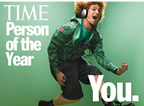
You -- Are TIME's Person of the Year
"... But look at 2006 through a different lens and you'll see another story, one that isn't about conflict or great men. It's a story about community and collaboration on a scale never seen before. It's about the cosmic compendium of knowledge Wikipedia and the million-channel people's network YouTube and the online metropolis MySpace. It's about the many wresting power from the few and helping one another for nothing and how that will not only change the world, but also change the way the world changes.
The tool that makes this possible is the World Wide Web. Not the Web that Tim Berners-Lee hacked together (15 years ago, according to Wikipedia) as a way for scientists to share research. It's not even the overhyped dotcom Web of the late 1990s. The new Web is a very different thing. It's a tool for bringing together the small contributions of millions of people and making them matter. Silicon Valley consultants call it Web 2.0, as if it were a new version of some old software. But it's really a revolution." From You -- Yes, You -- Are TIME's Person of the Year by Lev Grossman
Posted by jo at 08:04 AM | Comments (0)
December 17, 2006
Eric Kluitenberg
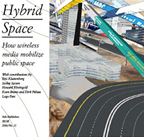
The Network of Waves: Public Agency in Hybrid Space
The Network of Waves: Public Agency in Hybrid Space by Eric Kluitenberg
The office space above which I live, in a corner house in the Indische Buurt, somewhere in Amsterdam East, used to house a local police station. At that time I was not yet living there. The place was briefly in the national news because of a fair-sized riot which took place there. A couple of Moroccan youths were brought to the station for some minor offence. Their friends thought that this was not right, so they followed the police back to the station to besiege the policemen there. It was not just a few friends who ran after the policemen, but a much larger group which suddenly turned up at the station, coming from nowhere at the precise moment when the youths were brought in. At that time this phenomenon, later known as a 'flash mob', [1] was still relatively new. The police on site were unpleasantly surprised, and had to issue a hasty call for reinforcements to negotiate with the besiegers. When it was all over a police spokesman said that it was a disgrace that the Moroccan youths had used their mobile phones to mobilize a mob. How else could these youths all have known at the same time that something was going on at which their physical presence was 'urgently desired'? And exactly where they needed to be? What the spokesman meant was that the youths had compiled mailing lists for text messages and then used texting to get together as many people as possible as quickly as possible. Texting with mailing lists was a popular application, because at that time text messages could still be sent and received free of charge.
A few years ago 'flash mobs' received a good deal of attention from the mass media. Semi-spontaneous public gatherings of groups of people, hardly if at all known to one another, nondescript, with no determining characteristics such as banners, uniform or logo, briefly performed some collective synchronous action, and then dissolved back into 'the general public'. Directions and information about the gathering were sent out by text messages, or e-mails, telling participants where, when and what. These short messages could easily be sent on to friends and acquaintances with the aim of starting a chain reaction resulting in the appearance of an unpredictably large mob at a predetermined time and place.
Reclaim the Mall!!
The 'flash-mob' phenomenon is thought by some people to have originated in a few relatively unmanageable actions in large shopping centres in American towns, disorganizing them temporarily and playfully. These actions generally had no political significance. This all changed at the end of the 1990s. The 'Reclaim the Streets' movement, [2] highly active at the time, which used to organize illegally orchestrated 'street raves' in the public spaces of large towns, made intensive use of text and e-mail address lists to organize quasi-spontaneous street parties. They did however give these street parties a layered political agenda. The parties were generally given concrete political and social themes and were linked to particular actions, such as support for a strike by London Underground staff. The movement's desire to also use these actions to free public space from its economically determined function (for instance transport, shopping or advertising) was succinctly expressed in the slogan 'The streets for people!'. The parties followed a fixed procedure. The evening before, a sound truck with a generator, a DJ kit and a large number of loudspeakers would park in a wide street. Shortly before the start a double collision would be staged at the beginning and end of the street. The crucial factor here was the provision of information for the participants, who were, in principle, unknown to the organizers. Participants therefore received a short message containing simple directions to the place, the date, the time and a few instructions, such as 'wait for the orange smoke -- that's when the rave will begin'. The double collision meant that at the agreed time the street was closed to all traffic. The cars used were fitted with smoke bombs which were set off by the mini-crash, producing enormous plumes of orange smoke, visible for miles around. This was the sign for which the 'Reclaim the Street' mob was waiting. Suddenly the street was flooded with people, sometimes more than a thousand at a time, while music began to boom from the previously parked truck or bus.
These examples demonstrate that we are living in a space in which the public is reconfigured by a multitude of media and communication networks interwoven into the social and political functions of space to form a 'hybrid space'. Traditional space is being overlaid by electronic networks such as those for mobile telephones and other wireless media. This superimposition creates a highly unstable system, uneven and constantly changing. The social phenomena which occur in this new type of space can not be properly understood without a very precise analysis of the structure of that space.
The way the Moroccan youths in Amsterdam East used text message address lists to mobilize themselves rapidly and effectively against what they saw as unjustified police violence provides an interesting example of a social group which finds itself in a socially segregated and stigmatized position appropriating a newly available technology. Mobilization was possible because at that time real-time mobile communication (texting) was available essentially free of charge. Shortly after that incident, texting became a paid service, though the reasons for this were economic rather than political, and its use for this purpose quickly lost popularity. It was simply too expensive to send so many messages at the same time. The specific relationship between time, space and technology, and to a lesser extent simple economics, determined the way in which this social phenomenon manifested itself. More than e-mails, which almost always have to be downloaded from a terminal or laptop (e-mailing on a mobile telephone is extremely laborious and inefficient), the brief phase during which text messaging served as a free public medium provided an important indicator to a changing relationship in the use and organization of public space. The mobility and immediacy of the medium gave birth to new social morphologies, like the 'flash mob', which still seem mostly to indicate a kind of mobile 'just-in-time-community' in physical public space.
The Place of Flows...
The question here is what this new kind of social morphology might mean. What lies behind the gimmick? What social, economic and technological transformations give rise to new phenomena of this kind?
So far the most important sociological theory about this is set out in Manuel Castells' Rise of the Network Society, the first part of his trilogy on the information age. [3] In it he describes the rise of flexible social network connections which resulted from economic and social transformations in late industrial societies and were strengthened by the introduction and wide application of new technology, primarily communication and information technology. Castells postulates that the network has become the dominant form in a new type of society that he calls the network society. He treats the influence of the network form as a social organization in physical and social space and establishes a new kind of dichotomy. According to Castells there are two opposing types of spatial logic, the logic of material places and locations (the 'space of place') and the logic of intangible flows of information, communication, services and capital (the 'space of flows'). [4]
The particularly striking thing about Castells' theory is the strict separation between the two kinds of spatial logic. Whereas the space of places and locations is clearly localized and associated with local history, tradition and memory, Castells sees the space of flows as essentially ahistorical, location-free and continuous. This last mainly because it moves across every time zone and so in some sense is not only location-free but also timeless. [5] Castells believes there is a fundamental asymmetry between the two kinds of space: while the vast majority of the world's inhabitants live, dwell and work in the space of places and locations, the dominant economic political, social and ultimately also cultural functions are increasingly shifting to the place of flows, where they make possible location-free ahistorical network connections, international trends, power complexes and capital movements. Only a very small part of the world population is represented in the bodies which take decisions about the organization and use of new location-free spatial connections. But increasingly the decisions made within such self-contained systems determine the living conditions in those places and locations where the vast majority of the world population attempt to survive and where their knowledge, experience and memory is localized. Castells feels that it is not surprising that political, social and cultural bridges need to be deliberately built between the two spatial dynamics, to avoid society's collapse into insoluble schizophrenia.
The attractive thing about Castells' theory is that it makes it possible to grasp and clarify a multiplicity of asymmetric social developments in a single image -- an image that has certainly not left popular culture unmoved. At the same time Castells' suggested contrast between physical locations and places and the intangible space of flows is misleading and ultimately even counterproductive for his political agenda: the deliberate building of bridges between physical space and informational space. Instead of a strict separation between physical space and informational space, all technological and social trends clearly indicate that these two 'spheres' are becoming more and more closely interwoven. A generic model of the sort suggested by Castells is totally unsuited to the analysis of this closeness and to gaining an understanding of how possibilities for public and private action come about within it, the central question posed in the present issue of Open. What threats to the autonomy and inviolability of the subject, the group, the community or cultural self-determination could possibly manifest themselves here and how can something be done about those threats?
Hybrid Space as a Polymorphous Concept
Against the placelessness and continuity of Castells' ahistorical 'space of flows' stands the discontinuity and multiplicity of hybrid space. The hybridity of this spatial concept refers not only to the stratified nature of physical space and the electronic communication networks it contains, but every bit as much to the discontinuity of the 'connectivity' or degree of connection between the multiplicity of communication networks. After all, even the universal presence of a telephone connection can not be taken for granted. More important still is the connection between local social and electronic networks: who communicates with whom, and in what context, is determined differently from one region to another, sometimes even from one day to the next. Because the space of electronic communication is rooted in local networks, it is also linked with local history. And questions about who controls electronic space or becomes familiar with electronic space are by no means easy to answer. Ravi Sundaram for example, co-founder of the Sarai new media initiative in Delhi, is constantly drawing attention to the coming into being of what he calls 'electronic pirate-modernity', [6] which comes about when local groups or individuals, illegitimately and without permission, gain access to television, telephone or the Internet -- 'Never ask permission, just appear!'.
Hybrid space is never exclusively local, as in the case of the idyllic hippy commune at the beginning of the 1970s. Small local networks, hacked or not, never remain limited to the local bazaar or the vegetable market in the next village. Local networks interweave with the international networks into which they force their way. Thus, says Saskia Sassen, the local is reconstituted as a micro-environment with a worldwide reach. Free-software geniuses in Sao Paulo's favelas find no difficulty in downloading the results of the latest interchange between the Amsterdam Waag (the Society for Old and New Media) and the Alternative Law Forum in Bangalore, but nobody pulls his or her local roots out of the ground.
Diktat of Visibility
The thing that strikes one about current discussion and the associated criticism of the rise of electronic media in public space is the preoccupation with the visual forms in which these media manifest themselves, such as screens, projections and electronic tagging. [7] It is a sort of extended visual criticism, closely connected with a tradition which assumes that the visual arrangement of observable reality is a necessary precondition for any ability to exercise power over that reality. However, the thing that stands in the way of this preoccupation with the visual is a critical analysis of the more invisible processes which are rearranging public space and imposing a different utilization logic. Relatively invisible forms of social compulsion, which bring these processes into play, may well have a much greater significance for the way in which public space can and may be used in future.
The concept of the perfect visual arrangement, expressing a social reality in which power structures are completely unambiguous and transparent, still always refers to Alberti's 'legitimate construction' and Piero della Francesca's ideal city, both of which reflect a visual articulation of daily life suggesting that everything, social and public, is completely controllable and constructible. Although the unifying point of view of a linear perspective has long been rejected, the street screens still stipulate for us a single perspective: a correct viewing distance and direction, while social relationships are radically altered.
The street screen is also the embodiment of spectacle in its most repressive form. Today spectacle is no longer alone in controlling the inner life, the interior of the alienation of the average TV junkie. The street, the classic stage of modern theatre, is overloaded with marching electronic screens and projections, so erasing the public functions of open space. Public functions become blurred by the flow of light and images drenching us in a fetish of alienating desires as we follow our necessary route through the city, from A to B.
Limitations of the Screen
Another point of criticism of the new urban visuality is its inherent limitation. Virtually every screen is rectangular and flat and has limited resolution (the number of pixels which determine the quality of the image). Media artists recognized these limitations years ago and have, with varying degrees of success, developed a multitude of strategies to attempt to overcome those limitations by, for example, a spatial type of installation, interactive media in which the screen itself also becomes an object capable of being moved and manipulated, projection on walls, fabrics, curved screens, screens that are not rectangular, [8] mirrored projections, moving projections, projections on glass materials and so on. Some artists, as for example the members of the Knowbotic Research collective, even leave out screens entirely, replacing them by new haptic interfaces and stereoscopic helmets from the Virtual Reality research laboratory or, as during the 1996 Dutch Electronic Art Festival, an installation on the roof of the Netherlands Architecture Institute, where network manipulations translated into sound and stroboscopic light. [9] Yet another example of the movement to bypass the screen is the Xchange network, in which artists collectively explore the sonic dimension of the Internet. [10]
The new generation of media-architects can learn from media art that the screen is ultimately a dead end. It is interesting to see how these attempts at iconographic liberation keep on recurring. Avant-garde painters carried out endless experiments in their attempts to break away from the frame of the painting and the surface of the canvas, their ultimate aim being to announce the death of the 'retinal' object. This same death announcement is repeated by today's media artists, but this time in relation to the screen. Media architecture again venerates the screen as a window on a space first seen as boundless, but later recognized as being largely subject to limitations and conventions.
Ultimately the screen dissolves into the architecture, becoming less a screen than a membrane between physical and medial reality. Here the 'image' functions less and less as an autonomous object, but increasingly coincides with the architecture itself, its skin, its inner life and its internal processes, finally disappearing from the consciousness of the user of that architecture. The image ecomes subliminal, 'vernacular', commonplace, merged with the environment, self-evident -- in the end the spectacle neutralizes itself. Media theorist Lev Manovich was still positive about this new medially enhanced architecture in his essay entitled The Poetics of Augmented Space, that had Learning from Prada as subtitle and was based on the success of Koolhaas's creation. [11] By now we know that the concept has failed completely, screens have disappeared from the scene or have been cut back to a minimum. The lesson of Prada is that the strategy of visibility can quickly turn into its opposite.
The Problem of Invisibility
In the present phase, the most important change in computer technology and its applications is that they are steadily beginning to withdraw themselves from sight. The European Union has for some years now been subsidizing a wide-ranging programme of multidisciplinary research and discussion with the remarkable title The Disappearing Computer. This title alludes less to the disappearance of computer technology than to its ongoing miniaturization and the way that it is beginning to turn up everywhere. The programme is investigating the migration of electronic network technology into every kind of object, to built environments and even to living beings. The thesis is that miniaturization and steadily reducing production costs are making it simpler to provide all kinds of objects with simple electronic functions (chips containing information, tags that can send or receive signals, identification chips and specialized functions in everyday objects). This is more efficient than building ever more complex pieces of multifunctional apparatus and mean the abandonment of the old idea of the computer as a universal machine capable of performing every conceivable function. [12] In fact, this is how technology becomes invisible. A decisive step, with dramatic consequences for the way people think about and deal with spatial processes.
This assimilation of computer technology in the environment introduces a new issue: the problem of invisibility. When technology becomes invisible, it disappears from people's awareness. The environment is no longer perceived as a technological construct, making it difficult to discuss the effects of technology.
Lev Manovich speaks of 'augmented space', a space enriched with technology, which only becomes activated when a specific function is required. [13] Wireless transmitters and receivers play a crucial role in such enriched spaces. Objects are directly linked with portable media. Chips are incorporated into identity cards and clothing. Even one's shopping is automatically registered by sensors. Screens and information systems are switched on remotely, by a simple wave of the hand. Miniaturization, remote control and particularly the mass production of radio frequency identification (RFID) tags is bringing the age-old technological fantasy of a quasi-intelligent, responsive environment within reach of digital engineers.
Of course these applications are not exclusively neutral. Combinations of technologies of the sort described above make it amazingly simple to introduce new and infinitely differentiated regimes for the control of public and private space. The application to public transport of RFID smart cards, which automatically determine the distance travelled, the fare and the credit balance, still sounds relatively harmless. Fitting household pets with an identity chip the size of a grain of rice, inserted under the skin, has become widespread practice. Indeed most health insurance schemes for household pets prescribe the insertion of such chips as an entry condition. Recently, however, first reports have turned up of security firms in the United States which provide their employees with subcutaneous chips allowing them to move through secure buildings without the use of keys or smart cards. Such systems also allow companies to compile a specific profile for each individual employee specifying those parts of the building or object to which the employer has (or is denied) access, and at what times
It is not difficult to extrapolate these practices to society as a whole. Who has the initiative in such matters? If the initiative lies exclusively with the constructors, the producers of these augmented spaces, and their clients, then the space we are living in is liable to total authoritarian control, even if there is no immediately observable way in which that space displays the historic characteristics of authoritarianism. The more widely the initiative is distributed between producers and consumers and the more decision-making is transferred the 'nodes' (the extremities of the network, occupied by the users) instead of at the 'hubs' (junctions in the network), the more chance there is of a space in which the sovereign subject is able to shape his or her own autonomy. The articulation of subjectivity in the network of waves is also an opportunity for the last remnants of autonomy to manifest themselves.
The Strategic Issue: 'Agency' in Hybrid Spaces
The concept of 'agency' is difficult to interpret, but literally combines action, mediation and power. It is not surprising therefore, to find it applied as a strategic instrument for dealing with questions about the ongoing hybridization of public and private space. Unlike Michel de Certeau's tactical acts of spatial resistance to the dominant utilitarian logic of urban space in particular, the action of this instrument in new ('augmented') hybrid spaces has mainly strategic significance. A tactical act of spatial resistance, which is after all no more than temporary, is hardly comforting to anyone faced by such an infinitely diversified and adaptive system of spatial control. New hybrid spaces must be deliberately 'designed' to create free spaces within which the subject can withdraw himself, temporarily, from spatial determination. Given the power politics and the enormous strategic and economic interests involved, and the associated demands for security and control, it is clear that these free spaces will not come about by themselves or as a matter of course. I would therefore like to suggest a number of strategies to give some chance of success to the creation of such spaces
Public visibility: 'maps and counter-maps', tactical cartography
The problem of the invisibility of the countless networks penetrating public and private space is ultimately insoluble. What can be done, however, is to remake them in a local and visible form, in such a way that they remain in the public eye and in the public consciousness. This strategy can be expressed in 'tactical cartography', using the tools of the network of waves (gps, Wi-Fi, 3G, etcetera) to lay bare its authoritarian structure. An aesthetic interpretation of these structures increases the sensitivity of the observer to the 'invisible' presence of these networks.
Disconnectivity
Emphasis is always placed on the right and desire to be connected. However, in future it may be more important to have the right and power to be shut out, to have the option, for a longer or shorter time, to be disconnected from the network of waves.
Sabotage
Deliberately undermining the system, damaging the infrastructure, disruption and sabotage are always available as ways of giving resistance concrete form. Such measures will, however, always provoke countermeasures, so that ultimately the authoritarian structure of a dystopian hybrid space is more likely to be strengthened and perpetuated than to be thrown open to any form of autonomy.
Legal provisions, prohibitions
In the post-ideological stage of Western society it seems that the laws and rights used to legalize matters provide the only credible source of social justification. But because a system of legal rules runs counter to the sovereignty of the subject it can never be the embodiment of a desire for autonomy. It can, however, play a part in creating more favourable conditions.
Reduction in economic scale
New hybrid systems of spatial planning and control depend on a radical increase in economic scale in the production of its instruments of control. Thus the political choice to deliberately reduce economic scale would be an outstanding instrument to thwart this 'scaling-up' strategy. [14]
Accountability and public transparency
In the words of surveillance specialist David Lyon, 'Forget privacy, focus on accountability'. It would be naive to assume that the tendencies described above can easily be reversed, even with political will and support from public opinion. A strategy of insisting on the accountability of constructors and clients of these new systems of spatial and social control could lead to usable results in the shorter term.
Deliberate violation of an imposed spatial program
Civil disobedience is another effective strategy, especially if it can be orchestrated on a massive scale. Unlike sabotage, the aim here is not to disorganize or damage systems of control, but simply to make them ineffective by massively ignoring them. After all, the public interest is the interest of everyone, and no other interest weighs more heavily. [15]
The formation of new social and political actors -- public action 'Agency', the power to act, means taking action in some concrete form. The complexity of the new hybrid spatial and technological regimes makes it appear that the idea of action is in fact an absurdity. However, new social and political players manifest themselves in public space by the special way they act, by clustering, by displaying recognizable visuality, by marking their 'presence' vis-a-vis (the) other(s).
The manifestation of concrete action by new social and political actors in public space is 'gesture'. The action, in this case, is the way the space is used, though there is still a difference between the use of a space and more or less public actions in that space. The use of space becomes agency when that use takes on a strategic form.
Notes:
1. For a description, see http://en.wikipedia.org/wiki/flashmob.
2. Reclaim the streets website http://rts.gn.apc.org/.
3. Manuel Castells, The Rise of the Network Society (Oxford: Blackwell Publishers, 1996).
4. Ibid.
5. Consider for example the concept of the 24-hour economy.
6. 'Electronic pirate modernity': see also www.sarai.net.
7. See also www.urbanscreens.org or the Logo Parc symposium held in Amsterdam on 16 November 2005, a cooperative project undertaken by the Jan van Eyck Academy, the Premsela Foundation and the Art and Public Space Lectureship (Rietveld Academy and the University of
Amsterdam).
8. These 'shaped screens' do incidentally form a curious counterpart to Frank Stella's Shaped Canvasses.
9. Anonymous Muttering: http://www.khm.de/people/krcf/AM/.
10. Website of the Xchange network, http://xchange.re-lab.net. 11. Lev Manovich, The Poetics of Augmented Space: Learning from Prada (2002), see www.manovich.net
12. The so-called Turing Machine, named after the mathematician Allan Turing -- the machine that is capable of simulating any other machine.
13. Manovich, The Poetics of Augmented Space, op. cit. (note 11).
14. The mass production of RFID (radio frequency identification) tags compelled producers to minimize the security provisions incorporated to allow the tags to be applied cost effectively to virtually any conceivable consumer product. A policy of giving priority to the safety and reliability of the chips and the information stored on them would make them much too expensive, restricting their development to specialized 'niche' markets.
15. Examples of a new kind of civil disobedience include deactivating RFID tags with the aid of an adapted mobile phone, hindering the operation of smart cards, regularly swapping client cards, deliberately supplying false information when registering online and using 'anonymizers' on the Internet, 'encrypted' (coded) mobile phones and local gsm blockers.
This essay was written for the new issue of Open (#11), cahier about art and the public domain - "Hybrid Space". The essay introduces the overall theme of the issue, and suggests some strategic considerations on the use of hybrid space.
More information on the issue can be found at the website of NAi Publishers:
http://www.naipublishers.nl/art/open11_e.html
and at the website of Open:
http://www.opencahier.nl
The journal was presented at De Balie, Centre for Culture and Politics in Amsterdam, on November 18, with the annual SKOR lecture, delivered this year by Saskia Sassen: "Public Interventions - The Shifting Meaning of the Urban Condition". The lecture is available on-line at: http://www.debalie.nl/terugkijken See also: http://www.debalie.nl/artikel.jsp?podiumid=media&articleid=85601 [via nettime]
Posted by jo at 06:19 PM | Comments (0)
[iDC]: Tom Sherman
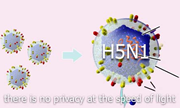
Transmediation is the name of the game
TRANSMEDIA: The term transmedia is often used to describe the way a corporation establishes an idea by implanting similar messages across a range of media concurrently. An idea (or image or sound) is implanted simultaneously in video, television, radio, print and through the Web, thoroughly infecting a media environment. Audiences make connections between multiple representations of the same idea. Ideas are reinforced as various content sources resonate and are firmed up through redundancy. The goal is establishing a presence, and ultimately a saturation of the environment. Logos, slogans, and simple narratives often emerge as dominate messages in transmediated media environments. Content with reduced complexity is easier to recognize.
A transmedia approach to pushing information across and through media can also be employed as a strategy for artists, whether artists are working as individuals or in cooperatives. Today many artists choose not to specialize in a particular medium. In fact, increasing numbers of contemporary artists choose to work in a range of media that effectively embody the ideas (or images and sounds) they want to convey. Artists are free to choose media that will effectively convey particular ideas and forms.
For instance, e-mail and the Web are extremely effective for conveying messages in written texts (as are books, magazines, and most recently cell-phones). Radio and telephony are excellent media for the spoken word. Magazines, websites and billboards are great platforms for photographic images. Galleries and museums are wonderful places for art that looks like art.
Artists in the 21st century are information providers. They must understand media environments, knowing how media function and overlap, and be able to create information that moves easily from one medium to another. No medium is pure and discrete. All media overlap and shadow each other. Digital media technologies shout out this interconnectedness. The translation and migration of ideas from medium to medium is a generative process. Ideas moving across media change shape and transform into new ideas, often flourishing in new contexts. Audiences associated with particular media, say radio or blog audiences, are assembled through transmediation. An audience that likes to listen is mixed with an audience that prefers to read and write, etc., etc.
Many individual artists work in multimedia or engage in intermedial strategies. Individual artists with limited media knowledge and skills may cooperate with others with different knowledge and assets to form transmedia collectives. The goal is to assemble teams of people with a broad range of expertise and skills. Collaboration across a range of media makes social and political goals attainable. Whether a single individual is as psychologically complex as a 'society' of minds, or a dozen people choose to indulge in a unified, disciplined version of group-think, intent is permitted to build and sweep into action in an environment ripe with transmedia activity.
The key is to understand a media environment as an ecological context. Transmedia artists, whether operating individually or cooperatively, must recognize opportunities to plant ideas and adopt strategies to orchestrate the presence and growth and evolution of ideas in local or global media environments. Whether one works conceptually or perceptually, it is important to study the way a message moves through and resides in various media. The amplification, replication, distortion or dampening that occurs when ideas are placed in various media is the result of content becoming form.
An aesthetics of transmedia must consider environmental factors. An artist is not only responsible for the balance of content and form in his or her messages (how visual and sonic and symbolic languages are formed to transmit ideas), but for the contextualized impact of these messages in a media locale and throughout all adjacent media. The actual place where an audience experiences an artist's work has always been a defining aspect of the work. Whether one encounters the work in private or public, in an art gallery, on a personal computer screen, in a book, on the street or through a network, the context of exposure is part and parcel of the work.
When environments are considered, issues like pollution and waste must be confronted. Artists can be guilty of excessive packaging, or of distributing empty messages, an art devoid of content. Corporations barge into media environments by purchasing space and time and bombarding audiences with redundant, obnoxious messages, saturating environments with brute force. Artists seldom have the financial resources to buy their audiences. Instead artists must craft elegant, efficient messages and maximize opportunities to place these refined, but generally underfinanced 'objects' of thought and perception within niches in environments that will foster their growth and replication. There is no guarantee that artists will take the high road. Seduction and exploitation are synonymous with seeking and holding attention. Self promotion is an art form in this era of identity theft and zero privacy.
Artists must think about ways of maximizing the impact of content and understanding economies of form. When it is advantageous to recycle, do so with a twist. Create value out of discarded waste. Update or spin the media all around us. Always be suspicious of copyright legislation. Access to the media environment is critical. Cannibalize your own work--multi-version it whenever it makes sense to do so. Survival is diversity. Diversity is survival. Transmediation is the name of the game.
The environment you inhabit and work in will always determine your media. Why limit yourself unnecessarily as an artist specializing in a single medium? If you want to effectively interface with your environment, drive your form with content, and look for opportunities to connect with audiences. Make the most of every opportunity to effect the environment as an author (active literacy in all media involves reading and writing). Work across and through media. Consider taking a transmedia approach to creating an effective presence in your local and global media environment.
Professor Tom Sherman
Syracuse University
Department of Transmedia
102 Shaffer Art
Syracuse, New York 13244-1210
U.S.A.
tel) 315-443-1202
fax) 315-443-1303
e-mail: twsherma[at]mailbox.syr.edu
http://www.kunstradio.at/2006A/H5N1en.html
iDC -- mailing list of the Institute for Distributed Creativity iDC[at]bbs.thing.net http://mailman.thing.net/cgi-bin/mailman/listinfo/idc
List Archive:
http://mailman.thing.net/pipermail/idc/
Posted by jo at 06:03 PM | Comments (0)
SEVEN SCREENS
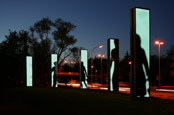
Reprojected
Reprojected – Mader/Stublic/Wiermann: A new site-specific light installation in Munich :: Until 31 March 2007.
Artificial light changes how we see cities, both in functional and, increasingly, in aesthetic terms. Its fascination for artists, designers and architects derives from the fundamental role played by light in human perception. Light can create spaces that exist independently of architectural constructions. Without light, images could not be generated, perceived or reproduced, in films, videos or anywhere else. The latest LED technology even permits images to be made from light. This approach has been adopted now in Munich by realizing the new OSRAM light platform SEVEN SCREENS which combines arts with cutting-edge technologies presented in the public space. In future, and up to twice a year, artists will be invited by OSRAM to develop works referring to the specific context.
Reprojected by Media artists Mader and Stublic, and architect Wiermann, based in Berlin / Karlsruhe, engages in a site-specific and medium-specific way with visual perception. The artists have created a virtual space around the seven light steles. Light apparently coming from elsewhere seems to strike the steles like a spotlight. For the viewer, real space and virtual space appear to co-exist, the two realms intersecting at the masts. Computer-generated figures appear in front of the light and are reproduced as silhouettes on the masts, before disappearing into the surrounding darkness.
Curator of the new OSRAM SEVEN SCREENS is art historian Christian Schoen, director of CIA.IS – Centre for Icelandic Art, Reykjavik, since 2005 and curator of the Icelandic contribution to the 2007 Venice Biennale. Schoen has headed the OSRAM GALLERY since 2001.
Holger Mader (born in Basel in 1970 and based in Berlin), Alexander Stublic (born in Saarbrücken in 1967 and based in Karlsruhe [ZKM] and Berlin) and Heike Wiermann (born in Leipzig in 1971 and based in Berlin) have acquired a national and international reputation for their dynamic multimedia installations involving light. Their best-known projects include a recent piece at the Uniqa Towers in Vienna and the video installation CUBE, currently showing at the new Museum Ritter in Waldenbuch.
Press contact
Goldmann PR, Daniela Goldmann
Bruderstrasse 5, 80538 Munich, Germany
phone +49(0)89-2111-6413, e-mail: info[at]goldmannpr.de
Posted by jo at 05:52 PM | Comments (0)
December 15, 2006
Futuresonic 2007

Social Technologies Summit
Social Technologies Summit - register before end of december :: Special Advance Booking Rate *Available till 31 December* £25 (Normally £45) :: The Delegate Pass gives you access to all Futuresonic seminars and talks, the Social Technologies Summit, and entrance to Futuresonic Live events over the festival weekend. See here for details. A part of Futuresonic 2007
SOCIAL TECHNOLOGIES SUMMIT: The main conference strand of the Futuresonic festival, the Social Technologies Summit, is a major international conference exploring the creative and social potential of new technologies, bringing together leading figures to explore "a whole new way of doing things in the air".
The Social Technologies Summit promotes technology as social practice, and explores the social impact of technologies, in particular a new generation of network technologies that are increasingly embedded in the social sphere. It looks at how people collaborate to make or use technology, at the way in which certain technologies can create an extension of social space or support group interaction, and asks how we can make technology more social.
ENVIRONMENT 2.0
In 2007 a focus of the Social Technologies Summit is ENVIRONMENT 2.0, a new international initiative in which two worlds collide:
o The world is waking up to realities of climate change, long predicted but until now too easy to ignore.
o The world is in love with smart environments, mobile communication, pervasive media, wearable computing.
Can these two approaches to environment, each one iconic for our times, be reconciled?
The Social Technologies Summit will host a network meeting for ENVIRONMENT 2.0, and present the findings of a pioneering study of the carbon footprint of the Futuresonic festival, undertaken in collaboration with Creative Concern and Tyndall Centre for Climate Change Research.
FREE-MEDIA
A linked focus is FREE-MEDIA. Free-media is about finding inspiration and resources in our built and natural environment that were previously dismissed as being without value or irrelevant. It doesn't cost much because it makes use of public domain Free and Open Source Software, and recycles freely available old equipment, waste materials and junk (FOSS). Free-media increases access to media technologies, especially to the people who need it most and can afford it the least, and lowers environmental impact of the media we produce and consume.
THE MAP DESIGNERS
The 2007 Summit will also play host to THE MAP DESIGNERS, an event drawing together map hackers, artists, cartographers, DIY technologists, architects, game programmers, bloggers and semantic web philosophers. Presented by the British Cartographic Society, the event will focus upon the interface between cartography and cutting edge design.
FUTUREVISUAL
As the main conference strand of the Futuresonic festival, the Social Technologies Summit will also host discussions of the festival's artistic themes. In 2007 this will involve a conference strand supporting Futurevisual, a city wide celebration of future image and sound. It will mark the 40th anniversary of the first multimedia events of the kind that we would understand today, which took place in the halcyon year of 1967, the year that also saw the first crossover between avant garde and popular music, and the introduction of the Moog synthesiser. The conference will feature seminal figures from the period, alongside contemporary artists who can connect with the energy and openness of 1967, and bring it bang up to date.
FUTURESONIC 2007
Futuresonic, the urban festival of electronic arts and music, is moving from July to May, back to the Spring date it occupied in 2004. Futuresonic 2007 will feature profile music events in Futuresonic Live, and art and technology events in Urban Play, a strand of the festival introduced in 2006 that has since been mirrored in other events in the UK and Europe.
DELEGATE PASS
Advance Booking Rate
£25 (Normally £45)
Reserve your discounted Delegate Pass before December 31st 2006 and
make payment by January 31st 2007
http://www.futuresonic.com/07/bookings.html
The Delegate Pass gives you access to all Futuresonic seminars and talks, the Social Technologies Summit, and entrance to Futuresonic Live events over the festival weekend. You must reserve your discounted Delegate Pass before December 31st 2006 and make payment by January 31st 2007. To reserve email tickets2007[at]futuresonic.com stating your name, address and contact details. You will be sent purchasing information from the festival box office by January 8th 2007.
Posted by jo at 06:39 PM | Comments (0)
Daan Roosegaarde talks about Dune 4.0

"Alice in Technoland"
Dune 4.0, developed by Daan Roosegaarde, is an interactive landscape which physically changes its appearance in accordance to human presence.
Placed in the main corridor of Montevideo (Amsterdam, NL), Dune 4.0 is composed of hundreds of fibers which react to the movements and sounds made by the visitors. This hybrid of nature and technology functions as a platform on which the relationship between visitor and the existing architecture is enhanced. By means of looking, walking and interacting, visitor and space merge into one coherent environment which could be best interpreted as a kind of "Alice in Technoland".
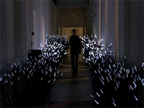
Dune 4.0 is currently further developed for a public site besides the river Maas in Rotterdam.
It's not the first time i mention Roosegaarde's projects. He has previously designed, among other projects, 4d pixel, a smart surface which physically reacts to your voice, music and can write relievo letters and Liquid 2.0, a living cocoon which physically reacts to your motion and sounds. This time i decided to ask him a few questions about his latest piece. More >> [blogged by Regine on we-make-money-not-art]
Posted by jo at 08:31 AM | Comments (0)
Bruce Sterling's

Final Prediction
"The future of the Internet lies not with institutions but with individuals. Low-cost connections will proliferate, encouraging creativity, collaboration, and telecommuting. The Net itself will recede into the background. If you're under 21, you likely don't care much about any supposed difference between virtual and actual, online and off. That's because the two realms are penetrating each other; Google Earth mingles with Google Maps, and daily life shows up on Flickr. Like the real world, the Net will be increasingly international and decreasingly reliant on English. It will be wrapped in a Chinese kung fu outfit, intoned in an Indian accent, oozing Brazilian sex appeal.
One upshot is that futurism itself has no future. Once confined to an elite group, the tools and techniques of prognostication are all widely available. As for pundits: The world used to be full of workaday journalists, with just a thin sprinkling of opinion mongers. Now a TypePad account is a license to deliver nose-to-the-pavement perspective with an attitude. The very word futurism is old-fashioned, way too 1960s. Today's Internet-savvy futurist is more likely to describe himself as a strategy consultant or venture capital researcher. That development doesn't surprise me. Frankly, I saw it coming." From My Final Prediction by Bruce Sterling, Wired.
Posted by jo at 08:15 AM | Comments (0)
December 14, 2006
Wikinovela
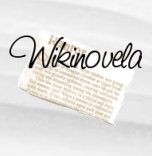
A Tale of Multiple Tongues
Wikinovela — A Tale of Multiple Tongues :: From the 3rd Congress of the Cybersociety comes: Wikinovela.
If the wiki is a definitive collaborative technology, what happens when a group tries to write a multilingual novel using the form?
[What follows is a commentary on the project involving a bit of translating and paraphrasing of the conference essay “Wikinovela: a project of hypertextual, collaborative, and multilingual creation on the Internet” by Patricia Fernandez Carrelo and Santiago Perez Isasi.]
Produced by the Faculty of Philosophy and Arts of University of Deusto (Bilbao, Spain) under a Creative Commons license, Wikinovela began April 24, 2006 and eneded July 24, 2006. Over the course of the three-months, the collaborators produced a work that stretches across languages: Castilian, euskara (Basque), and English. That is not to say that the work has been translated, but that distinct parts of Wikinovela appear in each language.
Participants could modify the text of others, continue any of the on-going storylines, create new plots (or “hypertextual ramifications” of a plot), or add metanarrative commentaries. More >> [blogged by Mark Marino on WRT]
Posted by jo at 05:24 PM | Comments (0)
Processpatching:

Defining New Methods in aRt&D
We would like to invite you to view the online version of Processpatching: Defining New Methods in aRt&D, a PhD thesis by Anne Nigten.
V2_ invited Anne Nigten to start the V2_Lab in 1998. She coined the term ‘aRt&D’ to refer to research and development involving art and technology. One of the next steps in aRt&D will be to formalise its assembled working methods, which can be seen as essential ingredients for interdisciplinary collaboration.
As manager of the V2_Lab, Anne Nigten decided to investigate how electronic art patches together processes and methods originating in the arts, engineering, and computer science. Her thesis provides a framework for understanding electronic art’s method, through informing others about one’s own artistic research-and-development approach, this thesis contributed to improving the collaboration among artists, technicians and computer scientists. She conducted her investigation in the V2_Lab, an electronic-art laboratory where artists establish new alliances with other disciplines. The thesis contains unique information about specific cases of projects developed or presented in the V2_Lab between 2002 and 2005. It provides sharp observations and analyses of the practical and theoretical aspects of artists’ research and development processes.
Nigten’s study addresses fundamental questions about the research and development methods of artists involved in interdisciplinary collaborations between and among the fields of art, computer science, and engineering. The artistic methods cited in her thesis include examples from a broad range of fields (such as technology, media arts, theatre and performance, systems theories, the humanities, and design practice), which are relevant to and intrinsically intertwined with this project and its position in an interdisciplinary knowledge domain.
Anne Nigten participated in the SMARTlab program at Central Saint Martins College of Art & Design, University of the Arts London. Her supervisors were Professor Lizbeth Goodman, James Swinson and Professor Lynda Hardman.
This thesis has been realized with the support of V2_, Institute for the Unstable Media and Multimedian.
Posted by jo at 04:04 PM | Comments (0)
Environmental Awareness through Eco-visualization

Combining Art and Technology to Promote Sustainability
Abstract: Eco-visualization technology made by media artists offers a new way to dynamically visualize invisible environmental data. Eco-visualization can take many forms. My own practice of eco-visualization involves animating information typically concealed in building monitoring systems, such as kilowatts or gallons of water used. A public display with real time visual feedback promotes awareness of resource consumption and offers a practical alternative to remote meters concealed in utility closets. The long-term goal of most eco-visualization practitioners is to encourage good environmental stewardship using hybrid practices of art and design. This essay contextualizes the emerging field of eco-visualization and its interdisciplinary trajectories. Environmental Awareness through Eco-visualization: Combining Art and Technology to Promote Sustainability by Tiffany Holmes, Neme.org.
Posted by jo at 03:32 PM | Comments (0)
susana mendes silva's
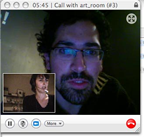
art_room
art_room: Don't be afraid to ask everything you always wanted to know about contemporary art.
My Skype name is susana_mendes_silva, call me.
art_room (#3) :: Saturday December 16, 1:00pm - 3:00pm (CT) | 7:00pm - 9:00am (GMT) :: Untitled [ArtSpace] Upgrade! International: DIY, Oklahoma City.
susana mendes silva :: arslonga[at]netcabo.pt
Posted by jo at 01:59 PM | Comments (0)
transmediale.07: unfinish!

Performances
transmediale.07: unfinish! :: January 31 - February 4, 2007 :: Akademie der Kuenste, Berlin, Hanseatenweg 10.
Performances: 1. Pierre Bastien - Orchestre mecanique :: 2. Institut fuer Medienarchaeologie - Nightline :: 3. Richard Chartier / Taylor Deupree - Specification.Fifteen :: 4. Edition Edison :: 5. Chris Salter - Schwelle 1 & 2.
1. Pierre Bastien (fr) - Orchestre mecanique :: Opening transmediale.07, 30.1. 2007, 19 hrs, Akademie Hanseatenweg, Studio 1 (by invitation only): During the opening ceremony of transmediale.07, French artist Pierre Bastien presents his unique 'Orchestre mecanique', an orchestra made of Meccano parts, electro-motors and acoustic instruments from all over the world. According to the type of instrument that is included, each automaton plays a short melody, a rhythm or some harmony repeated in a loop.
'The dream of a composer: An orchestra on the fingertip, which gently fulfils every command: A timeless-melodic orchestra, futuristic and a bit dadaistic at the same time, which evokes ancient traditions in its astoundingly sensual music. This is, depicted in a few words, Pierre Bastiens 'Mecanium', a sort of daydream, which he pursues since 1976. The musicians of his orchestra are machines. The idea behind all this is simple, effective and poetic. Traditional instruments (Chinese sounds, Moroccan bendir, Javanese saron, koto, violin, sanze, etc.) are played by a mechanical instrument consisting of parts of a Meccano construction kit and re-used gramophone motors. These hybrid and self-playing sound-sculptures perform a series of short hypnotic pieces.' (Michel F. Cote)
Pierre Bastien (born in Paris, 1953) post-graduated in eighteenth-century French literature at University Paris-Sorbonne. In 1977 he built his first musical machinery. For the next ten years he has been composing for dance companies and playing with Pascal Comelade. In the meantime he was constantly developing his mechanical orchestra. Since 1987 he concentrates on it through solo performances, sound installations, recordings and collaborations with artists such as Pierrick Sorin, Karel Doing, Jean Weinfeld, Robert Wyatt or Issey Miyake.
Pierre Bastien will also be playing in a special programme of Club Transmediale at Volksbuehne, Rosa-Luxemburg-Platz, on 25.1. 2007
2. Institut fuer Medienarchaeologie (at) - Nightline
Wednesday, 31.1. 2007, 21 hrs, Akademie Hanseatenweg, Studio 1
With a range of different performances the Austrian Institut fuer Medienarchaeologie (IMA) focuses especially on the sonic arts and presents artists and compositions with diverse instruments and sound events.
For several years, Rebekah Wilson aka Netochka Nezvanova was pure fiction. Calling herself after a literary character of Fjodor Dostojevskij's, the trained composer was haunting the net as an Enfant terrible, anti-pop star, and digital icon. She re-appeared as a physical person in 2002 and was a curator at the STEIM in Amsterdam. In her current rebirth-phase as Rebekah Wilson she found her way back to her home country New Zealand. In the performance 'A History of Mapmaking' she uses the cello live to create sound and to manipulate sound events. (Compositions and performance: Rebekah Wilson)
The performance entitled '4:3' is a resonating memory trace transforming the experiments of Leon Theremin (Lev Sergejewitsch Termen) who worked with the avant-garde filmmaker Mary Ellen Bute in the 30s in his New York studio connecting light and sound to his 'Lichtmusik'. His idea of merging light, sound and movement opens up an exciting field for research and experiments, particularly in using digital technologies. (Compositions and electronics: Elisabeth Schimana, flute: Cordula Boesze, Terpsiton: Elena Golovasheva, instrumental design: Andre Smirnov)
In 'ghost engine - Sprechen ohne Sprache' (talking without language) two writers try to communicate without using any language. The Theremin, one of the first musical instruments designed to be played without being touched, develops the 'speech' that Liesl Ujvary and Ann Cotton explore experimentally. Additionally they play the Kaosspad (a device for music effects), and use the laptop to filter the Theremin's sounds. The emerging compositions create a panorama of human existence: straight, moving and non-verbal. (Theremin and electronics: Liesl Ujvary and Ann Cotton)
Ushi Reiter's 'Turntabel Improvisationen' brings scratching records, needles in the groove and scraps of sound into a dialogue with static sound waves and space. The performance starts with 20th century sound material produced exclusively by women. In addition to the pieces from net archives, works of contemporary sound producers will also play a key role. Vinyl records will be produced especially for Ushi Reiter's performance.
IMA is dedicated to the research and mediation of artistic practice of technological sound and visuals. As a main focus within this context IMA digs out female production of electronic art, incorporates it into the historical context and re-visualises these works for a wider audience.
3. Richard Chartier / Taylor Deupree (us) - Specification.Fifteen Honourable Mention transmediale Award 2007 Friday, 2.2. 2007, 21 hrs, Akademie Hanseatenweg, Studio 1
'Specification.Fifteen' evokes the stillness of the spaces of Hiroshi Sugimoto's seascapes which suggest infinite change under a seemingly uniform surface. Inspired by Sugimoto's series of photographic seascapes, sound artists Richard Chartier and Taylor Deupree created their piece on the occasion of a retrospective exhibition of the renowned Japanese photographer. 'Specification.Fifteen' will be on display as an audio-piece at transmediale's exhibition, and will be presented as a live performance by the artists in a European premiere.
Richard Chartier (born 1971), sound and installation artist, explores in his work the interrelationships between the spatial nature of sound, silence, focus, and the act of listening. In 2000 he formed together with Taylor Deupree the recording label LINE, presenting compositions and installations by international sound artists and composers. Taylor Deupree (born 1971) is a sound artist, graphic designer, and photographer residing in New York. Founder of the music labels 12k, LINE and Happy, he devotes his work to the aesthetics of the contemporary and the development of the digital minimalism, often in collaboration with other artists. http://3particles.com/ http://www.12k.com/
4. Edition Edison: Nicholas Bussmann (de), FM3: Christiaan Virant (us)/Zhang Jian (cn), Aleks Kolkowski (uk), Nicolas Collins (us)
Workshop-Installation: Thursday through Saturday (1.-3.2. 2007) all day
Performance: Saturday, 3.2. 2007, 18 hrs
Akademie Pariser Platz, Foyer
For more than a century physical sound-storage media, from the cylinder of the Edison phonograph to the CD, have made music something to be owned - an special liaison between music and object. The LP managed to become a fetish; the CD's days are already numbered. With the emergence of the standardised compression format MP3 and the Internet, sounds are once again roaming freely.
The workshop-installation 'Edition Edison' is on display during the festival at the foyer of the Academy's new building on Pariser Platz. The artists Nicholas Bussmann, FM3 (Christiaan Virant, Zhang Jian), Aleks Kolkowski and Nicolas Collins will manufacture artistic storage media, thus commenting the immateriality of digital sounds. The performance on Saturday evening will be a live concert, where the artists work with the storage media that has been produced during the preceding days. - Edition Edison is a project by Nicholas Bussmann in cooperation with the Diaphanes publishing company.
Nicholas Bussmann is a musician, composer and curator, living and working in Berlin. He started his career as a cello player, but went for the new possibilities provided by computer and electronic devices. He is focusing more on performing music rather then recording it, and he is working on conceptual compositions and game structures. Bussmann is curator of the annual Grand Prix d'Amour in Berlin.
FM3: Christiaan Virant is a Beijing-based sound artist and musician. Active in the Chinese punk underground for nearly a decade, he founded the experimental electronic act FM3 in 1999. Zhang Jian is China's top session keyboarder and leading computer musician. He has appeared on nearly every underground rock release over the past decade and was a member of many seminal Chinese rock acts.
Aleks Kolkowski was born in London, and is based in Berlin since 1995. He performed in experimental music ensembles, and was working as an improvising musician, interpreter, composer and actor. His most recent work is concerned with the pre-electronic, mechanical technology of gramophones, phonographs and horned violins.
New York born and raised, Nicolas Collins studied composition at Wesleyan University (Connecticut). He worked as a composer and presented his audio-installations in the USA, Europe, South America and Japan. He was Visiting Artistic Director of Stichting STEIM (Center for Research & Development of instruments for performance arts) in Amsterdam and a DAAD composer-in-residence in Berlin. Since 1997 he has been editor-in-chief of the Leonardo Music Journal.
5. Chris Salter (us) - Schwelle 1 & 2
1.-3.2. 2007, daily 20.30 hrs, TESLA, Kubus
'Schwelle' is an extensive media art project of three parts about the most ancient theme of mankind. It explores the limits of conscience on the cusp of death. TESLA presents part 1 and 2 during the festival transmediale.07. Both parts refer to the Tibetan Book of Death, the holy scriptures, which is read to dying persons in their last minutes of life, in order to guide them through the chaos of the passage from life to death.
Part 1 is a stormy meditation, in which one can undergo the moments before death through picture language and sound. In part 2 the spectators experience one single artist, Michael Schumacher, long-time dancer at the Ballet Frankfurt. The environment in 'Schwelle' is enlarged by wireless electronic sensors, so that the artists movements and gestures interact with his surrounding. This interaction controls light, sound and objects in real-time and develops its own choreography. In this environment the artist fuses with the room surrounding him.
Chris Salter studied economics and philosophy and completed in the areas of theatre and computer-generated sound at Stanford University. He has collaborated with, among others, Peter Sellars, and William Forsythe and the Ballett Frankfurt. He co-founded the art+research organisation 'Sponge', whose works stretch between the areas of performance, installation, scientific research and publications and have been shown at several festival festivals around the world. Salter works at Concordia University, Montreal. http://clsalter.com http://sponge.org
transmediale.07 - 31 january - 4 february 2007 :: festival for art and digital culture berlin :: transmediale - Klosterstr. 68 - 10179 Berlin :: tel. +49 (0)30.24749-761 fax. +49 (0)30.24749-814 info[at]transmediale.de - http://www.transmediale.de
Member of the European Coordination of Film Festivals
Posted by jo at 01:34 PM | Comments (0)
Body Politics in the Americas

Call for Submissions
6th Encuentro
CORPOLíTICAS / BODY POLITICS IN THE AMERICAS: Formations of Race, Class and Gender at the Centro Cultural Recoleta and the Teatro Empire with the collaboration of Instituto Torcuato Di Tella June 8-17, 2007 in Buenos Aires, Argentina. APPLICATION DEADLINE JANUARY 15, 2007
THE HEMISPHERIC INSTITUTE OF PERFORMANCE AND POLITICS and the Centro Cultural Recoleta in Buenos Aires invite artists, performers, academics and activists to propose performances, papers, performance-based scholarship (scholarship that attempts to enact what it describes), videos, installations, visual art exhibits, work group topics, activist projects, hacktivist or virtual actions, and other forms that bring together performance and politics in the Americas to participate in our upcoming 6th Encuentro
CORPOLíTICAS / BODY POLITICS IN THE AMERICAS: Formations of Race, Class and Gender.
Since 2000, the Encuentros of the Hemispheric Institute have been a meeting place for artists, scholars, students, and activists investigating the relation between performance and politics in the Americas. Gathering between 300 and 400 participants, each Encuentro is part academic conference, part performance festival, part workshop series, and wholly interdisciplinary: it is a concentrated space of experimentation, dialogue and collaboration, featuring lectures, performances, installations, roundtable discussions, exhibits, video screenings, work groups and hands-on performance workshops.
Our upcoming Encuentro in Buenos Aires will focus on body politics: the politics of the body, political bodies, bodies politic, and the relations between them. We are particularly interested in the formations of race, class, sexuality, ethnicity, and gender articulated through body politics in different eras, geographies and imaginaries in the Americas. We understand the body as a site of negotiation, discipline, and a means of expression and meaning.
We are seeking groups or solo artists (for all areas of our performance and exhibition program, for both indoor and outdoor spaces:
Performance: Feature-length (2 hours or less), Short (30 minutes or less), and Cabaret/Bar interventions (“after-hours”). We’re calling for a wide range of performances, from traditional representations to hybrid and contestatory practices. For art exhibitions, installations and film/video, there are wonderful spaces at the Centro Cultural Recoleta, which is a prime venue for the arts in Buenos Aires. The Centro also has a small movie theater, which will allow for screenings throughout the event. These film and art exhibition spaces will be open to the public.
For more information and to apply online.
Posted by jo at 12:15 PM | Comments (0)
Fake Your Space
![]()
Not Popular Enough?
Welcome to Fake Your Space. You have found a new and exciting service which offers help to all the men and women out there who don't feel like they are popular enough on social networking sites such as MySpace, Facebook, and Friendster. If you are tired of seeing everyone else with the hottest friends and want some hotties of your own, then this is the place for you.
CAN I PICK mY FRIENDS? Of course you can! This is what Fake Your Space is all about. You can pick the hottest looking friends to leave you messages. We have a wide selection of men and women of all ethnic backgrounds.
Posted by jo at 12:00 PM | Comments (0)
Second Life
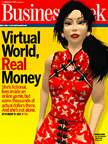
Clay Calls "Bullshit" on Second Life
Clay Shirky demands to see Second Life's hand in a recent article on Valleywag that calls bullshit on the virtual environment's numbers - and the crazy press coverage it's been getting lately.
I've always said there was something over the top about the whole Second life thing. I know it's a media darling right now, but how many people actually play it? And for how long?
When Clay writes, "I have been watching the press reaction to Second Life with increasing confusion" he mirrors my reaction. With every huge article in Businessweek the hype tree grew taller and bore ever more verdant leaves, seeding other articles in other publications. (I don't mean to call out Businessweek except that they published the most outrageous "Virtual Millionaire" article recently.) And while, yes, money in virtual economies is real, as Julian and Ted Catronova have shown (among others), how real is the money in a good if you hold all the goods yourself? It's only worth as much as others will pay for it and frankly, I'm just not sure that a userbase exists that *will* pay, collectively, a million bucks for virtual real estate.
I respect what Second Life is, and I think some of the press is well-deserved. It is a concrete way to imagine what we used to call cyber-space. I just don't think there's anything close to a mass movement represented by its users - just really interesting new ideas. [posted by Jane on Game Girl Advance]
Posted by jo at 10:54 AM | Comments (0)
CFP for MiT5: Creativity, Ownership, Collaboration

Call for Submissions
The Media in Transition Project at MIT now seeks submissions for MiT5: Creativity, Ownership, and Collaboration in the Digital Age: Submission deadline: Jan. 5, 2007.
Our understanding of the technical and social processes by which culture is made and reproduced is being challenged and enlarged by digital technologies. An emerging generation of media producers is sampling and remixing existing materials as core ingredients in their own work. Networked culture is enabling both small and large collaborations among artists who may never encounter each other face to face. Readers are actively reshaping media content as they personalize it for their own use or customize it for the needs of grassroots and online communities. Bloggers are appropriating and recontextualizing news stories; fans are rewriting stories from popular culture; and rappers and techno artists are sampling and remixing sounds.
These and related cultural practices have generated heated contention and debate. What constitutes fair use of another’s intellectual property? What ethical issues are posed when sounds, images, and stories move from one culture or subculture to another? Or when materials created by a community or religious or ethnic tradition are appropriated by technologically powerful outsiders? What constitutes creativity and originality in expressive formats based on sampling and remixing? What obligations do artists owe to those who have inspired and informed their work and how much creative freedom should they exercise over their borrowed or shared materials?
One source of answers to such questions lies in the past, in the ways in which traditional printed texts, and films and TV shows as well invoke, allude to and define themselves against their rivals and ancestors; and, perhaps even more saliently, in the ways in which folk and popular cultures may nourish and reward not originality in our modern sense, but familiarity, repetition, borrowing, collaboration.
This fifth Media in Transition conference, then, aims to generate a conversation that compares historical forms of cultural expression with contemporary media practices. We hope this event will appeal widely across disciplines and scholarly and professional boundaries. For example, we hope this conference will bring together such figures as:
:: anthropologists of oral and folk cultures
:: historians of the book and reading publics
:: political scientists and legal scholars interested in alternative approaches to intellectual property
:: media educators who aim to help students think about their ethical responsibilities in this new participatory culture
:: artists ready to discuss appropriation and collaboration in their own work
economists and business leaders interested in the new relationships that are emerging between media producers and consumers
:: activists and netizens interested in the ways new technologies democratize who has the right to be an author
Among topics the conference might explore:
:: history of authorship and copyright
:: folk practices in traditional and contemporary society
:: appropriating materials from other cultures: political and ethical dilemmas
:: poetics and politics of fan culture
:: blogging, podcasting, and collective intelligence
:: media literacy and the ethics of participatory culture
:: artistic collaboration and cultural production, past and present
:: fair use and intellectual property
:: sampling and remixing in popular music
:: cultural production in traditional and developing societies
:: Web 2.0 and the “architecture of participation”
:: creative industries and user-generated content
:: parody, spoofs, and mash-ups as critical commentary
:: game mods and machinima
:: the workings of genre in different media systems
:: law and technological change
Short abstracts of no more than 200 words for papers or panels should be sent via email to Brad Seawell at seawell[at]mit.edu no later than January 5, 2007 . Brad can be reached by phone at 617-253-3521. Email submissions are preferred, but abstracts can be mailed to:
Brad Seawell
14N-430
MIT
Cambridge , MA 02139
Please include a short (75 words or less) biographical statement.
This will be our fifth media in transition conference. The previous conferences were the inaugural Media in Transiton conference, MiT2: globalization and convergence , MiT3: television and MiT4: the work of stories.
The call for papers was posted here, on the MiT site: http://web.mit.edu/comm-forum/mit5/subs/MiT5_call.html
Posted by jo at 10:30 AM | Comments (0)
Digimag 19
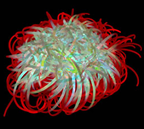
Now Online
The English Version of Digimag 19, Italian Monthly e-Magazine of Digital Culture and Electronic Arts, is Available Online :: DIGIMAG ENGLISH VERSION - #ISSUE 19 - NOVEMBER 06.
[Interviews]: Alex Dragulescu, Sergio Messina, Laurent Marques, Playing Music [Featuring]: Eddo Stern, 1st Avenue Machine, Kenneth Kirschner, Kinkaleri, Jankowski/Ahtila, Archimedes Project [Reports]: Art Futura 06, Piksel 06, Cum2Cut, ClubToClub, Interfacce 06 [Themes]: Press in Second Life, My Space Vjing, Video Online, Compendio di cultura open.
Posted by jo at 09:18 AM | Comments (0)
December 13, 2006
Final Appeal for Support
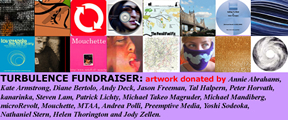
Ensure our Survival
Dear Friends,
Your donation will ensure that we continue to bring vital resources to marginalized artists and their audiences. New Radio and Performing Arts, Inc. has expanded its support for emerging and established artists through its commissioning, exhibitions, and public events programs, and it provides valuable resources in Turbulence, the networked_performance blog and the New American Radio archive.
Choose from artists' books, drawings, DVDs, CDs, archival prints, T-Shirts and more or simply make a donation because you value what we do. Please go to our website and make a donation right now.
THANK YOU.
Jo and Helen
Posted by jo at 12:27 PM | Comments (0)
Space and Culture

CFP: The Place of Synthetic Worlds
CFP: The Place of Synthetic Worlds :: Special issue of Space and Culture edited by Eric Gordon. 500 word abstracts are due by March 2, 2007. Completed essays are due July 16, 2007. All questions and abstracts should be directed to Eric_Gordon[at]emerson.edu.
Synthetic worlds can now claim tens of millions of members. From game environments such as World of Warcraft to the social environment Second Life, these avatar-driven platforms are becoming central to the wider networked culture. Increasingly, users don’t require a game pretense to spend time in synthetic space, they log on to socialize, conduct business, go to meetings, wander around or shop. Linden Lab’s platform Second Life is leading the way in this. Distinct from other Massively Multiplayer Online Role Playing Games (MMORPGs), there are no missions, goals, or winners in Second Life. Artists take up residence there; academic conferences are conducted there; and increasingly, institutions are establishing themselves there: Harvard and the University of Southern California have campuses, Reuters recently opened a Second Life bureau, the CDC opened an office to promote safe sex and emergency preparedness, Sony is positioning itself to deliver content, and Nike has started selling virtual shoes. As societies take shape in this environment, it has become quite clear that for most users, the second life looks remarkably like the first one. Users are engaging in everyday activities with represented environments (Sims) that are surprisingly similar to their real life counterparts. Consequently, Second Life cannot accurately be called “virtual” reality; more to the point, it is a synthetic world that produces a mixed reality through immersive digital social networks.
This issue of Space and Culture will explore the function of place in virtual spaces. It will examine how individuals, communities and institutions form identities in relation to sims. And it will interrogate the role of “real-world” places and networks in the construction of meaningful “virtual” spaces.
While Second Life presents a fascinating case study in the evolution of synthetic worlds, papers need not be limited to that platform. Possible topics include:
dwelling in virtual space
public vs. private
inside vs. outside
physical vs. virtual
home
shopping and place
place of sex
youth culture and “hanging out”
the place of the virtual classroom
landmarks, memorials, parks
location in the virtual real estate market
cityscapes
virtual place blogging
local journalism
institutions
ritual
art practice
Eric Gordon
Assistant Professor
Department of Visual and Media Arts
Emerson College
120 Boylston Street
Boston, MA 02116
(617) 824-8828
Posted by jo at 11:08 AM | Comments (0)
Haiku Trader
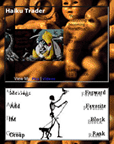
Distributed Creativity and MySpace
Haiku Trader is a new media poetry / performance artwork that began in 2005. The art work as such utilises the social network myspace as a virtual collaborative space investigating the theme of distributed creativity and aesthetics. Practically speaking, what this means is that the work is not 'limited' to this profile but must be conceptualised as the network it involves progressively over time. This network can be explored through the virtual traces left as haiku 'comments' throughout the myspace community as well as in the group which this profile acts as 'moderator' for - Desert Islands.
Leon Tan works as a lecturer and psychotherapist at AUT University, and as a consultant for an ICT company Cogitatus Solutions. He is also a doctoral candidate in art history and film tv & media studies at the University of Auckland. He researches interactivity, psychoanalytic social theory, social and cultural software. He is also a new media poet / artist. His current work experiments with distributed authorship in poetry utilising social software platforms. [posted on Rhizome]
Posted by jo at 11:07 AM | Comments (0)
Microcity
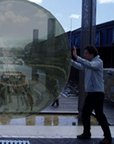
City of Data
Microcity by stanza :: Live CCTV webcams onto roving display device. Collects data from 400 cameras and randomly presents morphed real time image. The increase of technology infrastructure in the daily existence of a city means that technology will, more than ever be everywhere in our environment. Data mining will be part of the fabric of the landscape. Everything is or will be tracked. cctv, car sensors, tracking inside our phones and id card movement tracking in the guise of anti- terror activity. The patterns we make, the forces we weave, are all being networked into retrievable data structures that can be re-imagined and sourced for information. These patterns all disclose new ways of seeing the world.
New metaphors relevant to the experience of the city. New polymer display material captures images. Images sent over network. A city of data balls with retrievable narrative for experience. Social sculptures contain information zones, banking data, etc.. Narratives from huge libraries of online videos images stories System accesses national data archives.
Stanza is a London based British artist who specializes in net art, networked art, and electronic sounds. His award winning online projects have been invited for exhibition in digital festivals around the world, and Stanza also travels extensively to present his net art, lecturing and giving performances of his audiovisual interactions. His works explore artistic and technical opportunities to enable new aesthetic perspectives, experiences and perceptions within context of architecture, data spaces and online environments. [posted on Rhizome]
Posted by jo at 11:01 AM | Comments (0)
Digestive Table
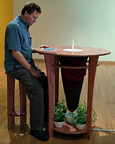
A Waste Processing System
Digestive Table by Amy Youngs: A living ecosystem of worms, sowbugs and bacteria are invited to this table. They are a part of the digestive system that starts with a person discarding food leftovers and shredded paper into the portal at the top. The bacteria and sowbugs begin breaking down the waste and the worms soon join in to further digest it into a rich compost that sprinkles out of the bottom of the fabric bag that hangs beneath the table. This compost is used as a fertilizer for plants, such as those at the base of the table.
The human plays an important part at the table by eating, feeding the food waste to the worms, feeding the resulting fertilizer to the plants, or by simply sitting and appreciating the living ecosystem she/he is a part of. A cross-section of the activity inside the top 9 inches of the compost is made visible using an infrared security camera connected to an LCD screen built into the table. On the screen, viewers can see the live movements of the worms and sowbugs inside. [via]
Posted by jo at 08:26 AM | Comments (0)
Christina Ray's Interview with

Adam Greenfield
Interview with Adam Greenfield by Christina Ray :: Commissioned by Rhizome.org
I recently met up with Adam Greenfield, author of Everyware: The Dawning Age of Ubiquitous Computing, to discuss the book's ideas over coffee. Everyware was published in 2006 and draws upon Adam's background as a user experience consultant and critical futurist to describe the subtle yet persistent diffusion of computing technology into the landscape. Against the espresso machine hum, the cafe's iPod shuffling through indie rock tunes, and the register jingle, we talked about speed and convenience as the seductions that drive our increasingly mediated reality. And we pondered the cultural, ecological, and ethical costs of living with everyware and where we go from here .
CR: From where we are right now, what kinds of everyware or pre-everyware can you identify?
AG: Remember when you were a kid, and you were first writing letters to your friends, and you'd lavish a ridiculous amount of detail on the return address? "127 North Van Pelt Street, Philadelphia, Pennsylvania, 19103, USA, North America, Earth, the Solar System"? It turns out that "where," in the everyware context, is a little like that -- in order to give you an answer as to "where I am right now," in the sense that's most relevant to this discussion, I'd have to specify all the situations and contexts in which I'm presently implicated.
Some of these situations are physical, and they're unfolding at a nested series of scales. So I'm simultaneously in the United States, and in Brooklyn, and at the given address of this cafe. And, of course, I also happen to be in a room, and sitting at a table, and in close proximity to an array of tools and devices at that scale.
At the most global scale, I'm already implicated in ubiquitous systems, at this very moment, by dint of those ghostly traces of me that exist in networked databases -- property register, driver's license, utility accounts -- and which associate me with this location. Those, in turn, can be correlated with an IP address that locates me virtually. In front of me are my mobile phone and wallet and transit pass, lying on the table, and those things are all either presently networked or designed to be used with the global information network.
Increasingly, we inhabit what I think of as an order of networked things. I think of each of them, as diverse and heterogeneous and apparently unrelated as they are, as nothing other than tendrils of ubiquity. All that would be necessary for these things to constitute everyware, in the sense I discuss in the book, is for them to start talking to one another -- and we're already beginning to see the signs of just such a convergence.
All of this is a way of saying that, if you want to detect the traces of emergent ubiquity in the world around you, it can't hurt to cultivate a certain sense of the paranoid-critical. Look around you: It's there to be seen, if you have but the eyes to see it.
CR: You've described a sense of wonder at seeing how women in Hong Kong almost immediately adapted to a new subway entrance system by simply swishing their handbags containing their passes over the turnstile's RFID reader. This lets them glide on through without having to stop, and was a completely self-taught "dance" that emerged on its own. What other adaptive behavior have you encountered that responds to everyware in public space?
AG: One of the things I've really enjoyed about being out on the road so much this year, and giving my talk in so many places, is that people will come up to me afterward and tell me their own stories, share their own experiences of this nascent ubiquity.
So I'll get people saying that their academic department or their job has doors which are unlocked with the RFID nametags they're required to wear - but that men in these situations will leave these cards in their wallet, and the wallet in their back pocket, so that the interaction with the system consists of them half-turning and rubbing their ass on the card reader. I love that, and I'm particularly interested to see the sorts of language that emerge around behaviors like that.
But I've seen, probably, a great deal more behavior that has not yet adapted to the fact of our engagement with networked devices in public space. If you pay attention to this sort of thing, you see social conflict breaking out all along the fault lines, with concerns emerging around things like mobile phone etiquette, continuous partial attention, whether someone should stop messaging and look up from their Blackberry long enough to order a coffee, if you're justified in not tipping a cab driver if they're on a phone headset during your entire trip, and so on. And should we forget that surveillance is at least as much a question of Little Brother as of Big Brother, there's always the object lesson of 'Dog Poop Girl' (see link below) to keep in the back of our minds.
CR: In the book you propose several features that should be designed into everyware. Everyware should default to harmlessness; be self-disclosing; be conservative of face and time; and be deniable. Could you expand upon these ideas a little?
AG: I believe that when designers imagine systems that by their very nature assume a great deal of responsibility for the outcome of situations, that exert an outsized and even unprecedented influence on life chances, they should among other things be held to the very highest standards of ethical design. This goes beyond the idea of installing appropriate safeguards for identity and privacy -- it's not even properly a technical question, but a moral one.
However unfashionable or bourgeois it may be, I believe in all those good old Enlightenment values: that you always already have the inalienable right to your privacy, your time and self-determination and personal autonomy. You have the right to know that information about you is being collected, and by whom, and what they are proposing to do with that information. We should demand that the ubiquitous systems we're subjected to be designed in such a way as to respect these prerogatives -- further, that we be able to refuse exposure to any system which does not, at least in private space. (It's probably too late to assert any such principle in the public sphere.)
In that sense, there's nothing in the Everyware principles that's even specifically about ubiquitous computing: This conversation is older than history, and obviously far better heads than mine have taken it up.
CR: From conferences to new university courses to corporate marketing departments, the subject of ubiquitous computing is becoming ubiquitous. In your book, Thesis 69 reads, "It is ethically incumbent on the designers of ubiquitous systems and environments to afford the human user some protection." Are engineers, designers, students, and companies having discussions on the ethics of protecting users?
AG: I think that a vanguard few are, yeah, even if in the latter case it's only as a business differentiator. It's going to be exceedingly difficult for most engineers to consider these questions, though, for the very good reason that so often, the sorts of effects of ubiquitous systems that I personally find so worrisome can only be understood as emergent behavior. That is, they arise out of the free interplay of discrete, distributed, networked systems. We're talking about a class of behaviors that can't necessarily be predicted at design time, even in principle. I'm the first to admit that incorporating the sorts of prerogatives we've discussed into the design of new products and services is not at all a simple thing to ask for.
I think it really takes someone able to step back from a given device, or even a given technology, to discern how it will interact ecologically with the others already on the table, those currently emerging, and the pre-existing body of everyday cultural practices. Traditionally, this has been just where information architects and other user-experience professionals have had so much to offer, and I still I have high hopes that the UX community will rise to the challenge of everyware. As far as deep, ongoing conversations, though, I don't really see it happening. Not yet. And, you know, the hour is late.
CR: The emergence of everyware can be, as you describe in the book, often quiet and subtle. No one's shouting, "Hey we just developed a device that tracks your every movement." Unless or until a major techno-disaster forces problems into the public arena, how do concerned citizens identify what's frequently invisible?
AG: That's a great question, an absolutely crucial one, and I'm afraid I don't have a very good answer for it. About all I can offer is the suggestion that we all try to do a better job of questioning -- with rigor and honesty and fearlessness -- the assumptions undergirding every new technological product and service we're offered. Will this really make my life easier? What are some of the less-obvious implications of inviting this into my life? What might I be giving up in exchange for what this is offering me? And what would my world look like if everyone adopted it?
These, again, are not obvious questions, and we're just not used to thinking along these lines. So a big part of what I see myself as being engaged in is something very old-fashioned: consciousness raising. It's something I'm pursuing in the hope that I can both learn to make decisions about emergent technologies that I'll be happier with in the long run for myself, and help other folks do so as well, on their own behalf.
+ Christina Ray is an artist and curator living in Brooklyn and the founder of Glowlab, a project to support and develop art/tech experiments exploring the nature of cities. Glowlab produces the annual Conflux festival in New York.
LINKS:
+ http://www.studies-observations.com/everyware/
+ http://www.v-2.org
+ http://en.wikipedia.org/wiki/Dog_poop_girl
+ http://christinaray.com
+ http://glowlab.com
+ http://confluxfestival.org
Posted by jo at 08:15 AM | Comments (0)
December 12, 2006
Experiments in Art and Technology (E.A.T.)
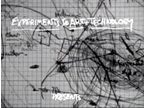
9 Evenings
Experiments in Art and Technology (E.A.T.), ARTPIX and Microcinema International announce 9 Evenings: Theatre & Engineering - a 10 DVD set of films on a legendary series of theater, dance, music and performances at the New York 69th Regiment Armory in 1966 by 10 New York artists: Robert Rauschenberg, John Cage, David Tudor, Yvonne Rainer, Deborah Hay, Robert Whitman, Steve Paxton, Alex Hay, Lucinda Childs and Öyvind Fahlström.
In 1966 10 New York artists worked with 30 engineers and scientists from the world renowned Bell Telephone Laboratories to create groundbreaking performances that incorporated new technology. Video projection, wireless sound transmission, and Doppler sonar - technologies that are commonplace today - had never been seen in the art of the 60's. The 9 Evenings DVD Series is an important documentation of the collaborations between the artists and engineers that produced innovative works using these emerging technologies. These performances still resonate today, as forerunners of the close and rapidly-evolving relationship between artists and technology.
The DVDs – one on each artist’s performance -- will be released sequentially over the next two years with the initial publication of the series: Robert Rauschenberg - Open Score, available Feb 27, 2007, followed by the second in the series: John Cage - Variations VII, available June 26, 2007. Each DVD will be PAL and NTSC system compatible.
9 Evenings: Theatre & Engineering is recognized as a major artistic event of the 1960s. The performances represented the culmination of a period of extraordinary creative energy in art, dance and music in the late 1950s and early 1960s, and they also pointed to the future, as artists began to use new technology in their work.
9 Evenings was organized by Robert Rauschenberg and Billy Klüver, then a research scientist at Bell Laboratories in Murray Hill, New Jersey. It was held at the 69th Regiment Armory in New York City from October 13-23, 1966. As Billy Klüver has written: "9 Evenings was unique in the incredible richness and imagination of the performances. The Armory space allowed the artists to work on an unprecedented scale, and their involvement with technology and collaborations with the engineers added a dimension of unfamiliarity and challenge. They responded with major works."
9 Evenings was the first large-scale collaboration between artists and engineers and scientists. The two groups worked together for 10 months to develop technical equipment and systems that were used as an integral part of the artists’ performances. Their collaboration produced many "firsts" in the use of new technology for the theater, both with specially-designed systems and equipment and with innovative use of existing equipment. Closed-circuit television and television projection was used on stage for the first time; a fiber-optics camera picked up objects in a performer's pocket; an infrared television camera captured action in total darkness; a Doppler sonar device translated movement into sound; and portable wireless FM transmitters and amplifiers transmitted speech and body sounds to Armory loudspeakers.
Using archival film footage and original sound recordings, the 9 Evenings films reconstruct each artist's performance as fully as possible; they also contain new interviews with artists, engineers and performers to illuminate the artistic, technical and historical aspects of the works.
Performances are by nature ephemeral events; this DVD series assures that the 9 Evenings will not be lost but will be available to new generations of dance and theater students as well as art scholars, artists and the general public who will have a concrete representation of what 9 Evenings looked like and how it came to play such an important role in American 20th century art.
The films on 9 Evenings are produced for E.A.T. by Julie Martin and directed by Barbro Schultz Lundestam. They are funded in part by generous gifts from Robert Rauschenberg and the Robert Rauschenberg Foundation as well as with support from the Daniel Langlois Foundation for Art Science and Technology.
The 10 disc DVD series, 9 Evenings: Theatre & Engineering, is co-produced by E.A.T. and ARTPIX and will be distributed worldwide by Microcinema International.
E.A.T. is a service organization that promotes the collaboration between artists and engineers to provide artists with access to new technology and to facilitate their participation in projects dealing with areas of social concern.
ARTPIX is a non profit organization that produces DVDs about the arts including: Robert Whitman: Performances from the 60s; Trisha Brown: Early Works 1966-1979; William Wegman: Video Works 1970-1999.
Microcinema International - The Art of the Moving Image: Microcinema is a leading international distributor and licensor of the moving image arts. Microcinema International is exclusive distributor worldwide for the entire series of 9 Evenings: Theatre & Engineering. The series will be available online at www.microcinemadvd.com or for wholesale, institutional or educational purchasing. For info and for theatrical / institutional screening / display information please contact: Joel Bachar, Microcinema International, 1636 Bush St., St. 2, San Francisco CA 94109, +1-415.447.9750 / FAX +1-509.351.1530 / joel[at]microcinema.com
Contact for press/preview discs/screening bookings: Patrick Kwiatkowski +1-713-412-5120, patrick[at]microcinema.com www.9evenings.org
Posted by jo at 05:05 PM | Comments (0)
MobZombies
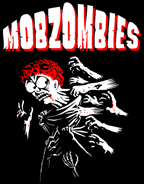
Human-as-Joystick
MobZombies explores a new dimension of handheld gaming by adding motion awareness to classic arcade style gameplay. Using a handheld device, and a custom motion sensor, players enter a virtual world infested with pixel-art zombies (a homage to vintage 8-bit console games). The goal of the game is to stay alive, running away from or planting bombs to destroy the ever-encroaching zombies.
The twist is that a player's physical position controls the position of their zombie-world avatar, forcing the player to actually move around the real world to succeed in the game.
The virtual zombie-world is a simple environment -- the game's complexity comes from players having to negotiate real-world objects in order to avoid the zombies and stay alive. The scoring system is simple: the longer you can stay alive, the higher your score. Of course, the longer you stick around, the more zombies you'll encounter.
"Basically, the game uses a digital compass and an accelerometer fastened to your hip (transmitting data through bluetooth) to get a relative position. That position controls a little zombie character in a virtual game world, and your main objective is to basically run away from zombies - by really running (or walking...). You can also drop bombs, but the trick is that you have to get away from the drop zone quickly before the bomb explodes on you. Other than zombies, the virtual world is really lacking any other obstacles - again, the idea is that the barriers are all brought in from the physical world. For example, in the game world, you might see a clear path away from the zombies, but in the physical world, that path might contain a busy street, or a wall. So that's where a lot of the difficultly comes in - learning how to navigate both these worlds and be hyper aware of your position in each.
The game has some history - I started designing it as a research project at USC, and it was entirely GPS based. However, we really found that it was a totally different experience than what we wanted, because of GPS resolution issues, as well as the ~1 second refresh rate. So my friend aaron and I built out an entirely different version based on relative movement. Now that we've got this version up and running, we're thinking about ways to get GPS involved again, while still retaining the analog control feel. One of the ideas we've been toying with is having community-assisted item pickups. In the current game, we randomly spawn heath and bomb pickups nearby your character. We were thinking it would be cool if people on the web could drop item pickups for you by clicking on a map. We could place those items in the virtual world based on a gps position, but once it was in the world, the player could still use the same control mechanism to get to the item. So yeah, basically thinking of creative ways to use GPS and maintain the nice analog feel of the human-as-joystick thing." -- Will Carter [via]
Posted by jo at 03:07 PM | Comments (0)
NOMUSIC.ORG Festival X

Simultaneous Translation
Simultaneous Translation, an international collaborative web audio project, will participate in the NOMUSIC.ORG Festival X on December 13, 10pm - 11pm EST. Participants for this round are: Greg Davis (USA - Vermont) - live instruments and voice; Kenneth Goldsmith (USA - New York) - words; John Hudak (USA - New York); Lawrence Li (CHINA - Bejing) - English to Chinese translation; Joe Reinsel (USA - Maryland) - Processing; John Roach (USA - Brooklyn) - Spiral Staircase; and Willy Whip (FRANCE - Nantes) - SimTrans Software.
People speak their own languages with little concern about the etymology of the words they speak, or the structural evolution that occured as their language moved geographically, passed from person to person, changing form along the way. Similarly, people trade information on the internet without thinking how the content changes as it passes through multiple users' hands. We rarely think about the geographical aspects of the web and the number of routers that a packet of data must pass through in order to reach its destination. Communication appears instantaneous, the internet seems to defy the common barriers to remote communication such as distance and delay. In reality, the data, invisible to the average user, is still subject to these factors.
Simultaneous Translation explores these limitations of distance and time through the lens of streaming media. Just as language has changed over time and as dialects have evolved as groups of people moved from place to place, so in this project sound is effected by the distances it travels and the time it takes to get there.
Simultaneous Translation is a collaboration in which the strengths and weaknesses of the medium are allowed to become active and shaping ingredients. Fluctuation and indeterminacy are not only inevitable, but desired. Variable stream quality, rebuffering, unexpected dropouts, these are the elements (like bad grammar or slang) that can launch the language into unforseen directions and vibrant neologisms.
The project is designed to be flexible and many of its elements (software, visual components, text, participants) will change as the project moves from host to host.
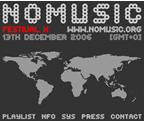
(((NOMUSIC))) wishes to generate improbable duals and gatherings between two participants during one hour time in a web audio performance. We make no storage because we think that Internet is a huge database which conveys already a great amount of dead informations and we don’t want to pollute it further. We are thus in favour of instant access to a selective event. The mechanism of the programming is not automated; it is relayed manually for 24 hours without any interruption by laboiteblanche and Carl.Y, two real human routers who are at the service of continuous audio stream and who endure technical difficulties and give rapid formation on the technologies of streaming to all the participants...
No-music stands between musical negation and anti-bruitism, in a non-silent interstice of audio manifestation. It allows the composer-performer to be his own auditor, in a place where nothing should be heard but just felt as a new entity to observe.
Posted by jo at 02:33 PM | Comments (0)
Upgrade! Tel-Aviv-Jerusalem:
![]()
Guy Ben Ary: BioWorks
Upgrade! Tel-Aviv-Jerusalem: Guy Ben Ary: BioWorks: A semi living artist & a living cinematic apparatu :: Wed 27.12.06, 19:30 @ Digital Art Lab, Holon, Yrmiahu st.16 (The Forbidden games exhibition @ dal will be open till 20:00 for those who didn’t see yet the show)
Guy Ben-Ary is an artist and researcher whose work uses emerging medias, in particular biologically related technologies (tissue culture, electrophysiology and optics). His work focuses on cybernetics, the boundaries between the living and non-living and focuses attention regarding the use and future possibilities of biotechnology. In his talk Guy will present two of the projects he has been involved with in the past few years.
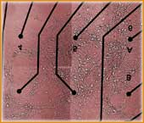
“MEART – the Semi Living Artist” is bio-cybernetic research and development project. MEART is a geographically detached artist that is distributed between two locations in the world. Its “brain” consists of cultured nerve cells that grow in a neuro-engineering lab, in Atlanta. Its “body” is a robotic drawing arm that is capable of producing two-dimensional drawings. The “brain” and the “body” communicate in real time with each other for the duration of an exhibition.
“The living Screen” project produces new poetics, made possible by fusing bio-technology into a living cinematic apparatus. This work explores what occurs when we cinematically engage with a living screen and employs film theory to understand Bio-Art as a Freak Show’. The Nano-Movies are projected (projection is 200 microns square in size) on Living Screens made from skin, blood, sperm or cornea cells that transform, react and change over time and eventually die. Therefore, it contorts the projected Nano-Movie in – unknown ways, and confront the spectators with issues such as life, death, virtuality and reality.
Guy Ben-Ary
Artist & researcher that works in the area of art and biology. Currently living and working in West Australia. Guy is an artist in resident in SymbioticA – The Art & Science Collaborative Lab at the University of Western Australia, since 2000. He specializes in microscopy, biological & digital imaging & artistic visualization of biological data. His Main research area is cybernetics and the interface of biological material to various devices. Member of the core SymbioticA Research Group that developed “MEART - the semi living artist” project. Guy is also a member of the “Biokino” collective that is developing the “living screen” project. He collaborated with the Tissue Culture & Art Project for 4 years (1999 - 2003). Guy is undertaking a Masters course in the school of architecture landscape and visual arts, UWA.
Posted by jo at 12:26 PM | Comments (0)
Upgrade! Paris

MAURICE BENAYOUN
Upgrade! Paris: MAURICE BENAYOUN :: Friday, December 15th at 7:00 pm At NUMERISCAUSA gallery : 27 rue Mauconseil, 75001 Paris, 1st floor, M° Etienne Marcel.
Maurice Benayoun will show his work on The Mechanic of Emotions, and
The Dump a blog for hypothetical projects. With Dominique Moulon, as mediator.
The Dump is a vast virtual area where I deposit my hypothetical or theoretical projects daily. Also others can dig in and extract from the Dump in order to apply the same concepts to their own projects; or accelerate the process of decomposition of unwanted items. Here, I keep the possibility to recycle, adapt and finally, rarely, to complete the act.
It is a day-to-day dump where sketches, realistically difficult projects, fuzzy concepts and fleeting visions are dumped without distinction. In the midst of daily projects, popping up concepts are often forgotten before they are materialised. They escape the undertow of memory. Why not make the concepts accessible to others who could grasp and recycle them while the possibility remains for me to revisit the projects dumped?
This liberating project, The Dump, evolves and constructs itself in the first days of this process. One discovers as much of the history of the concept itself, which is included in the first posts, as, in time, one learns of the more precise initial intentions of this project. These intentions, though, are gained only after and through The Dump’s own evolution.
Maurice Benayoun’s sketchy biography: He digs a tunnel under the Atlantic (1), charts the first map of the world’s emotions (2) then sells these emotions as musical cocktails (3). He offers the only acceptable explanation of the imperfection of the World (4), launches a photo safari in the land of war (5), dares to ask the Big Questions (6): is God flat (7) and the Devil curved? (8). He shares his retina with everybody (9) and unveils the existence of Big Brother’s sister (10). To take a break, he creates the biggest interactive exhibition on Earth (11), reshapes Europe’s biggest abbey with pixels (12), introduces VR into PCs (13), reconfigures a major Paris subway station (14) and converts the Arc de Triomphe into a monument to Peace (15). And finally, he decides to put all his new projects to The Dump (16).
Upgrade! Paris sessions are organized by Incident.net. They are public and monthly. Artists, researchers, architects, theorists present during one hour their recent work. Partners : CITU, Ars Longa, The Upgrade! International.
Posted by jo at 11:18 AM | Comments (0)
Oppera Internettikka - Protection et Sécurité
![]()
LIVE internet broadcast!
Intermedia Performance :: Oppera Internettikka - Protection et Sécurité by Annie Abrahams & Igor Stromajer :: Salle Molière, December 15th 2006, 8:30 PM GMT+1 :: Opéra National de Montpellier Languedoc Roussillon, France.
LIVE internet broadcast! English; Français. Please get VLC Media Player or Winamp Media Player or any adequat OGG-stream player ready beforehand.
"Oppera Internettikka - Protection et Sécurité" explores the poetics of a contemporary sound form -- opera as a sound event for the audience in the form of a live internet audio broadcast. In that way it combines the notion of the world wide web communication protocols and classical artspace -- an opera house. Opera is a very strictly coded form of art with a lot of passion, and internet is a lonely place of solitude and intimate communication which is becoming more and more fragile, dangerous and suspicious.

[left: Abrahams, middle: Stromajer, right Kattner]
authors: Annie Abrahams & Igor Stromajer
soundscape: Jan de Weille
live realtime audio streaming & logistics: Clément Charmet
Mutter Courage: Annie Abrahams, artist
Secret Agent: Christine Kattner, opera singer, mezzo-soprano
Big Brother: Igor Stromajer, intimate mobile communicator
Co-produced by bram.org (France), Intima Virtual Base (Slovenia), Association Panoplie (France), 2006. Executive producer: Elisabeth Klimoff (Panoplie Artistic director).
Project supported by The Ministry of Culture and Communication of the Republic of France (DRACLR), The City of Montpellier, le Conseil Régional Languedoc Roussillon, The Ministry of Culture of the Republic of Slovenia, Rhizome.org 2006-2007 Commissions, Languedoc-Roussillon Cinéma.
ANGST ESSEN SEELE AUF
Duration: 53 minutes.
Reservation and information:
Association Panoplie
5, rue Bayard, 34 000 Montpellier, France
+33 (0)4 67 64 64 21
info[at]panoplie.org
Posted by jo at 11:04 AM | Comments (0)
Shared Encounters: Content Sharing as Social Glue in Public Space

Call for Submissions
Shared Encounters: Content Sharing as Social Glue in Public Space :: Workshop at ACM SIGCHI 2007, San Jose, California :: Sunday April 29th 2007
Our everyday lives are characterized by encounters, some are fleeting and ephemeral and others are more enduring and meaningful exchanges. Shared encounters are the glue of social networks, although our everyday encounters are increasingly mediated by communications technologies that free up our social interaction from fixed spatial settings. We propose that content sharing through mobile and ubiquitous technologies, consciously situated in public space is a valuable new social practice.It can contribute towards redefining boundaries of access between communities, and create more fulfilling sustained encounters in Spatial settings.
In this context we aim to: * identify the types of encounters, and the characteristics which make an encounter a rich experience * understand the qualities of situations which sustain shared encounters * investigate how sharing through mass media and personal media provide ways for people to communicate and engage with others * differentiate the relationship between the types of social groups in networked communities * determine the components of situated computing which enable them to act as key enabling platforms.
We welcome contributions from researchers from a diverse range of fields, such as HCI, architecture, media, psychology and urban studies. Authors are invited to submit a four-page position statement in the ACM SIGCHI workshop publication format. Position statements are particularly invited which identify and discuss qualitative and quantitative methodologies, present specific case studies or that take a structured perspective reflecting on the workshop themes.
Selection of workshop participants will be based on refereed submissions and selected participants will be invited to participate actively in the workshop sessions. It is our aim to publish and document the outcomes of the workshop. At least one author of accepted papers needs to register for the workshop and for one day of the conference itself.
IMPORTANT DATES:
Jan. 12th 2007: Position papers due.
Feb. 1st, 2007: Notification of acceptance.
Apr. 29th 2007: Workshop.
SUBMISSIONS AND QUESTIONS: shared-encounters[at]mediacityproject.com
WEB: http://www.mediacity-project.org/shared-encounters
ORGANIZERS
Katharine S. Willis, Bauhaus University of Weimar
Konstantinos Chorianopoulos, Bauhaus University of Weimar
Mirjam Struppek, Interactionfield - Urban Media Research, Berlin
George Roussos, Birkbeck College, University of London
Posted by jo at 09:19 AM | Comments (0)
CyBERSPACe as Universal Meeting Place

OPEN INTERNATIONAL INVITATION
Laboral Art and Industrial Creation Centre OPEN INTERNATIONAL INVITATION - EXHIBITION OF LABCYBERSPACES PROJECTS - CyBERSPACe as universal meeting place :: 3000 euro per chosen project.
Laboral Art and Industrial Creation Centre, a new creative space located in Gijón, Principality of Asturias, Spain, is making an open invitation for projects for its upcoming LABCYBERSPACES exhibition, part of its inaugural programme.
The goal of the invitation is to foster an open reflection on the connections between art, technology and industry, and to then materialise this reflection in the LABCYBERSPACES exhibition scheduled for spring 2007. The selection will feature 10 projects effectively addressing the technological nature of the artwork in its most open conception, with a special focus on all those engaging in the notion of CYBERSPACE as a universal meeting point.
Given that the goal is to encourage a common and open reflection, we have chosen the format of an open invitation to guarantee the widest possible participation. The LABCYBERSPACES exhibition aims to be a meeting point for the community.
All entries submitted by an artist or group, significantly involving technology and the use of Internet will be accepted for consideration. A total of 3000 euro will be paid as fees and exhibition rights for each of ten the projects eventually chosen.
The inscription form will be available as from 1st December 2006 at the website. For any additional information or queries on LABCYBERSPACES, contact: lab_cyberspaces[at]laboralcentrodearte.org
ABOUT Laboral, Art and Industrial Creation Centre Laboral, Art and Industrial Creation Centre, is a newly created art centre located in Gijon, in the Principality of Asturias, Spain. The centre will undertake, from an ongoing rigorous focus, the tasks of production, research and dissemination of stable projects developed around the many meeting points existing between creation, science and technology, and which are the groundbase of the work and reflection of a large number of artist, theorists and researchers. Asturias' industrial tradition, taken together with the innovative creativity developed here, have turned this Spanish region into a particularly appropriate place for a centre dealing with the above-mentioned goals. The very name of the centre reflects the explicit determination to fulfil that goal through a direct connection of the most innovative aspects of industry with, normally distant and removed, locations of art creation.
This determination is at the origin of the project for the rehabilitation of 13,500 square metres of the former Universidad Laboral of Gijon, an initiative set in motion by the Government of the Principality of Asturias and that is scheduled to be completed at the end of 2006. The investment will provide the Laboral, Art and Industrial Creation Centre with the perfect space to implement the tasks of production, dissemination, training and professional encounters at the intersection of art and technology.
Projects Office
With this open invitation Laboral Art and Industrial Creation Centre kick starts its Projects Office. This office will be making regular open invitations for specific projects, while remaining permanently receptive to all kinds of proposals which will be evaluated for possible production at the centre. The mission of the Projects Office is to foster and support art production engaged with new technologies.
Posted by jo at 09:12 AM | Comments (0)
The Darfur Wall
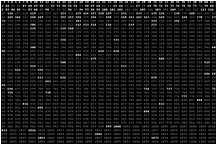
Turn a Number from Dark to White
The Darfur Wall - Jonah Burke left Microsoft to found the The Darfur Wall with his father and brother a couple of weeks ago. If you're not aware Darfur is in a crisis. The Burkes have created a novel website for collecting money. There are 400,000 subdued numbers on the site; each time a dollar is donated a new number is lit. All of the monies go to Doctors Without Borders, Save the Children and others. In just 21days, they have raised $5052 from 445 donors. Buying a number is fast and easy; consider it. (Blog) [via]
"This is the Darfur Wall: Click a square above to approach the wall and witness its 400,000 numbers, one for each person killed in the Darfur genocide. Donate one dollar or more to turn a number from dark gray to brilliant white and honor one lost life. 100% of the proceeds go to four Darfur relief organizations."
Posted by jo at 09:03 AM | Comments (0)
December 11, 2006
Second Life
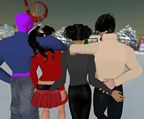
First Annual SL Literary Festival
First Annual SL Literary Festival :: Verum's Place, Yanguella :: December 16, 2006; 2:00 pm SLT :: Contact Carla Herrera, carla[at]contemporaryguide.com for more information.
Schedule of Events (Tentative/subject to change) :: Throughout the day there will be poetry readings, streaming music, discussions, art display, interactive literature projects, classes and workshops.
TBA: Patrick Lichty / Man Michinaga - Discussion: Digital Narrative and Online Spaces.
2:00 Opening ceremony Greetings & guest speaker on front lawn ::
3:00 Schedule of Workshops and Classes begin Signs and teleporters provided :: Workshops and classes run throughout the day and will conclude at 6:30 for fireworks And storytelling :: 4:00 Tours of the Gothsburg castle begin Tours last 30-45 minutes. :: 3:30 Open mic at Verum's place Essays & poetry welcome :: 4:00 Poetry Challenge $L100. to the winner :: 5:00 Tramp's Theatre Troupe Surprise performance :: 6:30 Fireworks By Spider :: 7:00 Storytelling circle on front lawn :: 8:00 Event close/Open chat/discussion.
Posted by jo at 04:25 PM | Comments (0)
Upgrade! Amsterdam

Degradable
Upgrade! Amsterdam: Degradable :: When: Monday December 18, 2006 20.30 hours :: Where: De Melkweg, Theaterzaal, Lijnbaansgracht 234 A, Amsterdam :: | free admission | LIVE stream.
As the year draws to a close, the last Upgrade! Amsterdam of 2006 ponders the poetics of degradability, focussing specifically on the aesthetics of things mutable, morphable, and ephemeral. Whether it’s Steven Jouwersma’s serial destruction of personal memory and momentum in the DIA-EXIT, or whether it’s Jelte van Abbema’s time and emotion sensitive font in his “VIRTUREAL typewriter, or his bacterial prints in SYMBIOSIS, these artists show us that the wilful design of degradability yield surprising outcomes.
The new performance SYNCHRONATOR by Gert-Jan Prins and Bas van Koolwijk, which combines thecharacteristic visual qualitiesof analogue and digital techniques concludes the evening. In sync with the festive season, we serve apple pie and punch!
|| Participants ||
- Steven Jouwersma [new media artist working predominantly with old media like 8mm film and photo slides. Currently completing an M.A. at the Frank Mohr Institute]
- Jelte van Abbema [graduated at the Design Academy in Eindhoven. Fascinated by the beauty and strangeness of nature. Loves cookies]
- Bas van Koolwijk [audiovisual artist.His video works can be seen as an aggressive attack on the illusion of video itself.
- Gert-Jan Prins [electronic improvised music performer. Uses a self-developed electronic system of radio and transmitter technology]
|| Projects ||
Steven Jouwersma | DIA-EXIT:: In exchange for apple pie people gave Jouwersma their old slides. After collecting and watching 40.000 slides he decided to destroy them, and machine for that purpose: the "DIA-EXIT", installed at the Tschumi Pavilion in Groningen. Upon pressing a red button a slide projection appears; another push on the button would cause the slide’s
destruction.
Jelte van Abbema | Virtureal |Symbiosis :: | Virtureal | Virtureal explores man-machine boundaries by way of a modified old Remington typewriter, fitted with pressure sensors. The font changes according to the intensity of the keystrokes, and is susceptible to the passage of time. :: | Symbiosis Due to his fascination for growth, van Abbema created prints composed by bacteria. As time passes, the image is continuously and organically transformed into something new.
Gert-Jan Prins & Bas van Koolwijk | Synchronator :: Since the early years of video art, works have been made which do not produce a standard TV signal waveform and therefore cannot be directly recorded or projected with current equipment. For SYNCHRONATOR, Bas van Koolwijk and Gert-Jan Prins have created their own hardware to overcome this problem,making use of the characteristic visual qualities of such techniques.
Upgrade! Amsterdamis a series of gatherings for and by new media aficionados, artists, geeks, media makers and breakers, and the generally curious. Point of departure is the premise: “No upgrade without a downgrade.” Upgrade! Amsterdam is organised by Nat Muller & Lucas Evers, is actively hosted by De Melkweg, and kindly supported by VSB Fonds and Mondriaan Foundation.
Upgrade! is an international, emerging network of autonomous nodes united by art, technology, and a commitment to bridging cultural divides. Since April 1999, a group of new media artists and curators have gathered in New York City. The first meeting took place at a bar in the east village with Tim Whidden & Mark River [MTAA], Mark Napier and Upgrade! founder Yael Kanarek.
Posted by jo at 02:18 PM | Comments (0)
[iDC] Introduction and Blinks & Buttons
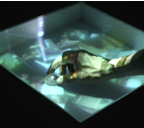
Networked Photography
I'm Sascha Pohflepp, currently based in Berlin, where I spent the last couple of years at the University of the Arts' (UDK) visual communication department (some of the work from that time can be found at http://www.pohflepp.com). I also frequently contribute to the blog We-Make-Money-Not-Art.com and occasionally work with the Mediamatic foundation in Amsterdam.
My most recent work is a two-fold thesis project, titled "Between Blinks & Buttons". It is a try to look at photography as an increasingly connected process and the implications which arise from that – both for the individual but also for the process of remembering and the camera as an object in itself. Quoting from the introduction:
"Photography has become a networked process. It no longer ends with pasting putting prints into an album. Instead, making them public through services like Flickr is rapidly becoming one of the main ways how we treat our visual memories. The photographic process extends from preserving a moment to an act of telecommunication, with numerous implications on how we perceive reality, how we make our memories and how we create a narrative from it.
The camera itself has become a networked object and through the fusion of the snapshot-camera and the mobile phone, this object will even become more part of our everyday lives. Cameras always have been recorders for their contexts, essentially equipped with a light sensor to capture a visual representation and a pressure sensor for the person who decides which moment will be saved – the button. Furthermore, digital photos come with a great amount of data attached to them as so-called EXIF-tags. These include a multitude of precise information about technical aspects of the shot, the make of the camera, how it was held and when the image was taken.
For almost any given moment since early 2004, it is possible to find a photo on the web which was taken in the exact same second. For every of my photos that I myself have a memory of and an emotional connection to, I can see someone else's moment. I can see what happened in another part of the world while I was doing what I remember when I see it. In that sense, cameras become networked buttons that create a link between two people through the simple fact that they did the same thing simultaneously: press a button. The cameras create a visual trace of it, with time as a reference."
This resulted in two installations – firstly "Blinks", a prism sitting on a kind of light-table that actually refracts the ray of time which metaphorically runs through every photo into all the other moments that had been simultaneously captured in various places all over the world.
Secondly, "Buttons", a camera which intentionally boils down the photographic apparatus to its essential button. Once this button has been pressed, no picture is taken (the person will remember the moment, though), but a networked device inside starts to look for photos from that very same second. It might take some time, but eventually, a photo will show up on the camera's display.
Interestingly, in both pieces, the photos never feel random since the user shares a moment with that other person who took the photo. At a recent presentation, someone called the whole process "momentograph" which I found very fitting and beautiful. Please feel free to let me know what you think of all this, the website mentioned above also has some more information and videos.
iDC -- mailing list of the Institute for Distributed Creativity:: iDC[at]bbs.thing.net :: http://mailman.thing.net/cgi-bin/mailman/listinfo/idc
List Archive: http://mailman.thing.net/pipermail/idc/
Posted by jo at 01:58 PM | Comments (0)
Jim Andrews' Vispo.com

Guest Work and Collaborators
VISPO.COM GUEST WORK AND COLLABORATORS :: I've been publishing vispo.com since 1995; there's a great deal of work on the site. Most of it--by 'volume'--is my own work: vispo.com is the primary way I publish my work--but over the years the site has come to house a significant body of work by other people and also collaborative work between myself and others. I've collected and annotated a page of links to that onsite work at http://vispo.com/guests.
The most recent works on this page are from 2006, and the oldest is from 1988. Soon to be 1984, actually: I'm working with Geof Huth, Dan Waber, Marko Niemi and Lionel Kearns to recover the animated computer poetry bpNichol did in 1984, and we will eventually get that up on vispo.com. Anyway, http://vispo.com/guests links close to twenty years of work. I have a sense now of working both forward and backward in time. Still trying to forge ahead with new and, hopefully, innovative, fresh projects, but also doing projects such as the bpNichol project and 'On Lionel Kearns' that look back and either recover work relevant to digital poetry now or present the work of artists who have been a big influence on me.
Most of the pieces are explorative of digital writing. The 2006 works are by Lee Worden and Marko J. Niemi, both of whom are programmers as well as writers. Lee, who has a doctorate in math from Princeton, has re-written his Cutup Engine that some of you will be familiar with. This is an excellent tool for exploring the interzones of texts. You paste text or URLs into the Engine and it dices them in a configurable way. Marko's 2006 works are the Concrete Stir Fry Poems. These deal with cutups also, but in a lettristic, visual poetic manner. Marko is a remarkable poet-programmer from Finland; his work bodes well for the future of digital poetry.
Also, the page links to the work of the Argentine poet Ana Maria Uribe, who passed away in 2004 and whose Typoems and Anipoems are, in their entirety, housed on vispo.com. She also collaborated in the production of Paris Connection, a project in critical media that examines the work of six French net artists. There are other projects in critical media such as Defib, a series of sixteen chat interviews produced with Dan Waber; in 1999-2000 we produced chats with writers who were attempting to produce work on the Web. The page links also to Strings by Dan Waber, which is a project in kinetic poetry that has been wonderfully successful; Strings is taught in many Universities that deal with digital poetry.
The oldest links on the page are from my pre-Web days as a writer and audio producer. There's a radio show I produced on the poetry of Seattle's Joseph Keppler (there are over 100 other shows in the vault, not online). And the page links to some of the music of The Laughing Boot Quintet, in which I was the drummer and audio engineer. There's also a link to a Paul McKinnon recording done at Mocambopo, a reading series I organized and hosted in Victoria Canada in the nineties (Mocambopo kept going like the Energizer Bunny for years after I left and only recently moved venues).
And there are links to other work such as collaborations with Brian Lennon and Pauline Masurel concerning stir fry texts; a link to my page featuring some of Ted Warnell's work; a link to Jorge Luiz Antonio's page that he maintains on vispo.com on Brazilian Digital Poetry on the Web; a link to Shuen-shing Lee's translations into Chinese of some of my work; and a link to work by Uruguay's Clemente Padin.
There's also a link to PRIME, the Peace Research Institute in the Middle East, which I maintain on vispo.com with my friend Sid Tafler. PRIME is headed by Sami Adwan, a Palestinian, and Dan Bar-On, an Israeli. Together, they work on some fascinating and incredibly worthwhile projects in peace-building between Palestinians and Israelis. Sid edits the site and I do the HTML.
Anyway, all this work by others and in collaboration with others has been a true joy in my life. The page is ongoing, as mentioned--it isn't finished yet--nor am I, I hope. But I wanted to acknowledge this work and thank those who have contributed fine work to vispo.com and collaborated with me on other work. You discover alternative approaches to poetry in just about all this work, that attempt some synthesis of arts, media, and fields such as programming and mathematics or music and recorded sound. As well as attempts to write of the poetics of such practice. It's about putting it all together, connecting, staying human, discovering the nature of our altered humanity and language so that we can address life with fresh insight and communicative power.
Vispo.com is an attempt to create a literary work alternative but related to the book; to create works and experience imaginatively attuned to the media and methods of the Net. Being truly literate involves not only reading but writing; vispo.com is an attempt to write through new media. It is my life's work; and the work on vispo.com by others and in collaboration with others is a huge part of the nature of that life and work to put it all together, to make strong connections. The French poet Isou said "Each poet will integrate everything into everything." And this was way before the Net. Same job, different time and circumstances.
Again, many thanks to those whose work is on http://vispo.com/guests, and to you for reading.
ja (Jim Andrews)
http://vispo.com
Posted by jo at 10:30 AM | Comments (0)
Turbulence Artists' Studios
![]()
Alan Bigelow
Turbulence Artists' Studios: Alan Bigelow :: Using text, photographs, audio, video, and other elements, Alan Bigelow's fictions go beyond simple hypertext; they create visual and audio environments in which stories can unfold. His work is based on three basic premises: 1) the fictions should be multimedia events; 2) they should be easy to navigate; and 3) they should be interactive. In addition to navigating through the stories--and triggering certain Flash events --users can also write into some of these narratives, giving them the opportunity to contribute to the creation and continued growth of the stories.
BIOGRAPHY: Originally a fiction writer in traditional text genres, Alan Bigelow started working in Flash in 2000. With hard copy fiction increasingly difficult to publish, and many writers moving to vanity presses and desktop publishing, it appeared that the Web offered a free market of new genres and, within digital fiction, a relatively undiscovered area of exploration. Bigelow's work, and his conversations concerning interactive fiction, have appeared in Hallwalls Contemporary Arts Center, DreamingMethods.com, BlazeVox.org, and elsewhere. Recently, he was a visiting online lecturer in Creative Writing and New Media at De Montfort University, UK. He has a Ph.D. from SUNY at Buffalo (USA), and teaches at Medaille College.
Posted by jo at 10:13 AM | Comments (0)
Prix Ars Electronica 2007

Call for Entries
Prix Ars Electronica 2007 - International Competition for Cyberarts :: The 21st Prix Ars Electronica will have a few new features. The new Hybrid Art category, a new prize for Media.Art.Research, and the integration of Net Vision into Digital Communities are the most visible signs of the intensive work that is being done on the definition of the competition’s categories. As always, the aim is to continually keep the Prix Ars Electronica updated in line with leading-edge developments in the dynamic field of cyberarts.
Prix Ars Electronica 2007 :: Start of Online Submission: December 8, 2007 :: Online Submission Deadline: March 9, 2007 :: Computeranimation / Film / VFX, Digital Musics, Interactive Art, Hybrid Art, Digital Communities, u19 - freestyle competition, [the next idea] grant, Media.Art.Research Award.
All details about the categories and the online submission are available online only at: http://prixars.aec.at Total prize money: 122.500 Euro.
Iris Mayr - Project Manager
Prix Ars Electronica
AEC Ars Electronica Center Linz
Museumsgesellschaft mbH
Hauptstraße 2
A-4040 Linz
Tel. ++43.732.7272-74
Fax ++43.732.7272-674
iris.mayr (@) aec.at
http://prixars.aec.at
Posted by jo at 09:36 AM | Comments (0)
December 08, 2006
Leonardo "Digtial Wild"
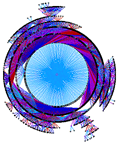
The Collaboration of Art and Nature
Leonardo "Digtial Wild": Guest editors Dene Grigar and Sue Thomas have culled a neat collection of explosive essays from the hefty haul of initial contributions received and emerged with a two-themed anthology on Wild Nature and the Digital Life, which delves into the collaboration of art and nature.
In Dene Grigar’s editorial, she explains that the first volume explores a range of issues relating to the “Emergent and Generative” in nature, the digital, and art. The second wave of another four papers, edited by Sue Thomas, features essays that are “Performative and Locative” in scope.
Peter Hasdell starts the proverbial ball rolling, with his contribution, Artificial Ecologies: Second Nature Emergent Phenomena in Constructed Digital – Natural Assemblages. Participants are asked to develop projects that learnt, borrowed, or stole from natural systems. In essence, constructing part natural/part artificial assemblages functioning as small-scale quasi-ecosystems. This unearths a “garden of strange delights” where a “level of unpredictability of outcome arose, freed from constraints of orthodoxy."
The next essay to flutter into sight is Tara Rodgers’ Butterfly Effects: Synthesis, Emergence, and Transduction. This paper describes a music project in progress that attempts to model monarch butterfly behaviors and migration patterns in sound, using the programming language SuperCollider. The goal is to achieve a dynamically generated composition that combines core elements into a complex system, describing patterns of emergence and survival."
Musical composition figures also as the subject of Dave Burraston and Andrew Martin’s Digital Behaviours and Generative Music, an essay about reaction-diffusion systems, cellular automata, and computer music.
Jennifer Willet’s Bodies in Biotechnology: Embodied Models for Understanding Biotechnology in Contemporary Art serves as an introduction to an evolving series of texts exploring the intersection between computation, biology, art, science, and education. Its focus is on “moving away from computational models and reuniting notions of embodiment with the language and representation of biotechnology with a social and political mandate towards informed discourse and public consent."
In the second-themed collection, Adam Gussow’s Kudzu Running: Pastoral Pleasures, Wilderness Terrors, and Wrist-Mounted Technologies in Small-Town Mississippi, transports us to the moment when, during what was intended to be a 30-minute jog on Thacker Mountain, the author realizes he is lost. He is then “forced to reassess both the implicit romanticism of my own understandings of nature and the real utility of the competing metric technologies I’ve grown addicted to."
On a larger scale, in Mapping the Disaster: Global Prediction and the Medium of ‘Digital Earth’, Kathryn Yusoff reports on “the mapping of disaster in digital prediction models. Concentrating on the imminent disaster of climate change, the author asks how global digital models can be expanded to incorporate a wild nature and wild data."
Jeremy Hight then looks into how the “developments in locative technology, location-based narrative and the expansion of the research and work allow new hybrid narrative forms, but more importantly, allows the entire landscape to be “read” as a digitally enhanced physical landscape” in his offering Views from Above: Locative Narrative and the Landscape.
The closing essay is Brett Stalbaum’s Paradigmatic Performance: Data Flow and Practice in the Wild, which incorporates many of the areas discussed in this volume. He uses real-time data modelling to explore ‘the intersection of data and the real via artist made technologies, with the goal of generating new configurations of exploration at time when it may be assumed that the Earth is already thoroughly explored."
The essays are packaged with a small but powerful gallery of two works, also curated by Dene Grigar and Sue Thomas.
Karl Grimes’ Future Nature “continues [his] analytical engagement with the themes of retrieval and digital resurrection, bringing to light and into the light the specimens and objects previously hidden in dispersed archives and research databanks. The project takes as its base the unique animal embryos and foetuses housed in the Hubrecht Collection of Comparative Embryology, Utrecht, Netherlands, the Museum für Naturkunde, Berlin, Germany, and the Tornblad Institute in Lund, Sweden".
Elisa Giaccardi’s efforts with Hal Eden and Gianluca Sabena breathed life to The Affective Geography of Silence — Towards a Museum of Natural Quiet, a project which resulted in a “virtual museum in which natural quiet is transformed into a living and affective geography that changes over time according to participants' perceptions and interpretations of their natural environment”.
Posted by jo at 02:15 PM | Comments (0)
Will Pappenheimer's Public Mood Ring
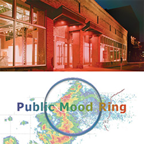
What is your Relationship to News?
Will Pappenheimer's Public Mood Ring opens at the Urban Institute for Contemporary Art, Grand Rapids, MI, USA :: December 8, 2006 18:00 EST - January 19, 2007.
Public Mood Ring is an installation/internet work inspired by the common wearable “mood ring.” The ring is believed to be capable of translating the bearer’s emotional condition into its changeable color hue. This project attempts to find the color mood of a current public issue represented by instant Internet news text. It does this at the request and questioning of remote viewers logged onto the artwork site and to a computer station within the installation room.
what is your relationship to news? Web participants can see the change and status of the installation space via web camera. The shared experience is both the gift of the remote participant, as well as a gauge or color representation of the current world events. Installation visitors are then immersed in the ambient light.
Posted by jo at 12:49 PM | Comments (0)
YOUR TUBE, YOUR IMAGINATION
Dancoyote_antonelli_and_skydancers
Online world as new artist's medium. I haven't had a chance to attend a performance designed by DanCoyote Antonelli, founder of a new school of metaverse-era art theory he calls hyperformalism, but Gary Hazlitt has. Hazlitt shot at a recent showing of Antonelli's ZeroG SkyDancers (evocative, though it's clear you need to attend the show in-person, to get its full power), then read his detailed and thought-provoking write-up of the event and interview with Antonelli here. [blogged by W. James Au on New World Notes]
Hyperformalism is an aesthetic philosphical construct that may be employed by to describe a late 20th century, early 21st century mass art phenomena consisting of scores of personal computer users generating abstract, often spacially unique artworks with software tools.
These spacial realities have no analog in the physical world, and instead of making reference to physical reality, create a unique continuum of reference; a rearrangement of photons to illuminate alternate worlds of form, shape, color and space.
The term Hyperformalism is derived from the combination of the words Hyper and Formalism (as described by WikiPedia) and is being used here to describe aesthetic self expression without anthropomorphic, or representative context. This seperates Hyperformalism from digital collage, aesthetic photo manipulation and other forms.
Hyperformalism is not anthropomorphic or representational. Often times hyperformal art may resemble natural formations or even employ naturalistic algorythms such as the work of Casey Reas which is described on the aforementioned website as "stringently defined yet wonderfully organic".
Other times hyperformal artwork takes a more industrial or unnatural form such as the work of Shirley Shor
Hyperformalism may be flat like Casey Reas or spacial like Shirley Shor but never contains recognizable elements like text, figures, landscapes, objects and concepts relating to humanity.
Hyperformalism, the product of a desktop computer, suffers from stigmatization of its association with computers and has yet to find a neutral delivery platform. This means that vast amounts of work is being created, at the pace of technological change, without the hope of display beyond a desktop computer screen.
Since most of the material viewers are accustomed to encountering on a desktop computer screen is commercial in nature, disposable consumer culture, it is a hard sell to suddenly invoke the weight of culturally important artifact on to such a homely delivery platform.
Guilt by association...
Posted by jo at 08:58 AM | Comments (0)
ToneLadder
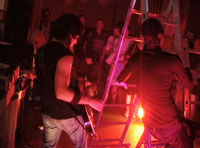
Sounding Balance
ToneLadder is a household ladder extended with a melodic function and made into a musical instrument. Stepping on a bar of the ladder creates a sound or tone which is different from rung to rung. This way, the ToneLadder can be used as a musical performing device. Most electronic music is performed quite similar using keyboards and laptops. ToneLadder offers and alternative way of performing music by letting the artist trigger sound loops by balancing on the ladder.
The technical implementation consists of special sensors attached close to the top of each bar of the ladder. If one of these sensors is triggered by a foot or hand, an analog signal is sent to a processing unit which transforms the incoming analog signal into a MIDI signal. This signal is then either sent to a computer or processed directly by a hardware music sampler. The sent signal triggers a specific sound loop or tone for each bar of the ladder. By hitting the bar soft or hard, the user can influence the volume and the modulation of the sound as well. ToneLadder can also be used to trigger live video streams.
ToneLadder is available in a basic version, a dynamic ladder, and a wireless wall-ladder. Check out the demo video and a video of the wireless wall-ladder. ToneLadder is exhibited at this years Nordic Exceptional Trendshop in Copenhagen. [posted by Lene Mailund on Digital Experience]
Posted by jo at 08:40 AM | Comments (0)
Let's Puff

Pushing the Landscape
Let's Puff by Yang Zhenzhong :: Two Channel Video Installation [Movie]:
"After exploration in installation and photography, Yang Zhenzhong begins be engaged in large number of video experiments. His art style is mostly bright and intelligent, and his works usually make an individual inspection seemly ordinary and simple subjects to represent extraordinary connotation. Let's Puff, his video works for this Biennale reveals Yang Zhenzhong's easy and humorous character once more. In front of a fashionable girl, real city scenes become unreal game properties, then reality and unreality that are two seemly paradoxical realms convincingly overlap together in this specific time and space and successfully create a miraculous illusion."-- Li Xu/2002 Shanghai Biennale catalog
The work of Let's Puff is the video installation with two synchronized channels: In one of the two faced screens (video A), there is a girl who keeps on blowing; but in the another one, (video B), it shows the city scene becoming far and far away from us according to the rhythm of the blowing of the girl. During the production of the work, I had to solve several important technical problems.
"I chose the Nanjing road for the spot of video B. Nanjing road is the most famous commercial street with many remarkable buildings as symbols of Shanghai city. I called four friends to help me and borrowed a wheelchair on that day; just for ensuring the camera could be under smooth movement when I shot the video on the street. All the facilities and methods are simple but effective. One of the friends sitting in the wheelchair in responsible for holding the camera steady, I pulled the wheelchair to back up, running or pausing, with the walkman, by the rhythm of the sound from the CD. The other three friends behind me took the responsibility for dispelling the public in order to keep up the path without barriers. On such a sunny afternoon, we five weird guys, passed the Nanjing road streaming with sweat and, fortunately, we were finished within one hour,
After taking the shots, the main part of my work was editing the video. Actually, it was quite a lot of trouble to put the two videos into the same step.
In this work, I was also supposed to experiment with an interaction by using the illusion of image, which was how to transfer the view of city into a tool of the blowing game by a fashion girl. Of course, any imagination was welcome. This was accomplished by using the viewer and generating that from the effect of the work." [via]
Posted by jo at 08:35 AM | Comments (0)
New Media Caucus at the 2007 CAA
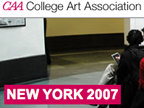
Can Geeks be Humanists
New Media Caucus at the 2007 College Art Conference :: The 95th Annual conference will take place from February 14th to 17th at the Hilton New York in Midtown Manhattan.
Thursday, February 15, 12:30-2pm, Trianon Ballroom, Hilton NY :: Panel Title: "Can Geeks be Humanists” :: Panel Chair: Marcia Tanner, Independent Curator and Writer, Berkeley, California
A common perception among artists, curators, art historians, art critics, and art audiences outside the new media art community is that artists using contemporary technologies create work that alienates the viewer and conflicts with the humanist legacy of Western art and other cultural and aesthetic traditions. This notion is all too often reinforced, superficially at least, by much of the new media work produced.
This panel will address and challenge those assumptions with presentations by artists whose work and practice consciously extend and amplify humanist aesthetic traditions. In the subsequent conversation, panelists will be invited to explore the definitions and appropriateness of those apparently oppositional terms -- “geeks” versus “humanists” -- and consider a third: that of “artist.“ They will discuss those characteristics of new media art that seem to justify the charges against it -- notably in terms of communication with and/or reception by traditional art audiences and critics -- and whether these concerns should matter to anyone now, particularly to the artists themselves.
With some Papers and Panelists:
Intimacy in New Media Art
Andrea Ackerman, artist, theorist, psychiatrist, New York, New York
Claudia Hart, Pratt Institute, New York; Lehman College, City University of New York
Beyond Functional: Embedding Responsive Art into Human Systems
Sabrina Raaf, School of Art and Design, University of Illinois at Chicago
Animate Objects, and the Evocation of Empathy
John Slepian, Wesleyan University, Middletown, CT
The Beautiful and the Terrifying
Gail Wight, Stanford University, California
Here are a few crucial dates for your calendar:
December 13th is the deadline for Early Bird Registration for the
Conference (this can be done on-line or via mail).
Posted by jo at 08:30 AM | Comments (0)
December 07, 2006
Fibreculture Journal
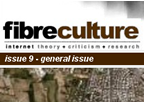
Issue 9: General Issue
New Media Studies - issue 9 of The Fibreculture Journal now online Edited by Andrew Murphie
Articles: Daniel Black - Digital Bodies and Disembodied Voices: Virtual Idols and the Virtualised Body :: Erin Manning - Prosthetics Making Sense: Dancing the Technogenetic Body :: Bob Hodge and Elaine Lally - Cultural Planning and Chaos Theory in Cyberspace: some notes on a Digital Cultural Atlas Project for Western Sydney :: Gary Genosko - The Case of "Mafiaboy" and the Rhetorical Limits of Hacktivism :: Warwick Mules - Contact Aesthetics" At the Threshold of the Earth :: Michael Arnold, Martin Gibbs and Chris Shepherd - Domestic ICTs, Desire and Fetish
General Issue - Editorial :: Andrew Murphie - Editor
Let us for a moment call the field we work in "new media studies". Immediately, questions arise. For a start, one of the wonderful things about the field we work in - as thinkers, as practitioners - is that its name is constantly contested. New media, digital media, multimedia, internet studies, computer media, inter-media, simply media, cyberculture, network culture - the renaming of the field is ongoing and never finally resolved. The problem of the name is not as trivial as is sometimes assumed.
That none of these names seems adequate suggests that the field itself, perhaps by nature, is constantly shifting, encouraging a series of precise engagements perhaps but eluding homogeneity. At the same time, the problem of the name does suggest a defining feature of the "field" - this is *transversality*that becomes unavoidable when working with new media technologies.
Simply put a transversal is a line that cuts across other lines, perhaps across entire fields - bringing the fields together in a new way, recreating fields as something else.
A contributor to this issue of the *Fibreculture Journal*, Gary Genosko, takes this question of transversality into an understanding of the dynamics of institutions (in his exemplary work elsewhere on Félix Guattari - see Genosko, 2002). Here the concept of transversality suggests something like the unavoidable contagion of transference between analyst and analysand, only now *at the level of the group*. This leads to the reforming of institutions when new lines cross between older disciplines, older fields, older cultural practices. Although transversality is arguably a part of all fields, it is often something taken to be guarded against. However, I have suggested that, in tune with the object of study, that is media technologies that connect more and more aspects of the world to each other, transversality is the unavoidable discipline we must follow in new media studies - whatever we call it. This requires a particular kind of rigour, one that combines a range of specific disciplinary rigours with the ability to bring these into new harmonies. These usually feedback in turn to transform the disciplines involved. If anything "scares the horses", institutionally speaking, about new media, it is perhaps this unavoidable transversality and the new rigours it requires.
Since what I began by calling new media studies does indeed still "scare the horses" sometimes, it might be useful to take up the horse metaphor briefly from the point of view of transversality. Genosko points precisely to Guattari's metaphor regarding horses as an illustration of transversality - and what scares Guattari's horses is in fact their inability to see each, the difficulty of forming new harmonies. 'Guattari's horses … illustrate' what Guattari calls 'the coefficient of transversality' (Genosko in Guattari, 2000: 118). As Guattari writes -
Imagine a fenced field in which there are horses wearing adjustably blinkers, and let's say that the "coefficient of transversality" will be precisely the adjustment of the blinkers. If the horses are completely blind, a certain kind of traumatic encounter will be produced. As soon as the blinkers are opened, one can imagine that the horses will move about in a more harmonious way. (Genosko in Guattari, 2000:118/Guattari, 1972: 79)
Genosko concludes that 'Blinkers prevent transversal relations; they focus by severely circumscribing a visual field. The adjustment of them releases the existing, but blinkered, quantity of transversality'. Again, removing the blinkers, increasing the 'coefficient of transversality', requires a certain rigour. In our field this is perhaps simply a matter of appropriate responses to the way new media technologies keep removing the blinkers for us in the world at large.
It is exactly this rigour that this issue of the *Fibreculture Journal*celebrates. In doing so, it perhaps shows us that, despite the difficulty with names, thinking across the field of new media studies has matured, as unstable as this field might necessarily be. In this issue, the articles all operate via transversal lines that follow the use of new media technologies in areas such as dance (Manning), computer hacking and the law (Genosko), city planning (Hodge and Lally), aesthetics (Mules), celebrity (Black) and even the question of the technological fetish in everyday life (Arnold, Gibbs and Shepherd). They demonstrate the maturity of "new media studies", precisely because they tell us in so much detail what the cultural processes discussed have actually become, as they play out in everyday life (and not perhaps as they play out in the rhetoric surrounding new media technologies, within and outside the academy). In articles by Erin Manning, Bob Hodge and Elaine Lally, Warwick Mules, and Daniel Black, the authors open up new issues concerning new media technologies, with a new depth and precision of analysis regarding the body and the very real virtual. This also becomes a question of what new media technologies - seen as transversally working with the human body, the virtuality of the world - might become in the future, and how we might thinking this becoming with a greater 'coefficient of transversality'. The articles by Gary Genosko, Michael Arnold, Martin Gibbs and Chris Shepherd also help us to see in a less blinkered manner. Both provide well-researched correctives to academic and popular thinking about the lived realities of new media as taken up in culture.
The desire for less blinkered approaches to new media technologies is not just a rarefied fancy from the further reaches of theory. New media are now the mainstream (and as these articles demonstrate, they are becoming the mainstream not only in "media", traditionally considered, but elsewhere as well - in dance (Manning), in city planning (Hodge and Lally), in questions of aesthetics (Mules), in the production of what Daniel Black calls the celebrity of the 'virtual idol', even at the junction of the law and cultural studies (Genosko). The mainstreaming of new media means, of course, that new media studies, as transdisciplinary, or simply unstable, as it still might be - is now well and truly established. It is arguably now the study par excellence - and the way new media have become a necessary consideration in so many other fields, from anthropology to medicine, is another aspect of new media's unavoidable transversality.
This issue of the *Fibreculture Journal* celebrates both the instability and the maturity of that which we cannot quite call "new media studies". If there are any unifying concerns here they might include a mature understanding, not only philosophical, but practical and indeed technical, of the virtual. In this vein, Hodge and Lally propose a reconsideration of city planning in the light of chaos theory, fuzzy logic and Heisenberg's "uncertainty principle". Their revolutionary approach is indeed one of a new kind of rigour in planning - one sensitive to ongoing change, the complexity and specificity of the levels of planning involved, and the relations between these levels of planning. All this is considered in the light of much more accurately mapped details of the everyday life of the population. This sensitive approach to real geographical and cultural processes is echoed in Manning's approach to the use of technologies in professional dance. Here Manning writes of the necessity of rethinking the body itself as 'technogenetic', and of not sacrificing the dancing body to a more deterministic understanding of the dance's relation to software demands for a clarity of gesture. Via an accessible and thorough account of Alfred North Whitehead's understanding of perception and time, Manning is able to provide the philosophical tools for completely rethinking the relations between dance and technologies.
In their article on city planning, Hodge and Lally quote the following:
It is now realized, across scientific fields, that we are lacking the vocabulary to meaningfully talk about change as if change mattered - that is to treat change not as an epiphenomenon, as a mere curiosity or exception, but to acknowledge its centrality in the constitution of socio-economic life. (Tsoukas and Chia, 2002: 569)
The articles in this issue of the *Fibreculture Journal* can be seen to be building this vocabulary with which to rigorously address change. Manning's understanding of the body as 'technogenetic' (Manning) is significant within this vocabulary. "Technogenetic" means both technical and generating changing at the same time. Here technics is considered not along the easy path, as that which is predetermined, or predetermines. Rather technics is considered precisely as that which, extracting actual events from their immersion in virtuality, is a technics of new forms of indetermination at the same time of determination, of a making different at the same time as a making possible. Reconsidering the body in relation to new media technologies is never going to be easy when technogenesis is taken into account. Yet this is what many of the articles in this issue achieve.
Here, in a detailed consideration of Yuki Terai, 'the world's most successful virtual idol', Daniel Black considers 'an historical moment in which structures of data have seemingly supplanted physical materiality' and 'the human body is coming to be seen as gathered into structures of information ownership and exchange.' Warwick Mules enters into a dialog with another prominent thinker of the materiality of new media aesthetics (and *Fibreculture Journal* editor), Anna Munster (2006). Mules undertakes 'an expansion of Munster's approximate aesthetics into a general critique of embodied experience as technologically mediated presence.' This leads Mules to what he calls a 'contact aesthetics', which 'is both creative and experimental in the sense that it brings new things into life by undoing and reconfiguring the material of already constituted objects and formal arrangements.' In tune with the theme of a rigourous transversality, the aim of this contact aesthetics is to 'release singularity'. Arnold, Gibbs and Shepherd take body-technology relations into an entirely different direction. They consider not the functionality of information and communication technologies, but the affective relations created between these technologies and the humans who engage with them. In a thorough depiction of "Matthew", a collector and hoarder of information and communication technologies, they show that it is not enough to think of our relations with new media technologies in terms of the new functions they provide. Rather, there is a kind of fetishism that makes us question basic assumptions about the everyday use of new media - the roles they play in everyday lives, and the new forms of economy they provide. Genosko's article on "Mafiaboy", a teenage hacker from Montréal who famous ' brought down several blue chip American Web sites' in 2000, also deals with the everyday realities behind common misperceptions of cultural events involving new media. In a very thorough content analysis of the case, as played out in the media and the courts, Genosko thoroughly documents the way in which this apparently dramatic piece of hacking was in fact somewhat overdramatised, something perhaps surprisingly well understood by the perceptive judge presiding over the case, but not by several of the world's major law enforcement agencies or media outlets. Here again, there are some very interesting transversal lines that have to be considered in order to understand who "Mafiaboy" really was, and what he really did.
If all these articles reconfigure thinking about the body and the everyday in relation to new media, this is perhaps because there is so much at stake when considering the results of the mainstreaming of new media technologies upon questions of embodiment. It is precisely here that the rigours of transversality need to be applied.
Once again, as editor I am very grateful for the generosity and hard work of the entire editorial team of the *Fibreculture Journal* - Esther Milne, Gillian Fuller, Ingrid Richardson, Ned Rossiter, Anna Munster and Lisa Gye. I particularly thank Lisa Gye for her continuing and impeccable work on the *Fibreculture Journal* site. I would also like to thank, on behalf of everyone working on the *Fibreculture Journal*, the Editorial Board and other experts in their fields for their work on refereeing articles as they came in. You know who you are - and we could not do it without your dedication and thorough feedback. Last but not least, I would like to thank the authors - they have all given a great deal of their time, and often the best of their thinking when it is perhaps difficult to remain committed to the kind of rigour and imagination we are pleased to have published here.
Andrew Murphie, December 2006
References
Genosko, Gary. *Félix Guattari: An Aberrant Introduction* (London and New York: Continuum, 2002).
____. 'The Life and Work of Félix Guattari: From Transversality to Ecosophy' in Guattari, Félix *The Three Ecologies* trans. Ian Pindar and Paul Sutton,
(London: Athlone, 2000).
Guattari, Félix. *Psychoanalyse et transversalité; essais d'analyse institutionell*e (Paris: Francoise Maspero, 1972).
Munster, Anna. *materializing new media: embodiment in information aesthetics* (Hanover and London: University of New England Press, 2006).
Tsoukas, Haridimos, and Robert Chia. 'On Organizational Becoming: Rethinking Organizational Change', *Organization Science* 13.5 (2002): 567-82.
"I thought I had reached port; but I seemed to be cast back again into the open sea" (Deleuze and Guattari, after Leibniz)
Dr Andrew Murphie - Senior Lecturer
School of Media, Film and Theatre, University of New South Wales, Sydney, Australia, 2052 web:http://media.arts.unsw.edu.au/andrewmurphie/mysite/index.html
fax:612 93856812 tlf:612 93855548 email: a.murphie[at]unsw.edu.au room 311H, Webster Building
Posted by jo at 02:44 PM | Comments (0)
Methods and Evaluation in Interdisciplinary Collaboration
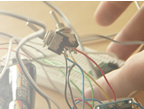
Call for Proposals
CFP: Workshop on Methods and Evaluation in Interdisciplinary Collaboration :: Computer/Human Interaction Conference, 2007 :: San Jose, CA.
Research into new forms of sociality or critical applications of technology often requires unexpected and even disjunctive institutional partnerships. Universities in particular find researchers coming together around common resources or initiatives who share little in the way of methods, values, or politics.
How are researchers and practitioners from Art/Design and the Sciences negotiating and sustaining collaboration today? What differences are preserved in the process, which ones obscured, which transcended? When have quantitative and qualitative methodologies successfully co-mingled, and what do the adherents of each have to learn? Aren't disharmonious partnerships more likely to be formed in a climate of decreased resources and increased pressure to demonstrate "creativity" that produces capital?
This April in San Jose at the annual Computer/Human Interaction (CHI) Conference, we'll be conducting a workshop on these subjects for a day, and we're eager to enlist some more participants. The workshop will take the form of short presentations, large and small-group discussions, with representatives present from many disciplines.
The context, if you're new to CHI, is a professional conference based predominantly in scientific discourse. We've proposed this workshop to CHI as an interdisciplinary team from art and science, and indeed the conference has seen an increasing amount of designers and artists in attendance recently.
We'll be focusing on the following specific questions and topics:
1 - How are projects evaluated by interdisciplinary teams? Which criteria from which constituencies are applied, and to what ends?
2 - What methods of investigation are employed in design processes by teams composed of diverse practitioners? How are ideas iterated?
3 - When is labor divided based on disciplinary difference? At what stages in the process are these differences ignored?
4 - When is evaluation and critique incorporated into process, and how?
If your research or practice has led you to navigation of these or related questions, we invite you to submit proposals for participation and presentation at this Spring's workshop, on April 27th in San Jose. Please see the full CFP for more a more detailed explication of this workshop's goals.
We hope to assemble a group capable of producing applicable methods and useful processes in the pursuit of research that is interdisciplinary by necessity, and perhaps not by choice.
DEADLINE: January 12, 2007
CALL FOR PARTICIPATION: http://orchid.cs.uiuc.edu/HCIandNewMedia/
RELATED LINKS (precedent at University of Illinois, Urbana-Champaign) http://www.art.uiuc.edu/projects/memory
http://www.art.uiuc.edu/projects/mobilemapping
http://orchid.cs.uiuc.edu/people/adamczyk/pvss/
http://orchid.cs.uiuc.edu/
Posted by jo at 12:45 PM | Comments (0)
BBC Radio 3

Soft Message by Blast Theory
Soft Message by Blast Theory :: BBC Radio 3 :: Thursday 7th December, 10.00pm :: Visitors to the Radio 3 website agreed to be rung at any time of the day and night. Matt Adams and Ju Row Farr from Blast Theory interviewed them during a one week period.
The calls catch people drunk at parties, in art galleries and out on the street. We hear them arguing, shouting at their cats or as their friends grab the handset. They open their lives to the listener, they reveal secrets and declarations of love. From the first call to a Mancunian goth pretending to be Romanian we follow these four people through a week in their lives.
The conversations use the intermittent, slow motion nature of the interview to explore the things that are rarely said, rarely heard. And, most importantly, we hear the voices of people alone, confessing, contemplating, opening up.
The programme explores the ways in which radio and telephones lend themselves to a certain kind of intimacy. The programme asks how is the rise of the mobile phone affecting how we talk to one another and what does it mean to talk to strangers?
About Blast Theory: Blast Theory is internationally renowned as one of the most adventurous artist’s groups using interactive media. The group’s work has been shown around the world, most recently in Berlin and Singapore. The group was awarded the Prix Ars Electronica in 2003 and has been nominated for five Interactive BAFTAs.
Posted by jo at 12:39 PM | Comments (0)
ALAVs 2.0

Autonomous Lighter Than Air Vehicles
I've been collaborating with Art Center graduate student Jed Berk on his Autonomous Lighter Than Air Vehicle's project, helping him create the version 2.0, a more connected, bloggy instance of the project.
The ALAVs 2.0 are participatory — you can call them using your mobile phone and engage in a conversation that affects their behavior and your own. They're also using a new design that brings them a step closer to being suitable for DIY, kit-based construction, which is pretty cool.
We'll be installing it at the Art Center Nabi "Connected" event, which runs from December 7 until December 30 in Seoul, South Korea. Here's the blurb:
We are living in the condition of the constant ‘logged-in’ through mobile phone, internet, recently emerged wireless technologies. The exhibition aims to reflect on the current state of connectivity and relationship among people, environment, clusters of information, and objects in the networked condition of everyday life. Works in the exhibition question the very concept of mobility, connectivity, locality, kinship, and physicality whether it is poetic contemplation or piercing critique. 'Connected', as the first exhibition project in align with Mobile Asia initiative, will also include the winners of the international competition held in 2006.
For the time being, the event website is in Korean, so..there's that. It's being translated into English presently! [blogged by Julian Bleecker on USC Interactive Media Division]
Posted by jo at 08:40 AM | Comments (0)
OPENSTUDIO

Interview with Amber Frid-Jimenez and Brent Fitzgerald
"While at SIGGRAPH this September, I had the chance to visit MIT Media Lab a couple of times and stick my head into the labs of the different groups. At the time, the people in John Maeda's Physical Language Workshop were developing something exciting about art and commerce called OPENSTUDIO. At the time it was still closed but since it has recently been opened to the public, it is high time to find out more. Two of the group's current researchers who also worked on the system, Amber Frid-Jimenez and Brent Fitzgerald, are happy to explain.
And – if you find this any interesting, you should also check out PLW-graduate Burak Arikan's (whose name will appear a few times more) latest project A Stock Market In Life as well!" More >> [blogged by Sascha on we-make-money-not-art] OPENSTUDIO AND SHIFTSPACE WILL BE PRESENTED AT UPGRADE! BOSTON ON JANUARY 11, 2007.
Posted by jo at 08:35 AM | Comments (0)
Homeless kid in Second Life
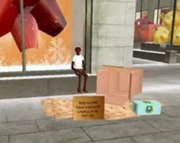
Help a child have a second oportunity in his First Life
Cory Doctorow: Alex sez, "From December 4 on, the Spain-based NGO Mensajeros de la Paz will be present in the virtual world of Second Life as a homeless teenager avatar named MensajerosDeLaPaz Jubilee. The kid hasn't any land nor properties, except for a cardboard box, some newspapers and a sign that says: 'Help a child have a second oportunity in his First Life.'"
"The action is intended to reach out for young people, and ask for help for abandoned and abused children in developing countries in South America and Africa," says Ana de la Calle, a communications representative of the organization.
"We think Second Life and other forms of new technologies can be a great way to connect with young people and make them a little more conscious about the huge population in the real world needing help, and it doesn't cost much to guarantee the future of another human being", says Salvador Dinez, art director of the ad agency ArnoldFuel and one of the designers of the project. The action also includes getting broadcasting online videos of the reaction of the Residents. Link [via Boing Boing]
Posted by jo at 08:30 AM | Comments (0)
Malcolm Gladwell
Plagiarism vs. Inspiration
Two years ago, we posted about Malcolm Gladwell's fascinating New Yorker piece rethinking the concept of plagiarism. After he found out that an article he had written had been plagiarized as part of a play, he went through a series of emotions -- at first, claiming that such plagiarism was "theft." However, he quickly regretted that feeling (and the fact that he dashed off a fax to the author saying exactly that), and slowly began to change the way he felt about plagiarism. He noted that, especially in a case like this, his words had been transformed into something totally different, and that while the words were the same, the product was totally different. He read the play, and found it fascinating, and realized the value of derivative works, even if it borrowed liberally from his own. After that, he couldn't understand why people often get so upset about plagiarism. A couple weeks ago, we noted that plagiarism was incredibly common -- and not everyone agreed what counted as plagiarism. In that article, it was predicted that Google's book scanning and search product would like reveal much more plagiarism, perhaps from some famous authors -- and raised the question of whether or not that was really such a big deal. Not long before that, we pointed to an entire article on plagiarism that was, itself, plagiarized.
Now, John Bennett points us to yet another article on the topic, this time at the NY Times, that talks about the standard reaction to plagiarism may be heightened these days by a culture that is so overly focused on ownership of ideas and the "story" of our lives. The article talks about the rise of reality television and the idea that the story of your life now has much more potential to become a commercial property -- leading many to worry that others might "steal" it somehow. It certainly raises issues about the separation between full on plagiarism, such as copying an entire piece of work, as compared to more "inspirational" plagiarism that is more based on taking a basic idea from someone and creating a derivative work -- perhaps using someone's real-life experiences to make a fictional story seem more true-to-life. Either way, all of these stories help raise questions about what specifically should count as plagiarism, and how serious an issue it really is. [via Techdirt]
Posted by jo at 08:25 AM | Comments (0)
danah boyd on "Creating culture through collective identity performance"

Technologies of Cooperation
My post about danah boyd's November 14 presentation is up at Annenberg Center's DIY Media blog (including a classic photo by Ross Mayfield of danah, Mimi Ito, and Justin Hall):
boyd pointed out that the personal profiles in social networking services provide "moments of representation of identity and digital body." What makes SNSs unique, boyd asserted, are features around friends and networks of friendship that articulate and make visible aspects of interpersonal relationships and social networks that have always existed, but not so visibly. The SNS feature enabling participants to create, display, and edit lists of friends online (e.g., "Top 8" in MySpace, friends lists in Facebook, Friendster, et. al.) presents young people with an opportunity to present their networks of social connections visibly to the world. "In MySpace," boyd noted, ""top 8" is like a high school drama -- who you tell the world your best friend is will get you in horrible trouble offline or online. Who do I put in the top left slot"? MySpace management realized that this feature attracted attention, so they sold as a premium what had been a misfeature in their original design, charging to have more than 8 friends.
Comments on Friendster evolved beyond Friendster-like testimonials. "It became a way of speaking to and about someone and about yourself in the process. Making sure everyone else knows that they are in your list of friends solicits reciprocity. "
This identity-play and social experimentation is a form of DIY media, boyd pointed out, because in social network services, social rituals and norms are signalled by online representations like graphical backgrounds and friend lists, displays of cultural consumption (playlists and fashions) and cultural production (photos, photostreams, and videos). [blogged by howard on Smart Mobs]
Posted by jo at 08:20 AM | Comments (0)
Betablocker
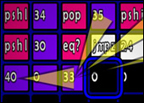
Livecoding and Music Performance
'Livecoding' is the activity of writing a program, or part of it, while it runs. It thus deeply connects algorithmic causality with the perceived outcome and it allows code to be brought into play as an artistic process by deconstructing the temporal dichotomy idea of 'tool' and 'product'. BetaBlocker, project made by software artist Dave Griffiths is a livecoding performance and a piece of software. It's a virtual acid techno machine which is live coded with a gamepad to create code and processes which modify and destroy each other in 256 bytes of memory. The machine's memory and processes are projected and integral to the performance. The software is written in 'fluxus', a small realtime rendering engine that generates animation from sound. The rhythm is a direct result of the process, the number of instructions and jumps.
Livecoders propose a hardline approach to the understanding of software-based art: the code and the process of writing should be visible to the audience, and not hidden inside a 'black box'. However, as it written in TOPLAP Manifesto Draft "It is not necessary for a lay audience to understand the code to appreciate it, much as it is not necessary to know how to play guitar in order to appreciate watching a guitar performance". Livecoding allows the exploration of abstract algorithm spaces as an intellectual improvisation. As an intellectual activity it may be collaborative. And there is something peculiar in BetaBlocker specifically related to live performance. Beta-blockers are in fact cardiac medications quite commonly used by musicians to relax nerves before a concert. By blocking the action of adrenaline and other substances, these drugs mute the sympathetic nervous system, which produces fear in response to any perceived danger. The effect of the drugs does seem magical. Beta-blockers don't merely calm musicians; they actually seem to improve their performances on a technical level. Pointing out this 'live' aspect, the name seems to advocate the 'humanisation of generative music', where code isn't left alone to elaborare its own self-describing soundscape, but it is hacked collectively, chopped up and moulded to make live music." -- Valentina Culatti, Neural.
Posted by jo at 08:19 AM | Comments (0)
Volume

Sculpture that Reacts to Presence
On Friday night I went to the opening of Volume at the V&A Museum, part of the Playstation Season of Culture. Here are my photos.
UVA have now posted a video (waiting for new video)
Created by United Visual Artists and one point six (production company set up by Robert Del Naja [alias 3D] of Massive Attack and Neil Davidge) for the John Madejski Garden.
This is an immersive light and sound sculpture that reacts to presence. Interaction is based on proximity, so without any participants it lies dormant, waiting to be awoken.
Each column contains a matrix of multicoloured LEDs and a speaker. UVA use custom written camera tracking software to watch people moving through the space. As this photo explains, infrared lights are used to illuminate the area, whilst a high mounted camera looks down from above. I counted around 6 different scenes, each with a distinctive style (the video and photos show a few). The sound fitted perfectly, sometimes subtle, othertimes responding to your movements past each column. The garden is fantastic location for work like this, the water puddles creating reflection, shadows around the architecture changing and sounds travelling around the space. The colour gradient fades are beautiful, and the nicest part was the interlude between scenes. The lights slowly die down, then pulsate with white light and sound in anticipation for the next visitors.
On show until 28th Jan 2007. When visiting be prepared to wait in line, particular at peak hours, as only a certain number of people are able to experience the project at once (that was only the opening night).
Here are some gorgeous behind the scenes photos…
Related post: UVA at Transvision [posted by Chris OShea on Pixelsumo]
Posted by jo at 08:15 AM | Comments (0)
Web Science Research Initiative (WSRI)
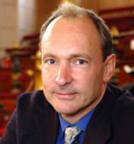
Will Analyze and Shape Web's Evolution
MIT and University of Southampton launch World Wide Web research collaboration :: Initiative will analyze and shape web's evolution :: MIT and the University of Southampton today announced the launch of a long-term research collaboration that aims to produce the fundamental scientific advances necessary to guide the future design and use of the World Wide Web.
The Web Science Research Initiative (WSRI) will generate a research agenda for understanding the scientific, technical and social challenges underlying the growth of the web. Of particular interest is the volume of information on the web that documents more and more aspects of human activity and knowledge. WSRI research projects will weigh such questions as: How do we access information and assess its reliability? By what means may we assure its use complies with social and legal rules? How will we preserve the web over time?
Commenting on the new initiative, Tim Berners-Lee, inventor of the World Wide Web and a founding director of WSRI, said, "As the web celebrates its first decade of widespread use, we still know surprisingly little about how it evolved, and we have only scratched the surface of what could be realized with deeper scientific investigation into its design, operation and impact on society." More >>
Posted by jo at 08:10 AM | Comments (0)
December 06, 2006
Anne Galloway
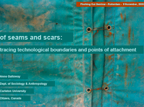
Fleshing out, finally
I've finally gotten around to annotating my presentation from Fleshing Out in Rotterdam last month: Of seams and scars: Tracing technological boundaries and points of attachment (pdf)
Looking at my notes, I see that it conveys some of the breathlessness with which I delivered my presentation, and I'm not sure that's a good thing. But I think there are some good ideas here, and I'm very grateful that I've been given the opportunity to further explore them for another conference in the spring. Anyway, I've received quite a bit of email that I'd like to briefly address by means of an introduction to the content. My presentation was about metaphor and materiality in "wearable interfaces, smart materials and living fabrics." My focus on scars completely ignored literature on the grotesque, although I was particularly interested in what scars actually mark. This is something I'll have to look into more. My focus on seams extended current approaches to ubicomp design by Matthew Chalmers and others by explicitly engaging the political and the ethical. So rather than just focussing on making technological infrastructure more visible, I wanted to start thinking about what kind of "infrastructure" we were talking about, and what kinds of politics and ethics that allowed. My presentation traces my early thinking along these lines and offers questions for further research. As always, comments and questions are welcome.
Posted by jo at 05:05 PM | Comments (0)
JOIN KUNSTRADIO'S
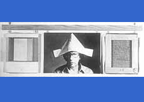
Celebration of Art's Birthday
INVITATION TO JOIN KUNSTRADIO'S CELEBRATION OF ART'S BIRTHDAY 2007! ::Art’s Birthday 2007: Adore and be still ::100 years of radio
Art's Birthday Party is a celebration in memory of Robert Filliou who declared, on January 17 1963, that Art had been born exactly 1,000,000 years ago when someone dropped a dry sponge into a pail of water. After Filliou's death in 1987, some artists began to celebrate Art's Birthday in the spirit of his concept of "The Eternal Network" or "La Fete permanente". The Birthday parties took place in different cities across the world, and artists were asked to bring birthday presents for Art – works that could be shared over the network.
On Christmas 1906, on the other hand, Reginald Aubrey Fessenden undertook the very first radio broadcast of voice and music. Luckily, he had the foresight to time his experiment exactly, its 100th anniversary practically coinciding with the 1,000,044th birthday of Art. We therefore ask you to join Kunstradio's celebration of this stunning fact. We invite you to search your own territories for further firsts in radio history. Premieres of different kinds; the first transmission in stereo, the start of a series of brilliant shows, the first time you listened to the radio, the first time they played 'your' song, the first time you were broadcasting, were on air.
Soundfiles of these broadcasts we ask you to upload to our website.
Feeding on your individual sonic archives and this database of numerous people's special radio moments you can then assemble your own radiophonic versions of our medium's history. These we invite you to stream to our party in Vienna on January 17th, 2007. We will re-mix and further distribute your streams via our live Kunstradio broadcast on the cultural channel of Austrian National Radio Ö1,as well as in our slot on the EBU satellite.
Should you have any questions, please do not hesitate to contact us under kunstradio[at]kunstradio.at
Please feel free to spread the word! This is the party you can bring along as many people as you like!
The short version:
What do we want?
A present. Not for us, for Art's birthday.
Which present?
Your radio's history. Or: Your history of radio.
How?
Streamed, mailed, sent, posted, uploads at
http://kunstradio.at/PROJECTS/AB2007/index.html
Format?
mp3 files, live-streams, images, webcams, ..
When?
January 17th, 2007 from 20:00 - 24:00 CET, 19:00 - 23:00 GMT
Why?
To celebrate.
What?
Art's Birthday.
Posted by jo at 04:34 PM | Comments (0)
Garrett Lynch
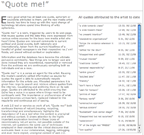
"Quote me!"
"Quote me!" by Garrett Lynch: (please be patient this may take a few moments to load) :: Every good artist has at least one quote, aphorism or soundbite attributed to them, yet the new media artist barely has time to keep up with the rapid change of technology let alone spend time thinking of witty aphorisms.
"Quote me!" is a work, triggered by users to its web page, that reuses quotes and the date they were expressed from various online sources for the busy new media artist who hasn't time. Quotes are relevant comments to current political and social events, both nationally and internationally, taken from the current headlines of a handful of global newspapers via their respective rss / xml feeds, yet placed without context or explanation.
Information and the database have become the ultimate pervasive commodity. New things are no longer said and done instead they are recombined, recompiled or remixed from the archives we are continuously compiling both as individuals and as a race.
"Quote me!" is in a sense an agent for the artist. Reusing the media's carefully edited information as source for quotes the agent is able to automatically recycle information for the artists use. Allocated parameters it is given free reign to search and retrieve others quotes from the internet, republishing and archiving them on its web page. Quotes are attributed to the artist ensuring that (s)he has a voice in a space where things need to be continually said. The importance or profoundness of what is said becomes unimportant, replaced instead by the regularity and continuous act of saying.
A web 2.0 tool or service as work of art, "Quote me!" both continues themes of net.art (reusing, recycling, transforming) and simultaneously highlights the redundancy of it as a tool when the content is unoriginal and without context. It draws attention to the highly important exploration involved in these types of recombinatory net.art works, not possible outside of the internet, yet questions the same use of techniques employed in their creation for the critical discourse that surrounds them in our collaborative, tagging, reblogging and ever more copied, unoriginal content of web 2.0.
a+
gar
Garrett[at]asquare.org
http://www.asquare.org/
Posted by jo at 04:03 PM | Comments (0)
[ A r t i v i s t i c 2 0 0 7 [ [ un.occupied spaces ] ] ]

CALL FOR PARTICIPATION
A r t i v i s t i c 2 0 0 7 [ October :: Montreal ] :: [ [ [ un.occupied spaces ] ] ] < CALL FOR PARTICIPATION >
We are infiltrating all levels of society. Artists, activists, academics, architects, bureaucrats, the homeless, anarchists, first nations, immigrants, doctors, geeks, lawyers, teachers, witches, philosophers, clowns. Artivistic does not only provide a platform for political artists and artistic activists, but partakes in the very movements that work for change. In the pursuit of temporary moments of pleasure, we move towards freedom, for resistance is perpetual and oppression, ever-changing.
We oppose the progression of monolithic thought and work for the development of new and dynamic forms of knowledge, exchange, representation and practices of everyday life. We aim to stimulate the mind, the imagination, and the body. We seek alternative models, portals unto un.occupied spaces. Artistivic moves beyond the moment, becoming a process of contamination through interpersonal dialogue that exceeds the event.
Building on the 2005 generation, Artivistic in 2007 will continue to ask questions that do not leave us thinking we have resolved the issues. We strongly suggest that you answer one, or all, of our questions with a question of your own. Please submit your proposal for participation related (but not restricted) to the following:
< what is indigenous ? >
The very use of the term “indigenous” presupposes a claim to the existence of rights. The right to land. The right of return. The right to self-determination. The right to a life with dignity. In what context does indigenous mean something and how is it represented today? What is the relationship between identity based on place, the land and/or territories and the right to resources? What is indigenous in the context of globalisation, migrations and mobility? (Perhaps the question is not what is indigenous but how is indigenous?)
< what is a natural space ? >
The environment is in a pretty bad shape. Yet, does not typical environmentalism often propose “solutions” which alienate the very people that could make a difference by using a false dichotomy (natural/human-made, natural/artificial, nature/culture) and by perpetuating the myth of a pristine nature? Current strategies often make use of fear and guilt to provoke action, yet will we not be helping our environment in a more efficient way once we let go of our arrogance as humans and start living with and in the world rather than of, and alienated from, the world?
< what is (there) to occupy ? >
The term “occupation” often inspires images of invasion, enclosure and rape. How are spaces and bodies ruled over? What is public space, ultimately? Why do reserves exist? To ask what is occupation is in fact to ask what is left to occupy for occupation is more pervasive than it first appears. At the same time, occupation echoes resistance when it comes to certain forms of appropriation. So how does one occupy appropriation or how can one appropriate occupation?
Your abstract or project description should be no longer than 250 words, your bio 75 words (seriously, we will stop reading after that).
Please also include 50 words on how you will stimulate audience participation (sorry, NO paper reading).
We welcome proposals for : roundtables, workshops, expeditions & walks, interventions, performance, projections, show-and-tells, broadcasts, games, visual arts, media & technology arts, street arts, informal arts, experimental arts, is-it-art arts, etc. and any combination of the above.
We also welcome proposals having to do with personal experience, lessons learned, or future projects that could include other participants of Artivistic (this is a good place to start organising and collaborating).
Deadline : 15 February 2007
Please send your proposals to : participation.artivistic[at]gmail.com
The Autonomous Conference
Artivistic also includes an open-source component. Participants will be able to sign up on the day-of to hold an ad-hoc session that is not in the official program but is fully part of the event. You can prepare in advance, but you don’t need to submit anything.
Co-presentations
Artivistic cannot fulfil its networking and pluralist agenda without collaborating with existing organisations of overlapping mandates. If you are an organisation interested in mutual aid in the context of event planning, please contact us (considerably in advance) with your idea for an event that you would like to organise and present with us : info.artivistic[at]gmail.com
Volunteers
If you want to help us before, during and/or after the event, that would be really nice of you! We need a lot of extra hands with promotion, billeting, set-up, facilitation, cooking, tech, time-keeping, documenting, wrap-up, etc. Please email us at : volunteers.artivistic[at]gmail.com
Travel funding
Unfortunately, we are unable to provide funding for your travel (we are not even getting paid to do this), but will be happy to offer any assistance with your own steps in finding funding. On the other hand, in-house accommodation and food will be provided to all Artivistic participants.
Press
If you want to cover Artivistic, please send us your information by email here: press.artivistic[at]gmail.com
Artivistic is a transdisciplinary three-day gathering on the interPlay between art, information and activism. Artivistic emerges out of the proposition that not only artists should talk about art, academics about theory, and activists about activism. Founded in 2004, the event aims to promote transdisciplinary and intercultural dialogue on activist art beyond critique, to create and facilitate a human network of diverse peoples, and to inspire, proliferate, activate.
General inquiries : info.artivistic[at]gmail.com
Posted by jo at 03:51 PM | Comments (0)
transmediale.07
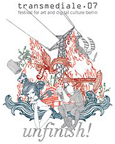
unfinish!
transmediale.07: unfinish! :: Berlin, January 31 - February 4, 2007 :: Akademie der Kuenste :: Berlin, Hanseatenweg 10 :: Open (only during the festival!): Daily 10.00-21.00 hrs :: Admission: 3 Euro (reduced 2 Euro).
Exhibition unfinish! :: The festival's motto relates to artistic works with digital media, in which 'unfinishing' is either the inherent drama of being eternally open-ended, or highlights the possibility of continuous transformation and advancement. In the context of this theme, transmediale.07 explores the conditions of finiteness and presents a range of artistic means and strategies through which seemingly fixed situations can be kept in flux and open to change.
The exhibition of transmediale.07 deals with the motto unfinish!, too, and presents works by David Rokeby (ca), Herwig Weiser (at), Kurt d'Haeseleer (be), Herman Asselberghs (be), Antoine Schmitt (fr), and others, in the Akademie der Kuenste in Berlin (Hanseatenweg).
David Rokeby (ca) - 'Taken' :: Interactive Installation, 2002 :: 'Taken' is an interactive video installation which provides two readings of the activities in the gallery space using surveillance cameras and a double projection. 'Taken' suggests a critical reflection on the methods of observation and classification of people in public spaces. On one side of the projection, gallery visitors are extracted from the ground of the gallery floors and walls and then looped back onto themselves at 20 second intervals. This image stream provides a kind of seething chaos of activity. The other side is a catalogue of the gallery visitors, their heads are zoomed in on and adjectives such as 'unsuspecting', 'complicit' or 'hungry' are attributed to them. These individual head shots are collected as a set of the last 200 visitors and occasionally presented as a matrix.
David Rokeby is a sound and video installation artist based in Toronto, Canada. He studied at the Ontario College of Art where he began to use technology to make pieces that directly engage the human body, or that involve artificial perception systems. His works address issues of digital surveillance, while engaging as well in a critical examination of the differences between human and artificial intelligence.
Herwig Weiser (at) - 'Death Before Disko' :: Installation, 2006 :: Herwig Weiser has built a machine which confronts us with its technical elements in a particularly clear and alienating way. 'Death Before Disko' uses an online data stream from space observation and translates it into simple yet spectacular sound and light events. With the growth of digital technology, users become more and more distant from the physical hardware of their laptop or hi-fi units. 'Death Before Disko' aims to come back to the roots of the hardware, and shows how our relationship towards technology is more often emotional than rational.
Weiser is a interdisciplinary artist in the broadest sense - his long term investigation of the relationship between electronic systems, sound and material environments and the representation of the raw hardware stock that drives these technologies, draws on aesthetic, engineering and programming disciplines, as well as a wider spectrum of scientific principle.
Kurt d'Haeseleer (be) - 'Scripted Emotions' :: Installation, 2005 :: Honourable Mention, transmediale Award 2007 :: 'Scripted Emotions' is a pseudo romantic drama for two tourist binoculars: The installation consists of two binoculars with built-in screens. The spectators can roam with the binoculars through a digital landscape where the nocturnal drama takes its course…
D'Haeseleer is a Belgian video artist who has been associated with the Brussels collective De Filmfabriek, doing the videography for multimedia theatre and dance projects. His work applies state of the art digital montage and production techniques. From seemingly everyday shots he creates organic and associative images.
Herman Asselberghs (be) - 'Proof of Life' :: Video (30'), 2005 :: Nominated for the transmediale Award 2007 :: The video image shows the interior of an empty, open space: the borderline between inside and out is thin. Human presence can only be felt through the adjoining sounds: a male voice recalls horrendous TV-images, a popular disaster movie, a long-term imprisonment or hostage-taking. The radical rift between sound and image reveals a film which needs to be listened to. The described scenes come uncomfortably close to the visitors. A sound movie with empty images which testify to their own, problematic redundancy.
Asselberghs is an artist and an art critic. He writes about audio-visual culture in 'De Tijd', and he teaches in the 'Transmedia' department at Sint-Lukas College in Brussels. He is a founding member of Square vzw and a co-curator of [sonic]square, an ambulant concert series for electronic music. His installations have been shown, among others, by the Centre Georges Pompidou (Paris) and documenta X (Kassel).
Antoine Schmitt (fr) - 'still living' :: Installation, 2006 :: Nominated for the transmediale Award 2007 :: To Schmitt 'still living' inaugurates a new personal artistic language. The project revolves around the concept of 'living' graphics. The graphics are using immediately readable visual codes: pie-charts, bars, curves, etc. But instead of transmitting information about specific developments and alteration, they produce vague and imprecise images. Instead of strict rationality we see metaphors of a type of indecision which is not supposed to exist in our world dominated by precise numbers.
Artist and programmer Antoine Schmitt uses programming as a essential artistic material, to create installations, online exhibitions, performances and CD-Roms, in which he confronts abstract artificial systems with visitors or performers. His work has been shown at the Musee d’Art Moderne de la Ville de Paris, at the Centre Georges Pompidou (Paris), at Sonar (Barcelona), at Ars Electronica (Linz). In 2001 he received an Honorary Mention for his work 'Vexation 1' at transmediale.01.
Other Works
Herwig Turk / Guenter Stoeger (at) - 'setting 04_2006' :: Video-Installation :: The installation 'setting 04_2006' is part of the Blindspot-Project which aims at investigating the interface between science and art. The installation shows the hands of a scientist who performs the movements of four consecutive throughputs of the same experiment - without the necessary instruments. This demonstration of gestures highlights the ambivalence of repetition and the theatricality of scientific experiments. Herwig Turk and Guenter Stoeger are founding members of HILUS (Intermedia Research Project) in Vienna, and of the Blindspot project.
Moon Na (kr) - 'Against God by Water Pistol' :: Video (1'40), 2006 :: The protagonist (the artist herself) is armed with a water pistol and 'shoots' it into the sky on a rainy day. The act of rebelling against god with only a toy is deliberately paradoxical and underlines the implicit failure: A strong gesture of not accepting given rules, including the force of gravity, and a poetical defiance concerning one's place in this world. Moon Na lives and works in Seoul. After her degree in Fine Arts in Fine Arts at Saint Martins College in London, she took part in several group exhibitions, including 'About Beauty' at the Haus der Kulturen der Welt in Berlin and the Gwangju Biennale in Korea.
Aram Bartholl (de) - 'Random Screen' :: Installation, 2006 :: Honourable Mention, transmediale Award 2007 :: 'Random Screen' is a mechanical, thermodynamic screen working without electricity. Conventional tea candles illuminate and generate the changes on the 4x4 pixel screen. This work is part of a series of low-tech screen projects that were originally inspired by the Blinkenlights media facade of the Chaos Computer Club in Berlin. Aram Bartholl comes from Bremen and has lived and worked in Berlin since 1995. He studied architecture at the University of the Arts in Berlin. His graduation thesis as an engineer won him the Browserday competition 2001. He is a permanent member of the 'Urban Media Salon'.
Roman Kirschner (at) - 'Roots' :: Installation, 2006 :: 'Roots' is a dreamlike screen that follows an old Persian image: A bush growing heads... In a green and brownish fluid iron crystals grow steadily... Bubbles ascend like jellyfish… Branches break off and sink to the dark ground… Thick clouds hovering over the scene. Roman Kirschner comes from Vienna, where he studied philosophy and art history. He continues his studies at the Kunsthochschule fuer Medien in Koeln. He co-founded the artists collective //////////fur////.
Christoph Korn (de) - 'Sorge und Kapitalismus' :: Sound and Web Installation, 2005 :: The sound installation confronts precise time data pronounced by one voice with another one offering poetic and associative words. Every hour a time engraving is produced randomly, and is stored in an archive accessible on the website. From this archive the machine reads time engravings, and - at the same time - it selects simple terms describing human existence, phrasing different possibilities of 'Sorge' (care, concern, sorrow) under capitalism. Christoph Korn studied political science and philosophy in Frankfurt/Main. In the Eighties he did political work. In the early Nineties he started working on artistic projects, including composition, radioplays, installations, text and web-based works, dealing with language and time. 'Sorge und Kapitalismus' was commissioned by the German public broadcaster Hessischer Rundfunk.
Richard Chartier / Taylor Deupree (us) - Specification.Fifteen :: Sound piece 2006 :: Honourable mention transmediale Award 2007 :: Sound artists Richard Chartier and Taylor Deupree created 'Specification.Fifteen' as a commission for the Hirshhorn Museum and Sculpture Garden, Washington DC on the occasion of a retrospective exhibition of renowned Japanese photographer Hiroshi Sugimoto. His series of Seascapes inspired Chartier's and Deupree's live piece which premiered in March 2006 in front of the panoramic window of the Museum's Lerner Room as the sun set across the city's skyline. 'Specification.Fifteen' evokes the stillness and opposing yet related spaces of Sugimoto's Seascapes which suggest infinitesimal change under a seemingly uniform surface. Richard Chartier (born 1971), sound and installation artist, explores in his work the interrelationships between the spatial nature of sound, silence, focus, and the act of listening. In 2000 he formed together with Taylor Deupree the recording label LINE, presenting compositions and installations by international sound artists and composers. Taylor Deupree (born 1971) is a sound artist, graphic designer, and photographer residing in New York. Founder of the music labels 12k, LINE and Happy, he devotes his work to the aesthetics of the contemporary and the development of the digital minimalism, often in collaboration with other artists.
transmediale.07
unfinish!
festival for art and digital culture berlin info[at]transmediale.de
Posted by jo at 12:32 PM | Comments (0)
Turbulence New England Initiative II
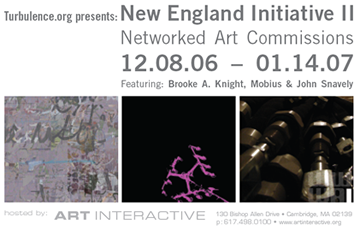
Opening + Performance + Upgrade! Boston
Turbulence New England Initiative II: Brooke A. Knight, Mobius and John Snavely :: WHEN: December 8- January 14, 2007 :: Opening Reception: Friday, December 8, 6-9 pm :: Performance of Variations VII: Fishnet by Mobius Artists Group 7 - 8 pm :: Gallery hours: Saturday & Sunday, 12-6 pm :: WHERE: Art Interactive, 130 Bishop Allen Drive, at the corner of Prospect Street, Cambridge.
Turbulence New England Initiative II :: Turbulence.org's competition for networked, hybrid projects awarded three commissions: "Cell Tagging" by Brooke A. Knight, "Variations VII: FishNet" by Mobius, and "WhoWhatWhenAir" by John Snavely. Jurors of the competition were Julian Bleecker, Michelle Thursz, and Helen Thorington. Turbulence NE Initiative II is supported by Art Interactive, the LEF Foundation, and the Massachusetts Cultural Council, a state agency.
Cell Tagging by Brooke A. Knight
The mobile phone occupies a space that is both connecting and distancing. Seemingly ubiquitous, it has become an increasingly powerful tool, functioning as a phone, PDA, browser, and camera. With "Cell Tagging" it becomes a remote control that allows users to dial, draw, and speak. Cell phone users "graffiti" the sound-space around them, making every place their own.
Variations VII: FishNet by Mobius
In "Variations VII: FishNet," the primary component is an autonomous networked space in which users "fish" among myriad live audio/visual internet feeds. Sources include air traffic controllers, police and fire departments, horse races, and webcams. The project will also make use of live, distributed input from cell phones. FishNet is inspired by John Cage’s Variations VII, a pioneering “art and engineering” performance event from 1966.
WhoWhatWhenAir by John Snavely
An interactive, kinetic sculpture that users can communicate with via a bicycle pump. Next to this direct interaction, a web-based, distant interaction connects the digital with the physical. Coordinated efforts produce unexpected structural choreographies.
![]()
UPGRADE! BOSTON: Turbulence New England Initiative II Artist Talks: Brooke A. Knight, Mobius and John Snavely.
WHEN: December 14, 7 pm
WHERE: Art Interactive, 130 Bishop Allen Drive, at the corner of Prospect Street, Cambridge. Free parking in the lot on the corner or take the T to Central Square and walk 1 block.
Upgrade! Boston is curated by Jo-Anne Green for Turbulence.org in partnership with Art Interactive. It is one of 22 nodes currently active in Upgrade! International, an emerging network of autonomous nodes united by art, technology, and a commitment to bridging cultural divides. If you would like to present your work or get involved, please email jo[at]turbulence.org.
Posted by jo at 11:54 AM | Comments (0)
www.mockingbirdproject.com

Global Soundscape
The Mockingbird Project is a streaming, real-time, non-repeating, self-generating experiment in sound. Mike Skinner loaded in some of his own sounds but the most exciting part to me him is the ability for users to contribute their own small sound clips to the system. His hope is that as word gets out about the site people from around the world will contribute thus making it a truly global soundscape. Enjoy. And pass the word...
In February of 2006, Mike started a series of ambient 8 track/feedback/tape loop sound installation experiments. (The results of these experiments can be heard as the bottom, "foundation" layers of the Mockingbird project). At the same time, Mike also knew the limitations of these experiments: they are finite entropic experiences limited by time/sound sources/tape. He began to envision an online incarnation which, theoretically, can last forever, can run and develop 24 hours a day, and does not depend on the longevity of tape/tape machines or Mike's presence to play them.
In March, Mike brought the online idea to Gunny over lunch at Eva's Health Food in the West Village. Mike saw Gunny as a fitting collaborator, as his interactive expertise, interest in consciousness studies and buddhist meditation, and general demeanor would bring an interesting angle to the project. Stravinsky, Mike said, suggested that music as he knew it died when it could be recorded: no longer was it communal and happening in real-time. Suddenly, you could pause, rewind, remix, repackage, and sell it. The two were inspired by the capability of the digital medium to restore things to their Stravinsky-ian state and to create a vaster communal experience than possible in even the biggest concert hall.
Gunny fell in love with the idea. But he wanted to take the concept of entropy further and allow anyone globally to upload their own sounds into the flow. The resulting unpredictable collisions of sound would be fascinating. What might it suggest if a sound clip of an everyday grocery list played on top of a voicemail declaring passionate love? This made sense to Mike. His interest in the open source biology movement and concepts of entropy in performance, as embodied in the work of Merce Cunningham and John Cage, made this a natural match. Gunny took the project back to Allentium and consulted with Creative Director Mutlu Isik. Mutlu found the idea inspiring. Gunny agreed to finance all costs of design and development. Gunny called Mike who could not believe that this scheme was going to become a reality.
Days and months of conversation ensued about the conceptual implications of technological choices (is it really real-time if the local client machine is the one performing the sound? Should we use Flash Media Server and shared objects or can we do it with client-side Flash, ColdFusion, and SQL Server? What about bandwidth restrictions ruining the real-time effect?). Allentium Interactive Developer Isaac Morales offered a whole unique plan for approaching the technology of the project. In the end, Mutlu's technology model won out. Mutlu's model: scheduled tasks in ColdFusion would compose the music (decide what clips would play at what future times). This gets stored in a SQL server database. When a user logs on, their local Flash file talks to a Coldfusion file which talks to the SQL server which determines which files need to be downloaded and on what server those files reside. Files download. They start to play. Rinse. Repeat. Part of the genius of Mutlu's model is that, like online video games, the only traffic going between the CFMX nervecenter and the PC are the coordinates for the music files. Everything else sits on file servers. This makes the application supremely scalable.
Once programming was finished -- completed entirely by Mutlu and Isaac as the first official project of the Allentium Lab -- Isaac set to work on developing the visual animation for each of the layers. Mutlu integrated that into the design of the home page. Mike and Gunny finally settled on a name for the project -- Mike's idea had been to call it the Mockingbird Project.
And thus the Mockingbird was born.
Posted by jo at 11:47 AM | Comments (0)
Upgrade! Seattle

Caleb Larsen + Brett Walker
Come join us for the December Upgrade! Seattle meeting featuring Caleb Larsen and Brett Walker on Thursday December 14 at 7pm at 911 Media Arts Center.
Upgrade! Seattle is a once a month event for new media artists working in the Seattle area. Every second Thursday of each month Upgrade! Seattle invites artists / curators / thinkers / everyone to gather at 911 Media Arts Center to see and critically discuss new media work. Upgrade! Seattle is hosted by the 911 artists2artists group and is affiliated with the Upgrade! International network. If you are interested in presenting your work, please contact Carrie Bodle (artists2artists[at]911media.org).

Caleb Larsen is a young Seattle based new media and installation artist. He was raised in the northern reaches of Michigan's Upper Peninsula and attended school in Kalamazoo, Michigan. Originally trained as a painter, Larsen attempts to treat technology, not as a gimmick, but as natural addition to the artistic practice. His most recent works loosely revolve around two central concepts: Language and Mapping. Larsen’s current point of inspection involves creating intersections of digital and physical culture by reinterpreting online information and resources from community based websites.
At the present Larsen is working on a suite of projects based on Google News headlines. The headlines are processed in realtime and produce simultaneous outcomes ranging from bizarre video montages to large generated associative word drawings. Using computer programming, Legos, video, dynamic images, and printed text Larsen aims to create an alternate methodology for exploring contemporary culture.
Larsen holds his Bachleor of Fine Arts from Western Michigan University. He has exhibited in New York, Los Angeles, San Francisco, Detroit, Canada, Greece and Romania. He attended the Yale Norfolk Summer School of Art, the School of Visual Art Artist Residency, and most recently the I-Park Artist Residency in Connecticut.

Seattle resident Brett Walker grew up in suburban Portland, Oregon, and became interested in art early in life. Walker attended the Art Institute of Seattle and graduated in 2002 with an Associates degree in Commercial Photography. Shortly after, he moved to Maine and attended the Maine College of Art, where he earned a Bachelor of Fine Arts degree in Photography and graduated in May of 2006.
Walker's work is created as a response to life and the environments in which he lives and interacts. He is interested in duration and repetition, and in re-thinking societal norms and commonly-held truths. Much of his work is done in film and video, as well as in photography and sound. The physicality of these mediums allows Walker space to form a more real and honest artistic practice.
During the past several years, Walker has exhibited work in a variety of locations: the Institute for Contemporary Art in Portland, Maine, the 916 Gallery in Seattle, the Student Gallery at the Maine College of Art, the SPACE Gallery in Portland, Maine, and at an outdoor video screening in Tampa, Florida. He has shown work in a variety of mediums ranging from photographs, to video work, to a custom-built 1977 Puch moped.
Posted by jo at 10:42 AM | Comments (0)
A-WAL
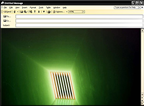
Art Wallpaper Email Exhibition
A-WAL | art wallpaper: adorning the vernacular one email at a time. Email Exhibition Project. A-WAL is a new kind of cultural tool that allows individual users and organizations to upload their own photos and images to be displayed as background wallpaper in their email messages. A-WAL email is web mail, so you can access it from anywhere in the world, and use it the way you would your regular email. However, A-WAL is the only email that allows you to take creative control through featuring your own images. For its pre-launch, A-WAL email was a featured project used by artists participating in Satellite Project, Shanghai Biennial 2006 as an extension of exhibition.
Email Exhibition Project: The A-WAL Email Exhibition is a quarterly curated art project that is two-fold in approach. Each quarter, a curator recognized for having achieved a unique distinction in an area of experimental curatorial practice will construct the Email Exhibition around their own set theme. This will be featured on the A-WAL website as an online exhibition, and the art images are available for use as art wallpaper for A-WAL users as an extension of this project. The A-WAL Email Exhibition is a non-profit public art project, with this edition being sponsored and brought to you in kind by Batteli.
For this quarterly installment, we are pleased to feature independent writer, lecturer, and curator Dr Kathy Battista, who is based in London. Kathy’s abiding interest in and support for experimental art forms and innovative practice has been displayed through her past involvement and work with esteemed organizations such as Artangel, Tate Modern, and the Serpentine Gallery. Kathy has regularly contributed to Contemporary, Frieze, Third Text, and Art Monthly amongst other publications, is an editor of Art & Architecture Journal, and has recently authored the forthcoming book Women’s Work: Feminist Artists in 1970s London (I B Tauris, 2007), resulting from her doctoral research re-considering the work of feminist artists in 1970s London and their role in the context of perfomative practice and alternative spaces. While at Artangel, she founded and was Head of the Interaction Programme, a series of contextual projects based around Artangel’s project s in unusual places, working with artists including Steve McQueen, Richard Wentworth, Matthew Barney, Janet Cardiff, Ilya & Emilia Kabakov and Tony Oursler.
The artists featured in this exhibition include: Daniel Jackson, Delaney Martin, Jamie Robinson, Sans Facon (Tristan Surtees & Charles Blanc), Dallas Seitz, Krisdy Schindler and Heather Sparks.
Excerpts from the writings for the Online Exhibition Project: The development of the World Wide Web is the most important technological advancement of our time. It has revolutionized the way we work, communicate, shop and live. The immediate transfer and dissemination of information has resulted in a truly globalized world, for better or for worse. It has also had a profound effect on art practice. The twentieth century notion of the white cube gallery space has given way to an infinitely expanded notion of digital display, where art can be seen anywhere in the world at any time.
The A-WAL project engages with the computer and in particular email as a site for artistic production. Using what has now become a vernacular form—email —A-WAL merges the everyday with the artistic. The selection of artists for this first A-WAL exhibition explores themes around patterning and wallpaper. The group of international artists shown here engage with these ideas through various media.
The Chinese are credited with first developing wallpaper around 200 BC, when they began to cover domestic walls with rice paper. French courts, such as that of Louis XIV, would commission artists to create paper for wall panels that could be moved when travelling between various residences. In England during the arts and crafts movement William Morris elevated wallpaper to new artistic heights. His designs, which played with a tenuous balance between abstraction and natural form, are still in production today. Morris broke with the Victorian ideal of illusionistic wallpaper, and devised designs that flattened out and enhanced the two-dimensionality of the wall. This is akin to the screensavers and wallpapers that are ubiquitous in our culture today: from computer screens to mobile phones two-dimensional images are at the center of our existence.
One of the main characteristics of wallpaper since the late nineteenth century is a repeat pattern that can be joined to make a coherent whole. The artists featured in this A-WAL project each work with a pattern that can be repeated in this way. This patterning is also a nod to the dots and zeros that make up computer programming. The A-WAL artists use various media—from painting and drawing to photography, video and computer rendering—to create their images.
The artists in this incarnation of A-WAL take the notion of patterning and wallpaper into the twenty-first century. Regardless of medium—the resulting patterns play with notions of surface [...].
- Taken in part by Kathy Battista's writings for the A-WAL Online Exhibition.
A-WAL is proud to enable this new form of techno-vernacular display, and would like to thank the artists curated who boldly embrace new forms of installation practice. A-WAL is committed to supporting public art projects through the use of this medium to enable an exhibition, or for use as an extension of a physical exhibition. Inquiries for such special projects can be sent to artprojects[at]A-WAL.com, although anyone can register for their own personal or organization A-WAL email account on the website.
A-WAL wishes you interesting and artful email messages.
Posted by jo at 10:13 AM | Comments (0)
r4wB!t5 micro.Fest PRESENTS

0P3NFR4M3W0RK
[ (A) r4wB!t5 micro.Fest PRESENTS ] ][]P3|\|.|=r@/\/\3.\/\/()r|<][ AKA 0P3NFR4M3W0RK AKA Open Frame Work :: [ @ The Art Gallery of Knoxville TN .US opening 2007.01.05 ] [ as a component of the Distribution Religion Exhibition ] [ 1rst DEADLINE == 2007.01.04 ] [ 2nd DEADLINE == 2007.02.04 ]
][]P3|\|.|=r@/\/\3.\/\/()r|<][ AKA 0P3NFR4M3W0RK AKA Open Frame Work is an open archive of dirty new media + digital still art exhibited as an aspect of the 2007.01.05 (A) r4wB!t5 micro.Fest to be held @ The Art Gallery of Knoxville in the Distribution Religion exhibition. 0P3NFR4M3W0RK is an open DIY digital art exhibition ware every artist will receive equal time (length of event divided by number of participants) in the display of their digital art [works/worlds]. ][] P3|\|.|=r@/\/\3.\/\/()r|<][ is potentially the interweb's, dataspheres' ++ world's largest open exhibition of digital art. all work submitted w/the following conditions will be displayed in the The Art Gallery of Knoxville + will be listed as work shown in the 2007.01.05 (A) r4WB1t5 micro.Fest. the current Open Frame Work will include all materials submitted to the previous instances, i.e. from the 2005.08.27 (A) r4WB1t5 micro.Fest @ Alterspace in Chicago IL .US + will be including in the ongoing (A) r4WB1t5 micro.Fest.
[ INSTALL YOUR DIGITAL IMAGE ART DATA ]
send images via email, attaching your *.ANSII, *.BMP, *.BUM, *.CLP, *.CUR, *.EPS, *.GIF, *.ICNS, *.ICO, *.JIF, *.JPG, *.JP2, *.PDB, *.PDF, *.PICT, *.PSD, *.PNG, *.RAW, *.RSRC, *.SVG, *.SGI, *.SUN, *.TIFF, *.YUV, *.X-FACE, etc files to:
install[at]0p3nfr4m3w0rk.org
or via Flickr, by uploading + then tagging your images w/the "0P3NFR4M3W0RK" tag:
http://www.flickr.com/photos/tags/0P3NFR4M3W0RK
or via bookmarking the images that are already online using del.icio.us + then tagging your images w/the "0P3NFR4M3W0RK" tag:
http://del.icio.us/tag/0P3NFR4M3W0RK
or by uploading your data directly:
http://0p3nfr4m3w0rk.org/install
(A) r4wB!t5 organizers will harvest files from these interwebbed locations 11:59 PM on 2007.01.0+ EVERY IMAGE (AKA ALL DATA SUBMITTED!) WILL BE SHOWN IN THIS EVENT.
--=-=-=--=-=-=--
-= 2007.01.05 =-
--=-=-=--=-=-=--
(A) 2007.01.05 r4WB1t5 micro.Fest in Knoxville TN .US is an open collaborative aspect of the "Distribution Religion" exhibition at The Art Gallery of Knoxville. (A) 2007.01.05 r4WB1t5 micro.Fest is being organized around themes of sharing, systems of {exchange|distribution} + creating crossroads of digital punk, blues musics + freak folktronics as forms of protest + resistance to current socio-economic situations + political contingencies.
on the night of 2007.01.05 The Distribution Religion exhibition will open at The Art Gallery of Knoxville + will include the r4WB1t5 projects Open Frame Work + Radio Play Back Boom Boxor. these ongoing components of (A) r4WB1t5 micro.Fest feature artists from around the earth-planet.
simultaneously, (A) 2007.01.05 r4WB1t5 micro.Fest will occur @ The Pilot Light in Knoxville TN .US, across the tracks from The Art Gallery of Knoxville. the (A) 2007.01.05 r4WB1t5 micro.Fest @ The Pilot Light will feature a folksonema screening, open source artware distribution + realtime audio + video performances by r4WB1t5 participants from Knoxville, Chicago + beyond. a live data stream will also connect these physical-virtual spacestations across the global wide interweb.
=- ---= --= '--' =-- =--- -=
=- (A) r4WB1t5 micro.Fest -=
=- ---= --= '--' =-- =--- -=
(A) r4WB1t5 micro.Fests are international, decentralized, self-organized + independent instantiated situations of raw bits of digital art + dirty new media. (A) r4WB1t5 micro.Fest is itself an open platform or framework for creating these events in alternative + conversational contexts such as bars, basements, art spaces, apartments, galleries, etc... (A) r4WB1t5 micro.Fest extends out of + feeds back into DaDaist, Situationist, Fluxist, punk, digital art + New Media theories + practices... (A) r4WB1t5 micro.Fests are always free + open collaborative projects, available to anyone interested in self-organizing Digital Arts + dirty New Media.
=--=-=--=-=--=
= FOLKSONEMA =
=--=-=--=-=--=
folksonema is a bi-weekly screening evnt @ the flowershop (2159 w 21st pl, chicago il), inspired by the `][]P3|\|.|=r@/\/\3.\/\/()r|<][ (aka open frame work)` program developed by jon.satrom for r4wb1t5 2005.08.27. every two weeks, jake elliott propagates information about a certain tag to use (ie “ravepartyinaspaceship” or “thatrobotatemysandwich”) on sites like youtube, del.icio.us, flickr, etc. for each screening, jake elliott scrapes the tagged media (images, mp3’s, exe’s, videos, web pages, txt’s, etc.) from those sites && screens them in the greenhouse of the flowershop, a space inhabited by various artists, projects && public initiatives.
folksonema == folk + taxonomy + cinema
http://folksonema.nothingistrueeverythingispermitted.com
http://www.flowerglass.net
--=-=-=---=-=-=---=-=-=--=-=-=--
= THE ART GALLERY OF KNOXVILLE =
--=-=-=---=-=-=---=-=-=--=-=-=--
The Art Gallery of Knoxville is a new experimental space, dedicated to the discussion of emerging Art. Located in Knoxville Tennessee, the Gallery coordinates the exhibition + publication of work in all media. Project proposals may extend from all disciplines. Regular performances + events include avant-garde + experimental music, video screenings (every Wednesday night at 7 PM), + public discussions of contemporary artists. Exhibits change monthly. Open Submissions Accepted.
The Art Gallery of Knoxville
317 N Gay St
Knoxville, TN 37917
Gallery Hours: Wednesday - Sunday (2 PM - 9 PM)
http://www.theartgalleryofknoxville.com
--=-=-=-=-=-=--
= PILOT LIGHT =
--=-=-=-=-=-=--
since may 2000: knoxville's home for experimental and independent musics, film, and performance. we've hosted well over 1500 different local, national, and international bands (many of them multiple times) since inception. all volunteer. we are bringing it here for you. come find a new favorite band.
Pilot Light
106 E Jackson Ave - Knoxville, TN 37915
865.524.8188
http://www.thepilotlight.com
http://www.myspace.com/pilotlightclub
Posted by jo at 09:19 AM | Comments (0)
Art Center Nabi
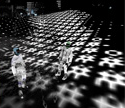
Connected
Connected :: Exhibition: From Thursday Dec. 7 - Dec. 30, 2006 :: Opening: Thursday December 7, 2006 :: Artist Talk: Friday Dec. 8, 2006 from 5 pm :: Workspace Unlimited at "Connected" exhibition Art Center Nabi - Seoul, South-Korea.
Art Center Nabi organizes the exhibition Connected. Works of Thomas Soetens and Kora Van den Bulcke, Jed Berk & Julian Bleecker, Ann Poochareon & Mark Argo, Ubermorgen.com, Daniel Sauter, Sara Kolster, Derek Holzer & Marc Boon will be presented in the gallery space of the Art Center Nabi. On Friday Dec. 8 the artists will explain their work to the public. For this occasion we have made an additional level to the Common Grounds Network. People from Korea will be entering Common grounds from this level. People from Belgium and Montreal can meet and have a chat with the Korean visitors in Implant, Devmap or Extension from the terminals installed at the Society for Art & Technology in Montreal and the Vooruit Art Center in Belgium.
Posted by jo at 09:07 AM | Comments (0)
December 05, 2006
This is the Public Domain
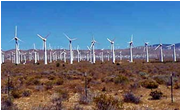
A Viable Practical Framework for Common Land
The CCA Wattis Institute for Contemporary Arts presents: This is the Public Domain :: 7pm December 5th :: Timken Lecture Theater, California College of Arts, 1111 8th Street, SF, CA 94107 ::Free admission.
A panel discussion organized by San Francisco-based artist Amy Balkin to debate and explore ways to achieve a viable practical framework for common land in the 21st century. With Keith Aoki, UC Oregon law professor and co-author of, among other works, the comic book 'Bound By Law - Tales From the Public Domain'. Iain Boal, Director of the Environmental Politics Colloquium at the Institute of International Studies, UC Berkeley, and co-editor of the recent book 'Afflicted Powers'. Brady Moss, senior project associate for the Trust for Public Land, a national, nonprofit, land conservation organization. Ramon Sender, writer, activist and participant in the Morning Star Ranch open land experiment of the early seventies.
Amy Balkin's art practice combines cross-disciplinary research and social critique with a search for unrealized possibilities outside conventional systems. Her ongoing project This is the Public Domain is an effort to create a permanent international commons from 2.5 acres of land purchased near Tehachapi, California.
As part of the Wattis Institute's exhibition Radical Software, Balkin has organised a public conversation between artists, legal experts, and people who have been engaged personally and politically with open land and commoning, exploring the search for a real-world framework for —with the aim of proposing a solution that the artist will then implement.
Balkin's recent projects include Invisible-5, a collaborative environmental justice audio tour of the I-5 corridor between San Francisco and Los Angeles, and Public Smog.
For more information, call: 415.551.9251
Posted by jo at 03:41 PM | Comments (0)
WRO 07 Competition
![]()
12th International Media Art Biennale
12th International Media Art Biennale WRO 07 Competition :: 16 - 20 May 2007, Wroclaw, Poland.
WRO Foundation for Media Art in Wroclaw/Poland, announces an international competition open to any work created using electronic media techniques, exploring innovative forms of artistic communication. The competition welcomes creators of artistic projects of diverse forms such as screenings (video art, computer animation), installations, objects, performances, multimedia concerts and network projects from all over the world.
The main prize is 5000. The deadline date for entry submission is 15.02.2007.
Presentation of shortlisted works and the international jury's announcement of the competition results will take place during public screening at the WRO 07 Biennale. The competition regulations and entry form are available in downloadable format at http://wro07.wrocenter.pl. Requests to receive the regulations and entry form by post can be made at print[at]wrocenter.pl.
Posted by jo at 03:26 PM | Comments (0)
Climate Commons:
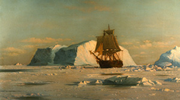
A Networked Conversation About Climate Change, Sustainability, and the Arctic
Climate Commons: a networked conversation about climate change, sustainability, and the Arctic :: Developed by Jane D. Marsching with Matthew Shanley :: November 27 2006 - February 28, 2007. Please join the conversation by reading the posts and comments and then logging in to respond with your own comments.
Climate Commons is a conversation between thirteen people who focus on climate change, sustainability, and the Arctic in a wide range of disciplines including a glaciologist, an architect, a journalist, and a comedian. Each author contributes weekly posts about their work, inspirations, discoveries, or questions. Readers can join the conversation by clicking on the comments hex icon and choosing a hex cell to respond to any particular post. As an interdisciplinary collaborative hybrid art/research project, Climate Commons seeks to point to the multiplicity of voices behind the complex environmental concerns and to create connections/analogies/discussion across disciplines, economies, and ideologies.
Core participants:
Sally Bingham, Episcopal Priest
Jock Gill, Carbon Neutral by 2020
Mitchell Joachim, Architect
Jane D. Marsching, Artist
Larry Merculieff, Alaska Native Science Commission
Robert Newman, Comedian
Matt Nolan, Glaciologist
James Overland, Climatologist
Sarah Rich, WorldChanging
Russell Potter, Historian
Andrew Revkin, Environmental Journalist, New York Times
Matthew Shanley, Artist/Programmer
Juanita Urban-Rich, Windows Around the World
Climate Commons is part of a larger project, Arctic LIstening Post, a series of interdisciplinary, collaborative hybrid art research works in digital technologies by Jane D. Marsching. On exhibit at the Institute of Contemporary Art Boston, 12/10/06-3/11/07.
A project of Creative Capital with the generous support of the LEF Foundation Contemporary Work Fund.
Posted by jo at 03:01 PM | Comments (0)
thresholds 34: portability
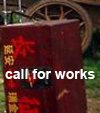
call for submissions
thresholds 34: portability :: call for submissions :: thresholds is the bi-annual critical journal of architecture, art and media culture produced by editors in the Department of Architecture of the Massachusetts Institute of Technology.
On July 1, 1979, the Sony Walkman TPS-L2 went on sale in Japan, ushering in an age of mobile privatization. Since then, the portability of cultural and informational content has become ever more portable: television consumers of today can timeshift with the TiVo and placeshift with the Slingbox, reminding us that TV, like fast food, need not be different everywhere.
More object-oriented than the concept of mobility, design for portability aims to maintain the coherent function, appearance, and identity of the thing transported: be it a lipstick carried in a purse, software moved to a competing platform, health care benefits taken to another job, or a Star Trek officer who needs to be beamed down to the planet. Thus, the pursuit of the thing's fidelity after transport and transfer is also a quest of translatability, enabling exchange and reciprocity in an age of translocational identity. Just as mobility and immobility encapsulate modern social dilemmas, portability encapsulates all things in transition between times and places, and the desire to make solid, truthful, and durable, all that melts into air. We are as much mobile agents, as we are porters of weighty baggage.
thresholds 34 invites contributions examining the aesthetic, architectural, political and technological uses of portability. We invite critical perspectives that explore these issues in a variety of media, including essays, projects, proposals, policies, and models. Points of inquiry can include, but need not be limited to, portable objects, spaces of portage, systems of transport and transfer, processes of translatability, markets of import and export, and designs on, and for, a portable life.
Submissions from fields other than art and architecture are strongly encouraged. Essays are limited to 2500 words. A digital copy of the text is required as well as 300 dpi digital files of all images. Please include a two-sentence biography of each author. Thresholds aims to print material not previously published.
Submissions are due February 15, 2007. Please send all materials and correspondence to thresh[at]mit.edu or to:
Winnie Wong, Editor
thresholds
MIT Department of Architecture
Room 7-337
77 Massachusetts Ave.
Cambridge, MA 02139
Posted by jo at 02:53 PM | Comments (0)
Visual Music Marathon
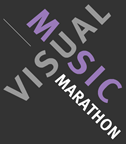
Call for Submissions
Northeastern University is pleased to announce a call for work for the 2007 Visual Music Marathon, to be held on April 28th, 2007 as part of the Boston Cyberarts Festival. The Marathon will include screenings of new and historic works that reflect the theme of the event and a live video component. Approximately thirty minutes of programming will be selected for national cablecast on the Harmony Channel, available to subscribers of digital cable on the Comcast and Cox networks.
The Visual Music Marathon will be held in the Raytheon Amphitheatre of Northeastern University, Boston and is produced in conjunction with the Northeastern Multimedia Studies and Music Technology programs, the Departments of Music and Visual Arts, and the Harmony Channel.
Visual Music: Fine art animation, video or film in which the visual elements are informed by musical processes. Deadline: (postmarked) January 22nd, 2007.
Posted by jo at 10:18 AM | Comments (0)
Neil Salley's
![]()
Musée Patamécanique
Neil Salley, Musée Patamécanique :: Exhibit / Installation :: by appointment (BRISTOL, Rhode Island, USA)
"'Patamechanics is a method of discovering/manifesting artifacts' much like those of the ancient Wonder-rooms of old, 'which symbolically attribute their properties described by their virtuality to their lineaments.' A Patamechanical artifact or device is displayed with the intention of validating the existence of a realm or entity 'supplementary to this one; or, less ambitiously, describes a universe which can be - and perhaps should be - envisaged in the place of the traditional one.' The primary goal of the Musée Patamécanique is to explore the meaning and possibilities of Patamechanics [...]" [1]
You are invited on a curatorial tour of Musée Patamécanique, a hybrid institution; part museum, part laboratory, part carnival for the senses.
Le Musee is open thru March of 2007 on Tuesday, Wednesday, Thursday and Friday evenings between 6:30 P.M. and 9:00 P.M. The exact location of the exhibit is revealed only after you have scheduled your tour, however we can tell you that Le Musée is located in Bristol R.I.
If you would like to read a recent review of Musée Patamécanique, please follow this link.
If you would like to learn more about the institution or to schedule your tour please follow this link: http://museepata.org/
[1] Taken from the website of Le Musée Patamécanique. Please refer to this site for related footnotes and quote attributions.
Posted by jo at 10:12 AM | Comments (0)
December 01, 2006
Eye or Ear:

Walter Benjamin on Optical and Acoustical Media
UCSB Conference Explores the Work of Essayist, Philosopher Walter Benjamin
Santa Barbara, Calif.) – Five scholars from the United States and Germany will meet to discuss the work of the early 20th-century philosopher, essayist, and translator Walter Benjamin at a one-day conference at UC Santa Barbara on Dec. 1. The event, "Eye or Ear: Walter Benjamin on Optical and Acoustical Media," is free and the public is invited to attend any or all five lectures.
(Media-Newswire.com) - Organized by the Department of Germanic, Slavic, and Semitic Studies and co-sponsored by the Program of Comparative Literature and the Consortium for Literature, Theory and Culture, the conference will investigate the relationship between three aspects of Benjamin's work: his language theory, media theory, and contributions to radio programming of the time. It begins at 10:30 a.m. in the McCune Conference Room, Humanities & Social Sciences Building 6020. A reception at 5:15 p.m. follows the final lecture.
Speakers include Wolfgang Hagen, professor of German at Humboldt University in Berlin; Rob Ryder, doctoral candidate in German at Northwestern University; Wolf Kittler, professor of German and comparative literature at UCSB; Michael Levine, professor of German at Rutgers University; and Bettine Menke, professor of German and comparative literature at the Erfurt University in Germany and currently a visiting professor at UCSB.
Menke's residency at UCSB is supported by a grant from the Max Kade Foundation, which promotes the study of both German and German-American history and works to increase understanding between the people of Germany and the United States. The foundation funds diverse educational initiatives in both Germany and the United States.
"For the first time we have a Kade visiting professor at UCSB and one of her areas of specialty is Walter Benjamin and acoustics," Elisabeth Weber, professor and chair of German, Slavic, and Semitic Studies at UCSB, said of Menke. "Since this is an unexplored field in Benjamin's scholarship, we decided to have a conference on it."
Benjamin is considered one of the most influential voices of 20th-century European thought, Weber added, noting his work has contributed to literary studies, film and media theory, and translation studies around the world.
The first lecture begins at 10:45 a.m. and features Hagen speaking from Germany via the Internet on the topic of Benjamin's silent work for the German radio. Ryder will follow at 11:30 a.m. with "Shell-Shock: Sounding the Acoustic Unconscious," and Kittler will begin the afternoon session with "Benjamin's Aura: Breathing, Seeing, Listening" at 2 p.m.
Levine will speak on "Eavesdropping on Tradition: Benjamin's Reading of Kafka" at 2:45 p.m., and Menke will present the final lecture, "Echo( es ): The Evanescent Presence of Sound in Benjamin's Texts," at 3:30.
Posted by jo at 02:36 PM | Comments (0)

